#it's less 'relevant' than centuries or my songs (the other 2 they played)
Text
YALL FOB DROPPED THAT BEDAZZLED MAGIC 8 BALL + THE NEW MV HINT WHILE I WAS AT A HOCKEY GAME WHERE THE DJ PLAYED FALL OUT BOY 3 DIFFERENT TIMES I WAS LOSING MY SHIT SDFJSKHFDJSGH
#THEY PLAYED THNKS FR TH MMRS TOO!! I WAS LIKE. SOMEONES A FAN??!?! ASDHFKJSDGH#i mean yes it was a single/hit but stiLL. you gotta know that one to think of it for djing!!!!!1 sorta kinda yknoW#it's less 'relevant' than centuries or my songs (the other 2 they played)#fall out boy
11 notes
·
View notes
Note
I’m asleep as I send this so sorry if it’s unintelligible— Nita nirvana released a bubblegum pop song, named something like ‘baby baby you’re my baby’. Stamping stone 8 year old niece loves her. Was she in a band and had other songs? Or in some way associated with a tv show or other type of media ‘Britney from Mickey Mouse club’ style? Just curious about her career.
Nita wanted to be an actress at a very young age, and her parents were more than happy to support her dreams. Nita, her dad, Todd and mom, Sirena Nirvana, maintained a household in Los Angeles, so it was easy for them to take their daughter to random casting calls. She did quite well, too. As a kid, she landed a few cereal commercials and got plenty of callbacks on "cute kid" bit parts.
Her career really took off right at the turn of the century, and at 14, she was the breakout figure in the pop group, You, Me, Her, Me Again and Her. Though she never became a regular cast member on The Mickey Mouse Club, Disney had their claws in her pretty directly after she went solo.
Now, you're going to have to clarify here, Anon. Because "Baby, Baby, Oh Baby, My Baby, Baby", her first big hit in the US, is often confused with the song you're referencing in your question, "Baby, Baby, You're My Baby"... which was almost featured in the cancelled Disney Animated adaptation of Pop Goes the Weasel, where Nita was slated to play "Fatima the Ferret" before the project was shelved:

Nita was able to ride the pop wave for a few years, but as interest in that area died down shortly after the 2000s, she had a harder time staying relevant. When Charles called her up for the Baen-Shee gig, I imagine she was at a point where she was absolutely ready for a big shift.
Nita has gone through a lot of ups and has only recently encountered downs in her career. I'm really looking forward to showing you all where she's landed, recently, too. Essentially, someone whose star shone quite brightly as a kid can find herself with a whole new set of challenges as she gets older and the media machine that once adored her becomes less welcoming (and keep in mind, Nita's only in her mid-20's at the point when Dethkomic is happening).
Good question, OP. Dethkomic 2 will delve into it even further, I promise. I do hope you enjoy the ride. :) Oh... and that's only next week away, already..!
#mtl#mtl oc#fatima the ferret#disney's pop goes the weasel#it's too cute tho seriously#dethkomic lore#answered
13 notes
·
View notes
Text
Paris Haute Couture Week S/S 2020 Plus a Little Jacquemus: Okay, Dior DID Suck (Part 1/2)
Hi to anyone reading,
Oh my god. I completely forgot there was also 2 haute couture weeks. I FEEL SO OVERWHELMED. Here I was getting all geared up for the F/W 2020 shows and suddenly it’s Jean Paul Gaultier’s last show and everybody’s (predictably) buzzing about the Jacquemus collection. I can’t keep up. But Haute Couture week is a lot less intense than the RTW shows so I suppose I should be enjoying this relative peace whilst I can.
I remember my last post about Haute Couture week opened with me defending Maria Grazia from the wrath of the internet; if Jacquemus is social media’s Lord and Saviour, this woman is the Antichrist. She’s Michael Langdon minus the dramatic flair. But the thing is, I genuinely really liked the Dior collection last time. Maybe because I was newer to the discipline of scouring Vogue Runway, but the lack of originality didn’t bother me; it was still something I’d die to wear, gothic yet delicate and relevant for 2019.
That being said, this time round, I have to open by doing the exact opposite and concurring: this time round, Dior was in fact, utter shit.
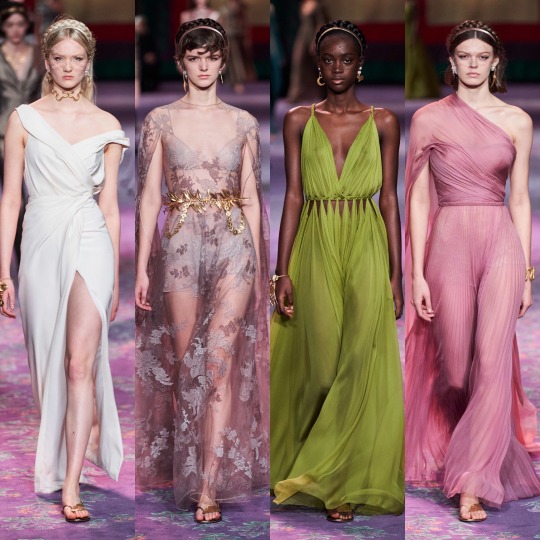
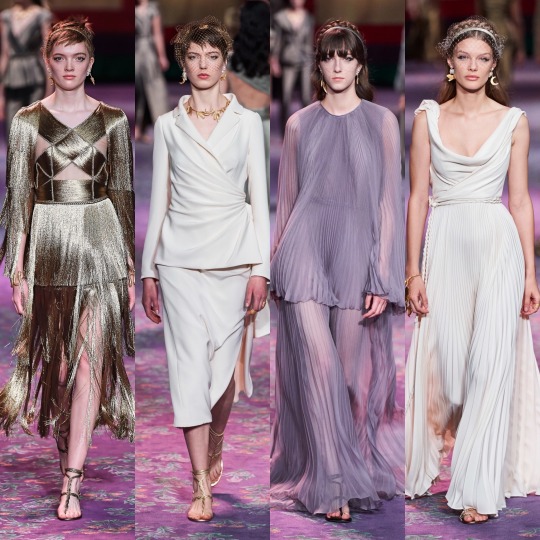
I feel mean saying it but...really? These were the slightly more salvageable outfits and my favourite of the bunch, and to be honest they don’t really capture the full extent of how outdated this collection was to me. I know that the concept behind the show was this idea of the divine feminine but Greek Goddess has been done SO many times. If you’re gonna go down that route, you have to bring something new, elevate it in some way. It can’t be THIS generic.
I can’t believe that in 2020 we’re really seeing plaited hairbands. The individual dresses are basic, but not so much the problem as the styling; they look like outfits I would’ve put together back in 2012. That’s not an exaggeration. I think even 2013 me would appreciate that you need to make things a little twisty.
The colour scheme is pretty, don’t get me wrong, and I like the cowl necks-the white dresses are the highlights. I think the concept of this collection was conceived with all the best intentions. But as a designer you need to take risks and I don’t see one single risk here; there isn’t anything that wouldn’t already be sold in your local H&M. Dior is such an established brand, Maria Grazia has room to do whatever she wants. And yet it just comes across like she’s out of ideas.
You’ve got to look at a designer like Ulyana Sergeenko:
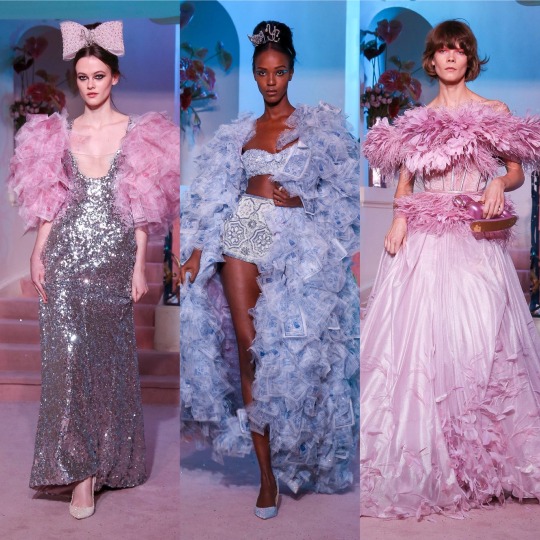
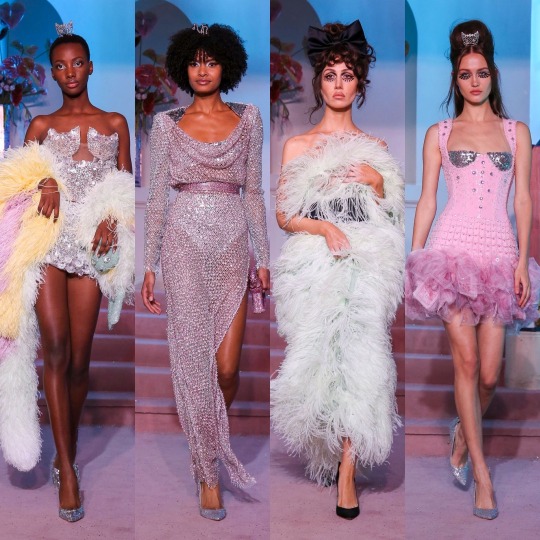

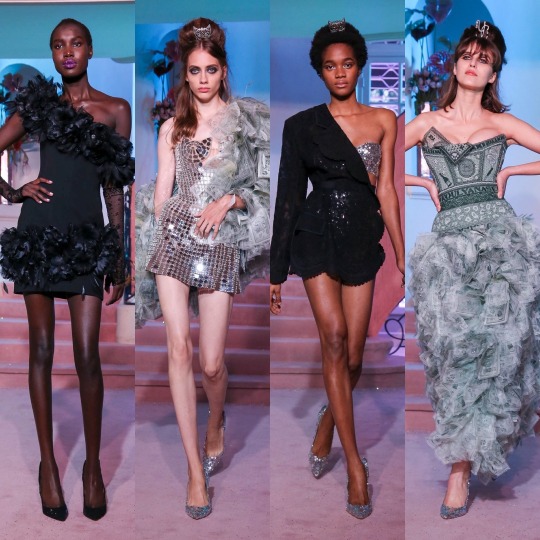

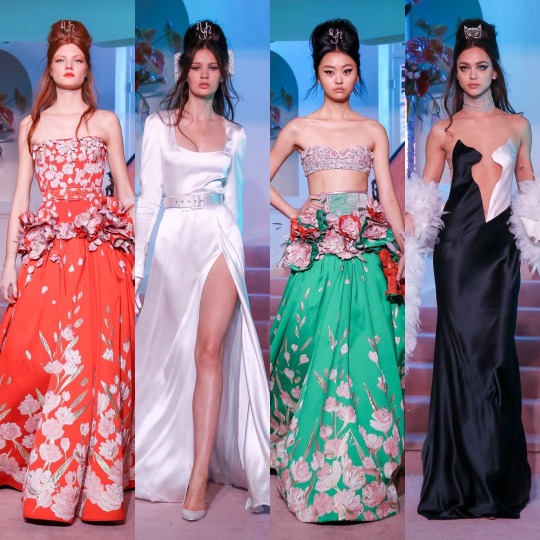
When I say elevated (but still in the vein of wearable), I mean something like this. To be completely honest, I hadn’t heard of Ulyana Sergeenko until I saw shots of this show on Twitter. But what a perfect mix of kitsch and glamour. The influences are clear: Priscilla Presley, Barbie, Jackie O, Valley of the Dolls, the rich stay-at-home wife of the 60s, the Alessandra Rich/Scream Queens-esque sorority girl, Paris fucking Hilton. It’s exaggerated and it’s tongue in cheek with total grounds to call it trashy-there’s a corset resembling a Benjamin Franklin, ffs-but it’s all done with a wink and a nudge. And in all honesty, I just think it’s beautiful. Can you imagine Frances O’Sullivan (@Beautyspock on IG) in one of these looks? It would be worthy of the Rose McGowan cultural reset meme ten times over.
Everything is feline, from the very literal cat silhouettes and cat headed boa, to the makeup and the hair clips. It reminds me of the last RTW Ralph and Russo show but with even more attention to detail. And look at the STAGE. If this collection were a song, it’d be Disco Tits by Tove Lo. And no, I’m not just saying that because one of the dresses actually does feature a (cat shaped) disco tit. Like these are the clothes I dreamed of putting my Bratz dolls, and for null I’m sure, myself in. Absolute perfection. Plus, I’ve loved Coco Rocha since she was on The Face with Naomi Campbell; she is, after all, to thank for the iconic “check your lipstick before you come for me” line. Girl is really the martyr for all purple lipstick lovers, cut down in her prime by a pissed-off Naomi.
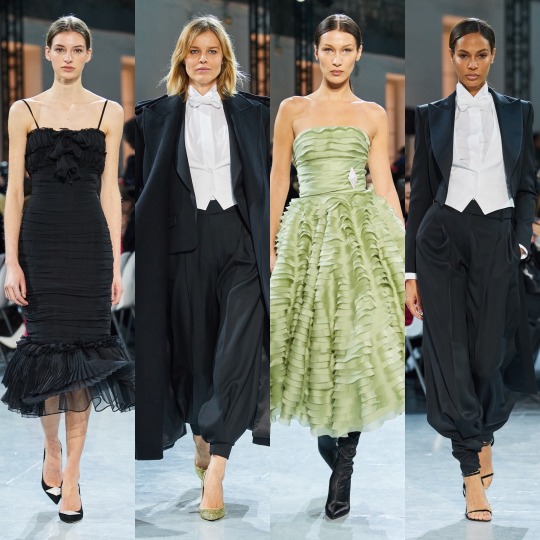

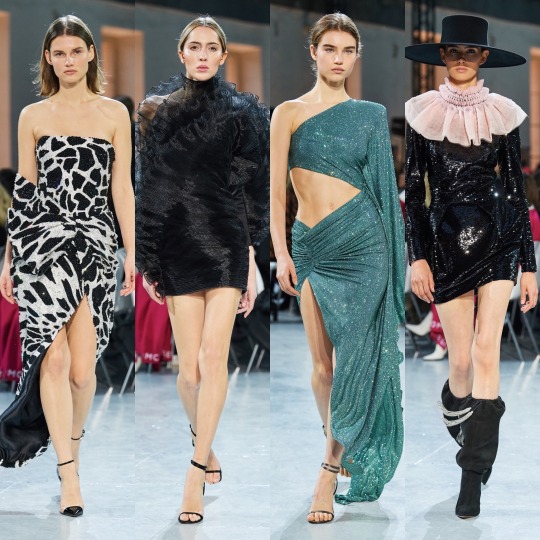
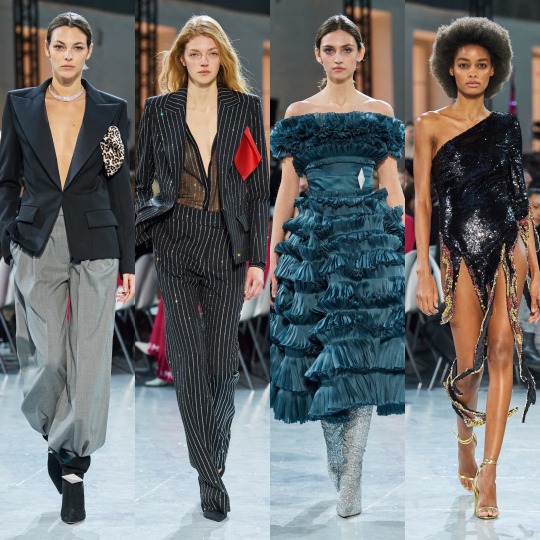
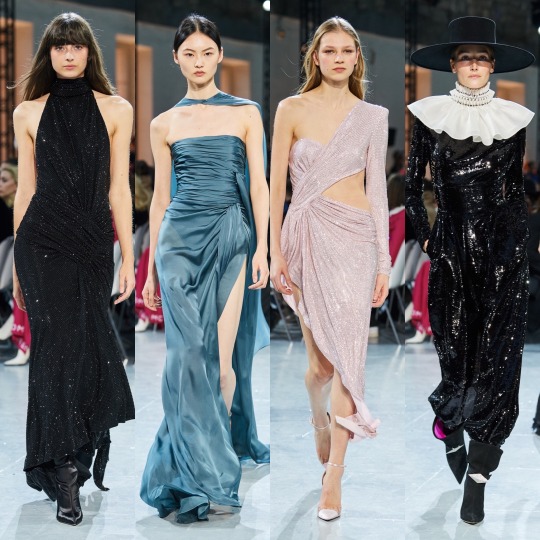
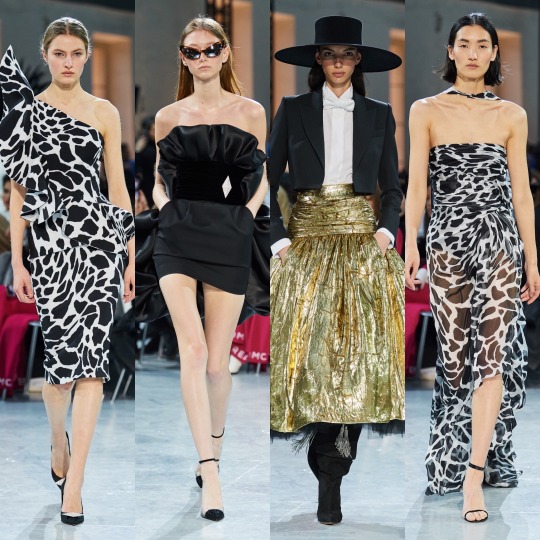
Onto Alexandre Vauthier, which I also really liked. An interesting yet effortless blend of the old and the new, the masculine and the feminine, if I could sum this collection up in one word, it would be cool. I know, it’s not the most descriptive, but it pretty much sums up how I feel; I’m not AS gassed about it as I am about Ulyana Sergeenko or this season’s Elie Saab (wait for it), but it’s a fresh offering, even if the styles aren’t the most groundbreaking. Stand outs for me are the almost petticoat like, debutante dresses which have Elle Fanning’s name written all over them.

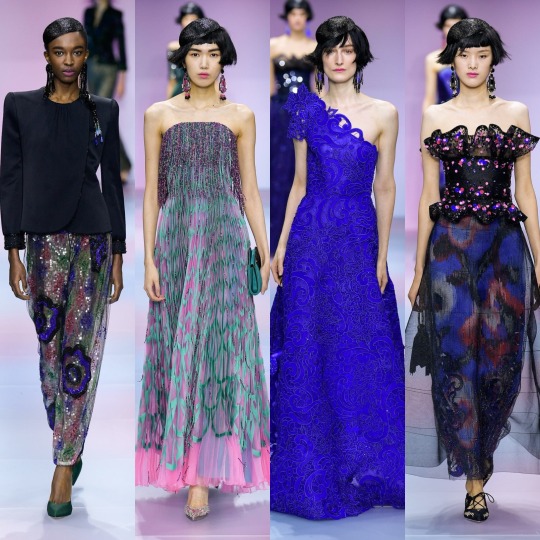

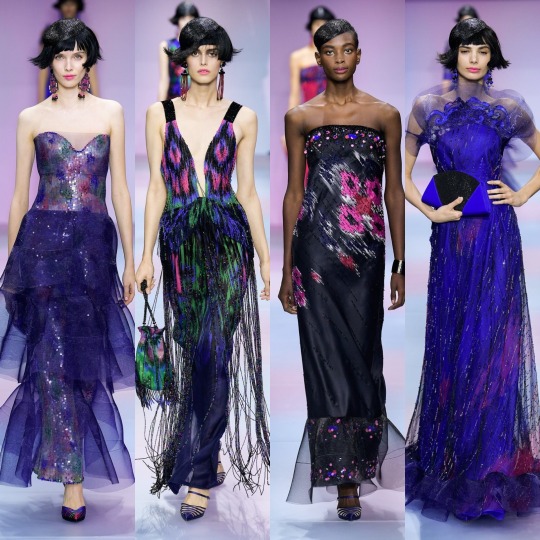
I was hard pressed to find favourites in the Armani Privé collection if I’m honest. I’m not saying it was awful, all I know is that it just isn’t my style. It’s all a bit TOO tailored for my liking, and kinda reminds me of the Zara pantsuits my Spanish teacher used to wear. In other words, I find it to be a bit dowdy. On a positive note, the colours, fabrics, and beading are all stunning, so I see that a lot of craftsmanship clearly went into it; I think my biggest issue is the styling and the shapes (or lack of) on show. I’m very much getting a 20s, flapper vibe and whilst that’s an era that fascinates me and that I appreciate was cutting-edge at the time, I’ve yet to see it be bought into the 21st century in a way that doesn’t look stiff or costume-y.
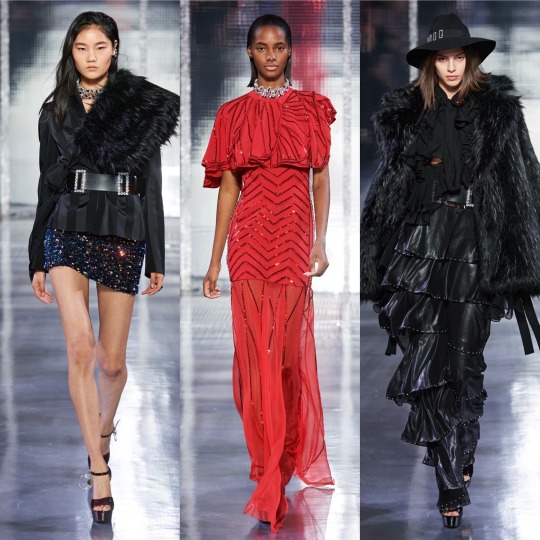
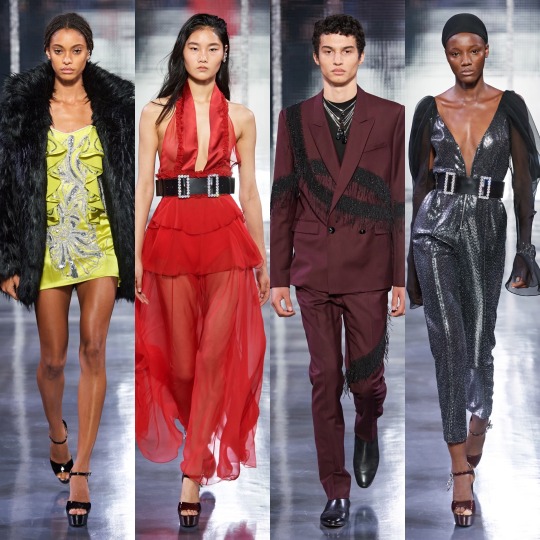
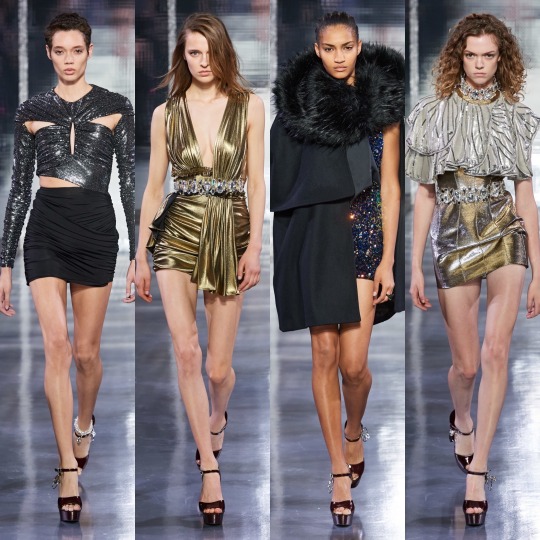

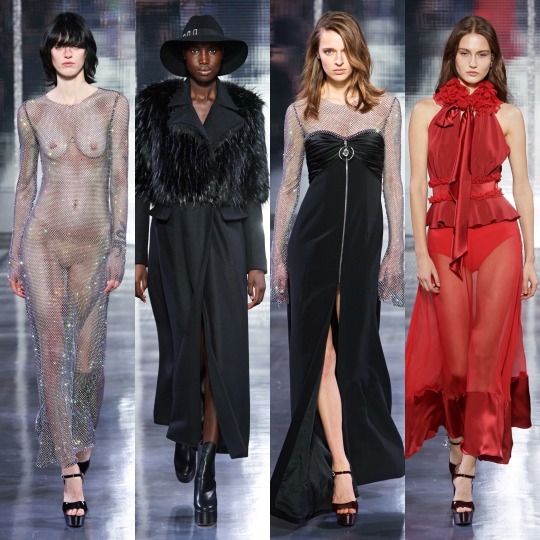
Then there’s Azzaro. At the complete opposite end of the scale to Armani, it doesn’t look expensive, which I’m sure isn’t something any designer previewing their collection at haute couture week is striving for. BUT that being said, I’d be much more likely to wear something from this collection than I would from Armani Privé. I mean, I have no shot at ever wearing either but ya get me.
Whilst I’m sure it or something similar has been done before, the mesh diamanté dress is exquisite and I’m a huge fan of the stacked gem chokers and belts. The whole collection looks like something a London socialite who parties by night but (deep breath in) plays in a shitty band so fancies herself a bit of a rockstar by day would wear (exhale) and as much as that doesn’t sound like a compliment, I mean it as one. I’m talking about the kind of person you’d see smoking outside a bar and think “I wish I was them but I am potato lol”. I mean, as far as faux fur and fedoras are concerned, I’m gonna find it hard to completely slate a collection so this is pretty up my alley.


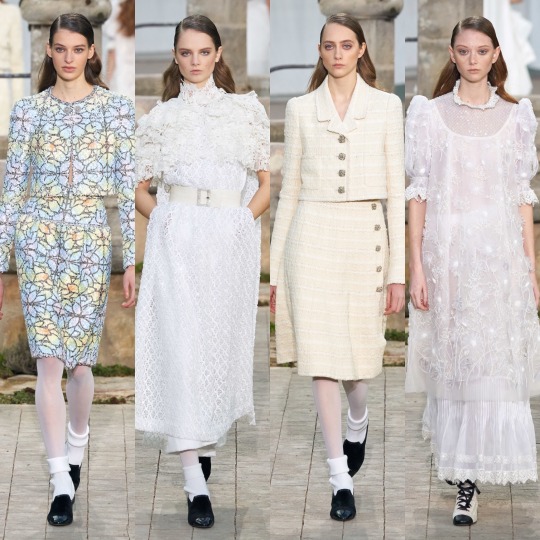
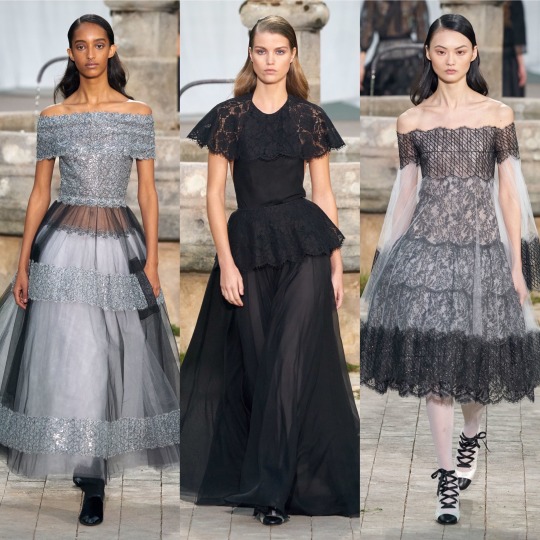
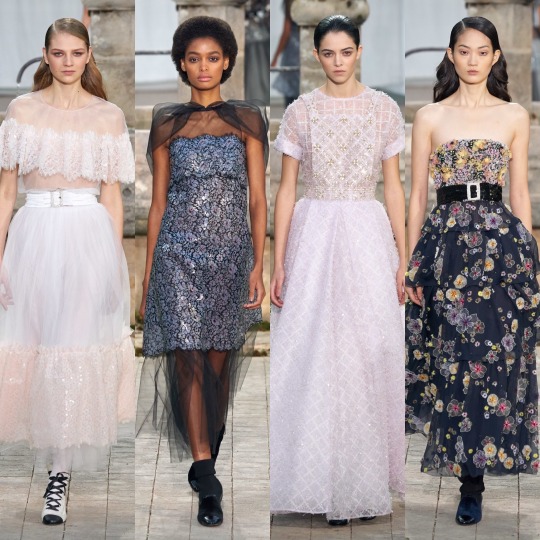
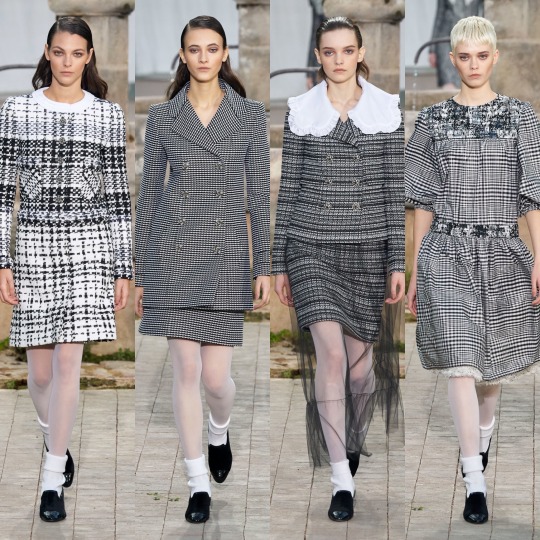
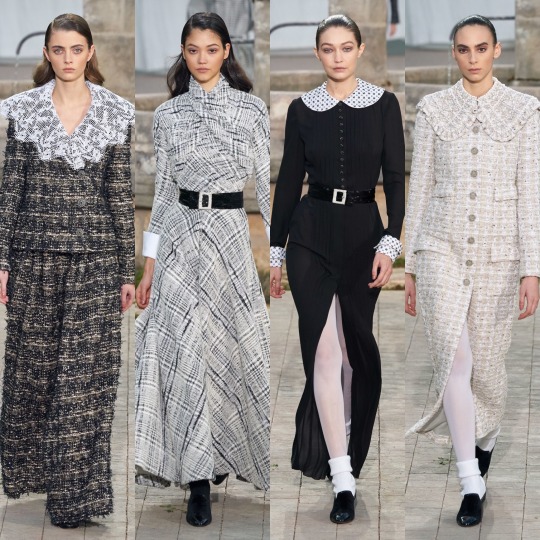
Chanel was a huge step up from their last RTW collection, imo, and probably on par with their last haute couture offering. It’s that same blend of preppy Chanel detailing (i.e the exaggerated collars, the checks and the lace) and practicality, only even more austere this time round.
It’s funny because when I looked back on original notes on this collection, before I’d even done any research into the context, I saw that one of the things I’d written was “giving me Victorian orphanage madame” as well as “something something Amish” and I wasn’t THAT far off base. The collection is, after all, supposed to be a tribute to the nuns who raised Coco Chanel at the beginning of the century in an Abbey-cum-orphanage. This makes me really happy; I know not everyone’s a fan of Virginie Viard’s nods back to the past and the brand’s origins but as a history nerd, I definitely am.
There’s also definitely a lot of things that can be translated into high street trends here: the combination of decorative white socks and black shoes is something I’ve seen making a comeback already, tulle is always a winner (I actually don’t mind it as an overlay, I think it’s pretty, sue me) and I have no doubt we’ll be seeing these dramatic collars creeping back onto tops and jumpers throughout the year. It’s been a while since they were a thing anyway and we all know how cyclical fashion is.

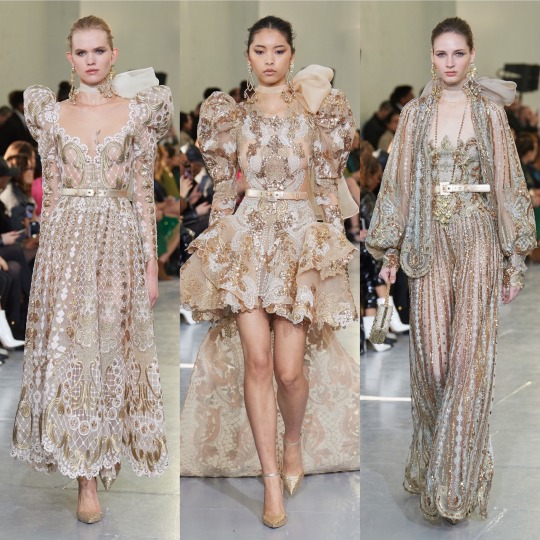


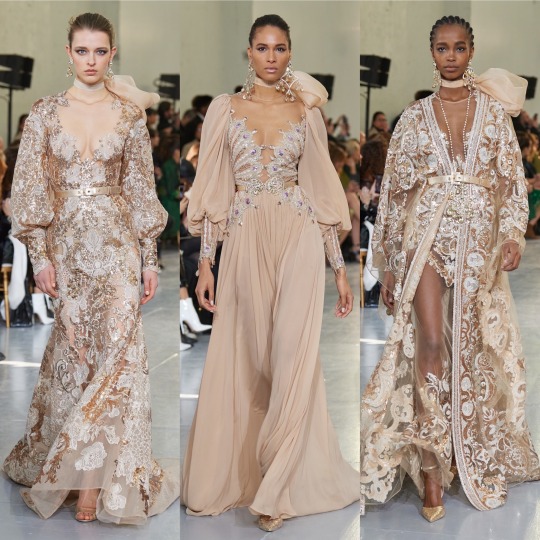
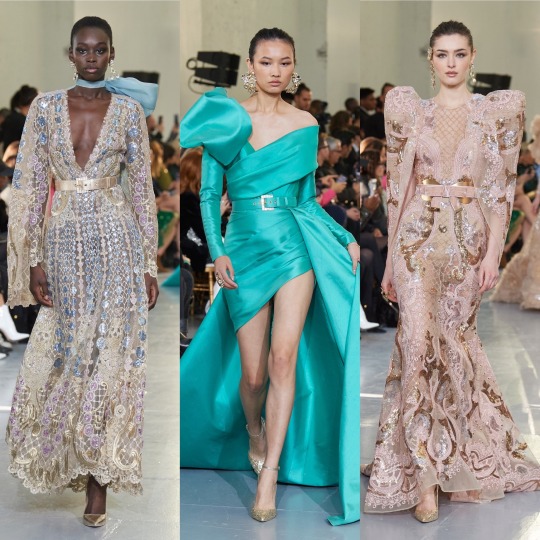



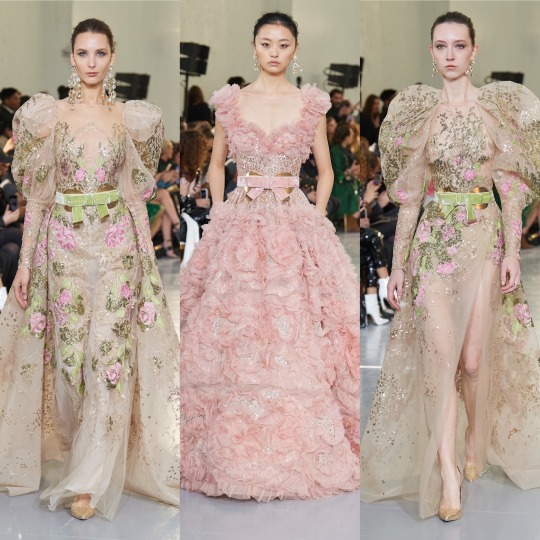
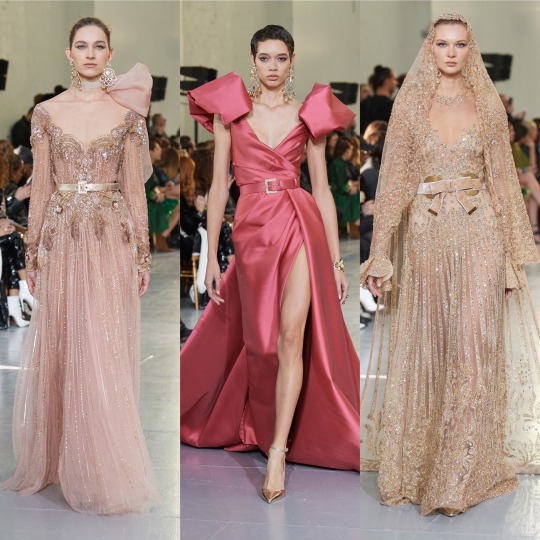
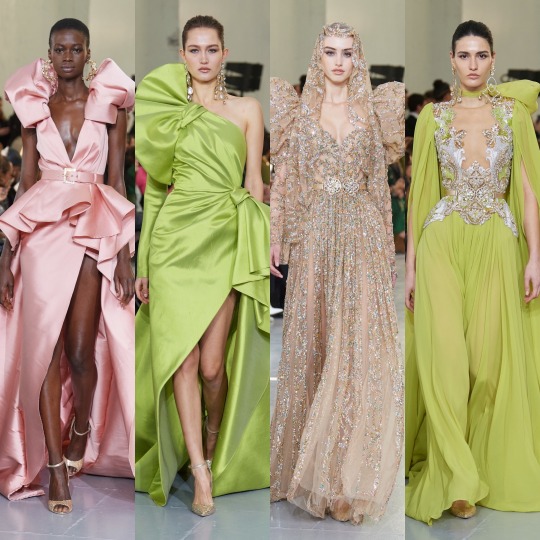
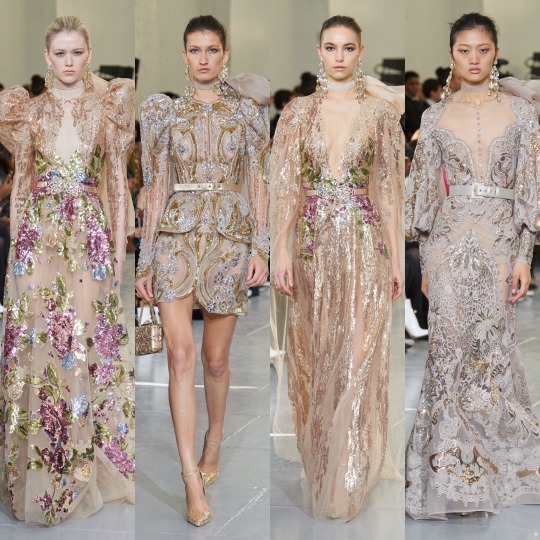
Another high note for Elie Saab this haute couture season; if I was an expressive person, I probably would’ve audibly gasped as I looked through this collection. It is SO FUCKING MAGNIFICENT. The colour scheme, the baroque prints, the floral sequinned embroidery, these are Cinderella style ballgowns taken to the next level. Elie Saab really is the definition of opulence and I’m not at all mad about it. Please, somebody put Lana Del Rey in one of these, PLEASE. Remind her how much of a princess she is and get her out of those “soccer mom” looks.
I’m so stuck between this collection and Ulyana Sergeenko as my favourite, and the latter might just pip the other to the post, purely because of the staging and extravagance of the presentation itself.
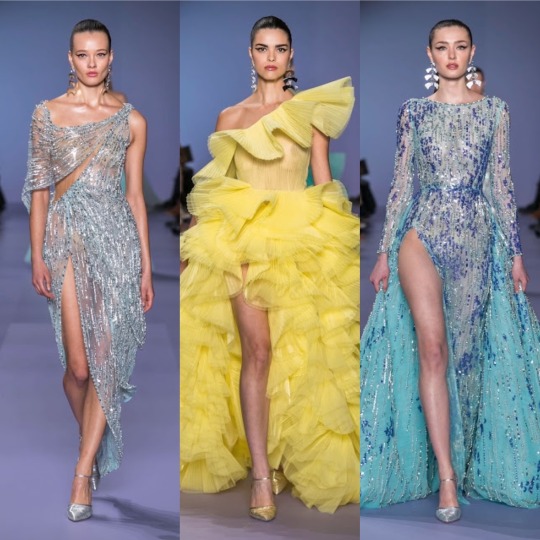


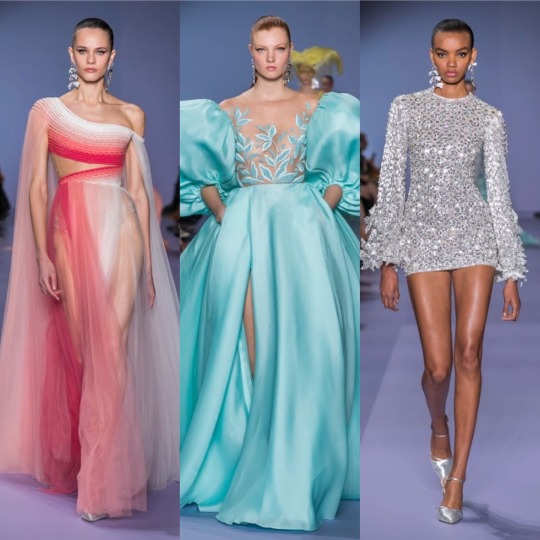
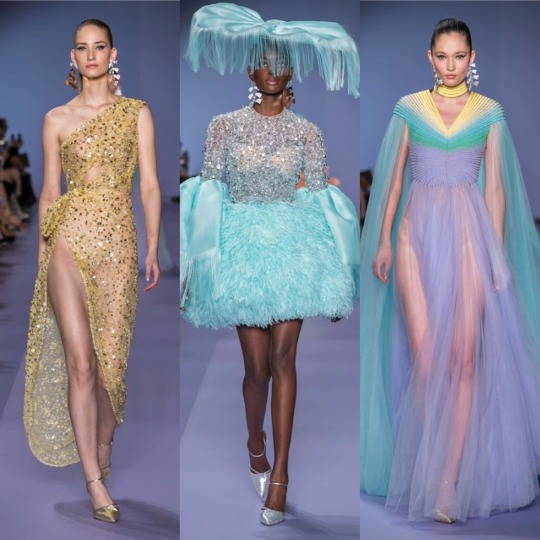





Georges Hobeika was predictably phenomenal. Like, I’m not going to lie, I am easily won over by some sequins and tulle, I’ve never claimed any different, and if you can expect that from anyone, it’s this guy (ignore that phrasing making me sound like his proud mother). The colour scheme is very spring appropriate and so is the 3D flower detailing, and if there’s anything good to take from Ascot and English royal weddings, Georges Hobeika knows it’s the hats.
It was another strong year for Givenchy too:
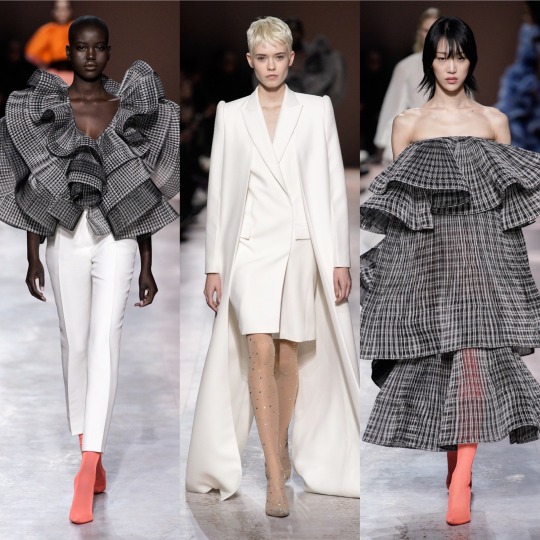
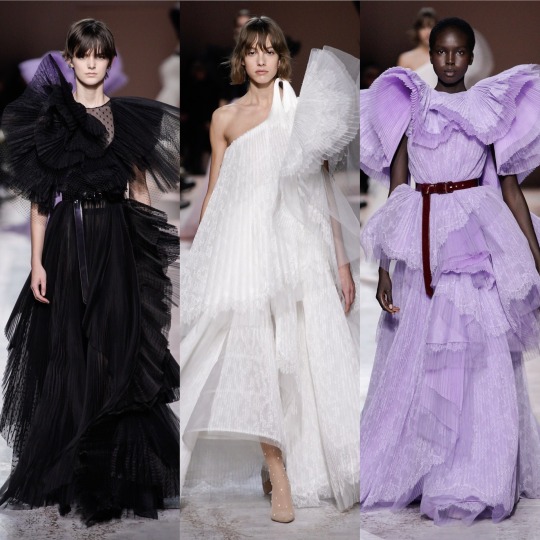
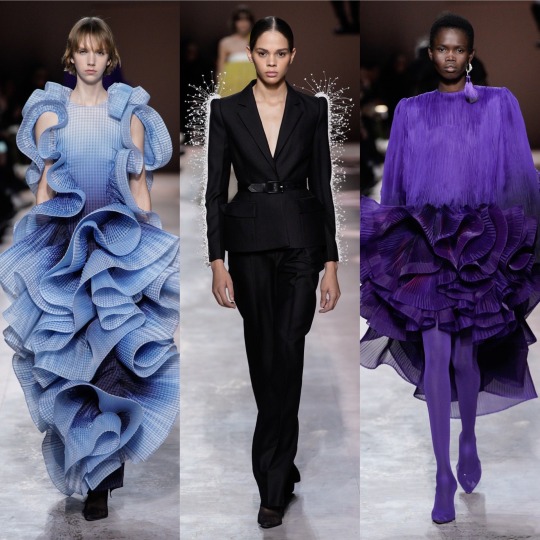
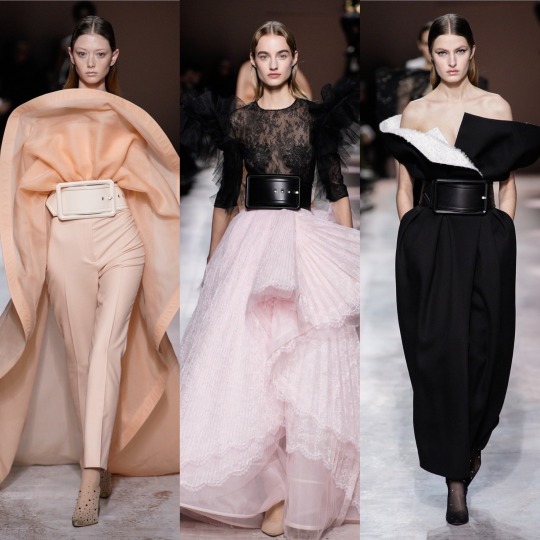

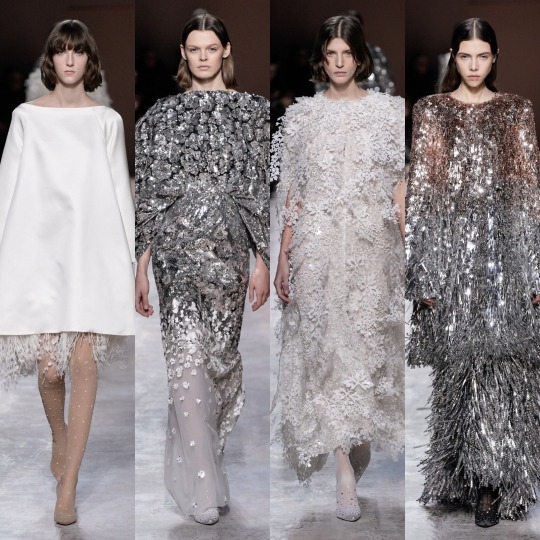
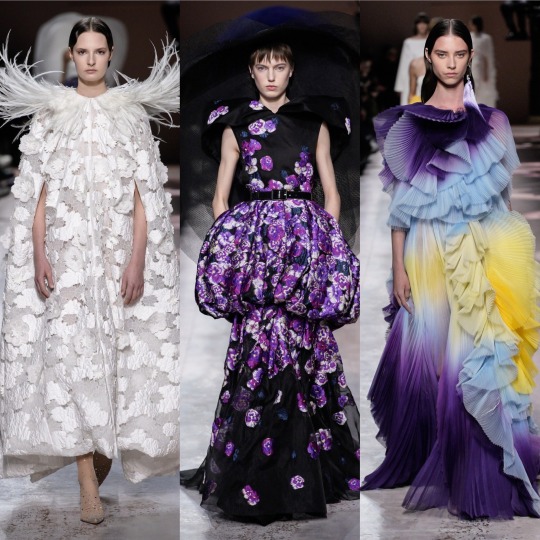
Though Claire Waight Keller is also fond of the extravagant details along the lines of feather and tulle, it’s always done in a more organic way; the details are always more reminiscent of nature, something created by accident, than they are suggestive of painstaking attention to detail, the image of someone hunched over a dress beading for hours on end à la Georges Hobeika or Elie Saab. That is not a bad thing at all; if anything, it makes Givenchy more interesting to study and gives you more to think about. Sometimes a dress takes you a bit longer to fully appreciate, but I’d say that only lends to its memorability. This year’s willowy, billowing, and at times coral-esque structures remind me of something I can see being worn down an Iris Van Herpen runway, set apart by that delicate Givenchy finesse. And side not: I know this post is to talk about the clothes, not the models, but I got super excited over seeing Sora Choi and Adut Akech walk too.
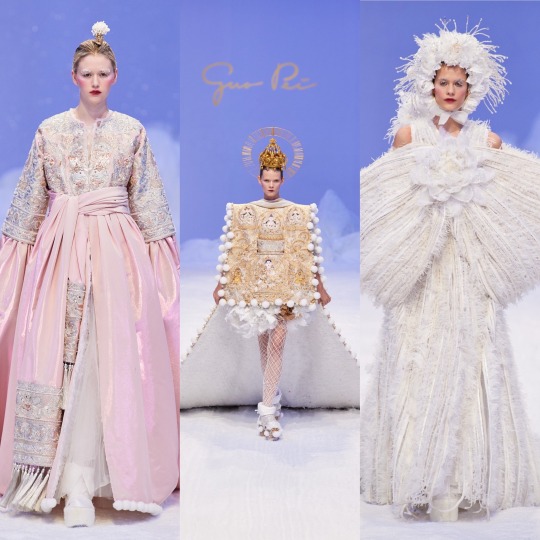
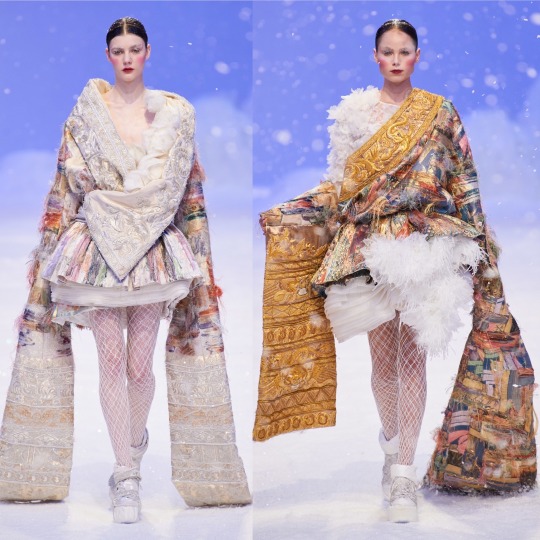
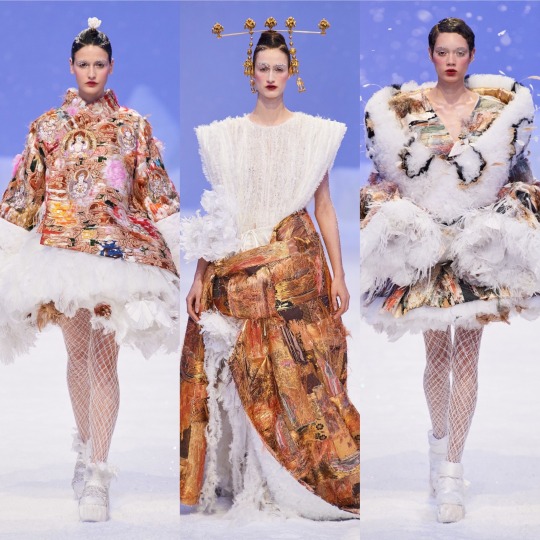
Guo Pei is always fun to look at. I mean, this collection is giving me half Matryoshka dolls, half It’s A Small World Christmas edition and I can’t hate on that.
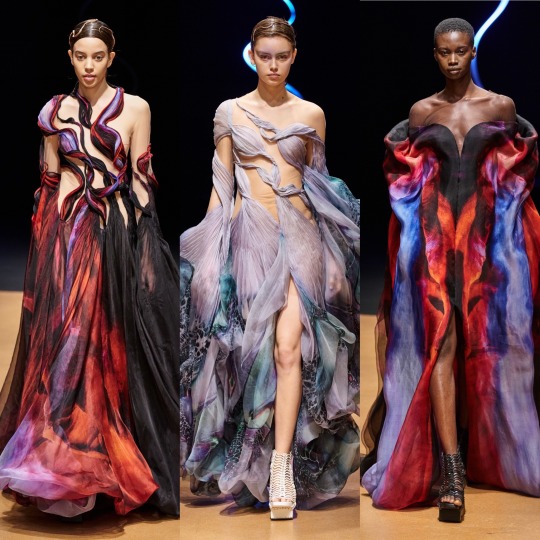
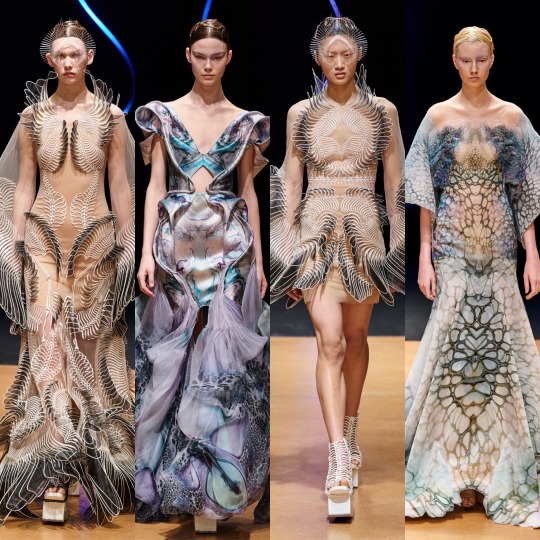
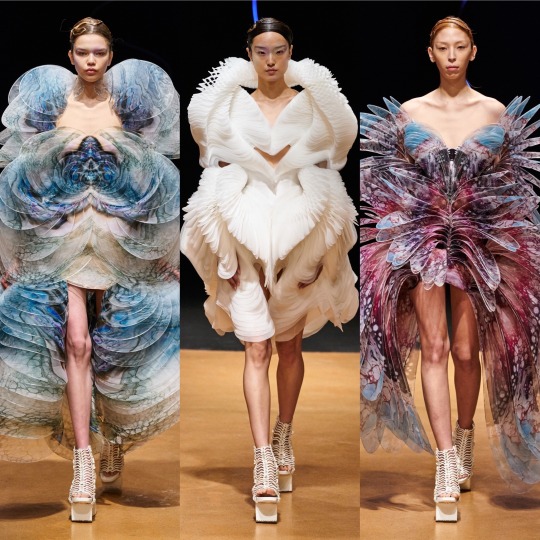
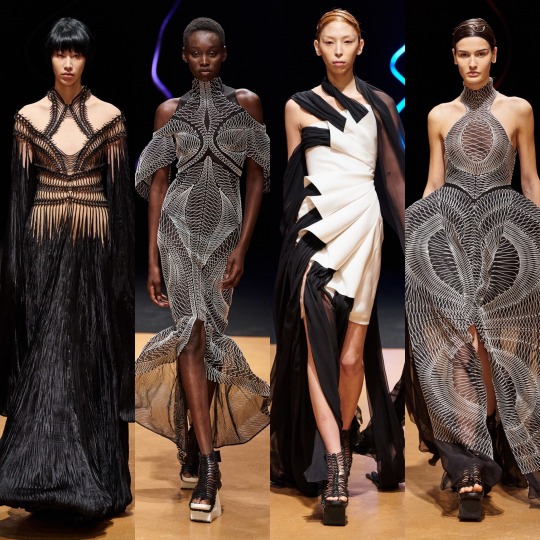
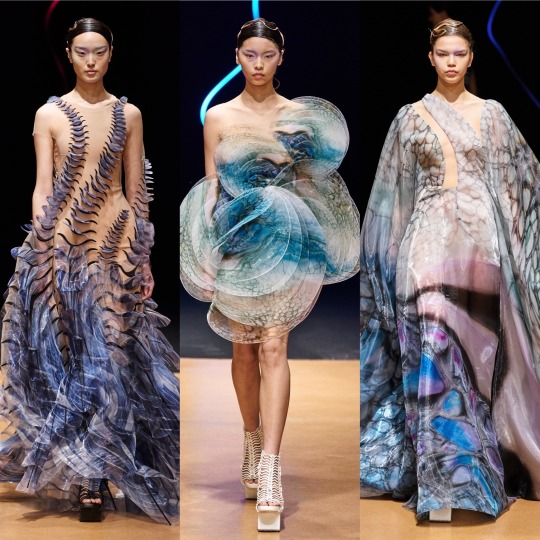
And then there’s Iris Van Herpen, who knocked it out of the park once again. At this point, I wouldn’t expect anything less. Every outfit looks like something that could be exhibited in the Tate Modern (I know, it’s a basic opinion, but it’s true: TATE MODERN IS THE BEST MUSEUM IN LONDON), or honestly, the Design Museum, just for the genius that must go into the way these dresses move. Honestly, if I can see a goddess wearing anything, it’s more one of these looks than anything in the Dior collection. Like wife of Poseidon or something; I know it’s not very feminist of me to not know the Greek Goddess of the sea’s name but I only know who Poseidon is because I was a Percy Jackson fan back in the day so let me live.
It’s not like the whole under-the-sea theme is particularly new, Zimmerman did something similar last RTW (I think? Correct me if I’m wrong), but these constructions could’ve grown out of the sea bed themselves, which is more of an original take than “oo, blue and white and frothy hemlines!”. Additionally, we’ve got these dresses with the overlapping almost plaited fabric that are-we’re sticking with the goddess references here-fit for Persephone ruling over hell. As for the Grudge-looking dress (fourth down, far left), I could be reaching, but is anyone else seeing that as a nod to the oil spills polluting our oceans? Because that would just add yet another layer to this collection.
Regardless, it’s all impeccable and I’m in love. Iris Van Herpen as a MET Gala theme. Make it happen.
Anyway, to end on a high note, that’s it for this post!
Sorry it’s such a sudden cut-off but Jean Paul Gaultier was due to be my second to last to review and due to it being the final show, there’s an onslaught of photos that would not fit with what’s already in this post. Plus, I’d rather start a post with Jacquemus then end it as I feel like there’s a lot of hype around his collections online right now so 1). it’s clickbait (for what, I do not know, as I’m not exactly making any money off this blog, just losing my sanity as it transpires when Tumblr accidentally terminated it earlier today and I had a minor breakdown) and 2). this Steve Buscemi meme is the most accurate representation of only 21 year old me to grace the internet:
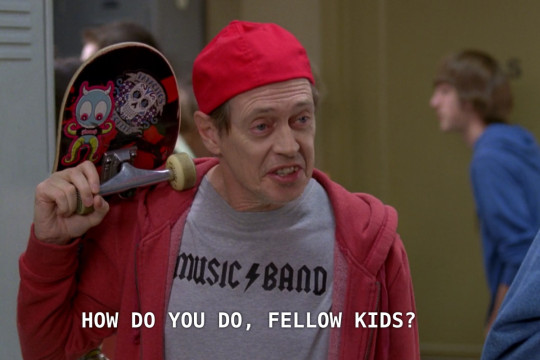
I will aim to post part 2/2 in the next week, including JPG, as I just mentioned, the Jacquemus co-ed show, Margiela, Valentino and more, and as always, thank you for anyone who read until the end! You are an angel:-)
Lauren x
#haute couture#haute couture week#pfw#paris fashion week#paris#fashion#fashion week#designer#jacquemus#dior#style#review#iris van herpen#guo pei#givenchy#elie saab#sequins#pretty#georges hobeika#chanel#pastels#armani
744 notes
·
View notes
Text
Top 10 Personal Favorite Hit Songs from 2017
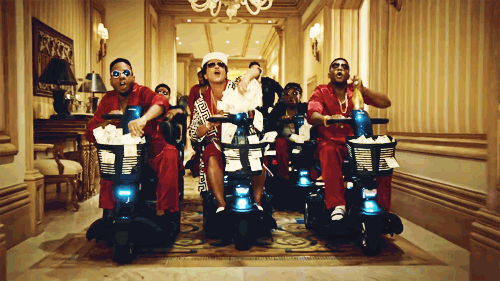
Not a very good year for hit songs. Still better than the next one, though.
And a very satisfying #1 that launched an entire infodump about a specific band. I’m not even sorry.
Disclaimers:
Keep in mind I’m using both the year-end top 100 lists from the US and from France while making these top 10 things. There’s songs in English that charted in my country way higher than they did in their home countries, or even earlier or later, so that might get surprising at times.
Of course there will be stuff in French. We suck. I know. It’s my list. Deal with it.
My musical tastes have always been terrible and I’m not a critic, just a listener and an idiot.
I have sound to color synesthesia which justifies nothing but might explain why I have trouble describing some songs in other terms than visual ones.
2017 might not sound super distant, but it’s already distant enough to analyse what started to happen to me that year with some clarity. This is when I started to lose some of my energy and motivation. A lot, in fact. Everything suddenly felt exhausting and this whole “what’s even the point of anything” mentality started to fall on my shoulders. And you know what, at first, while making these recaps, I had no idea what started it all. Was it that super rare infection I caught in early 2018 and almost made me lose a part of a finger? Was it both my grandfathers dying in mid 2018? Was it the general state of the world? But no, I did some digging and noticed this general exhaustion actually started right during summer 2017 and I was like what the f█ck happened in summer 2017? That summer was fine?
And then it clicked. I know exactly what kickstarted my spiral into about 18 months of depression, and it’s got nothing to do with health or family. It’s something that shouldn’t have affected my life in any way, and that I kinda tried to ignore at the time, and some of you might even find me overdramatic or cringy for letting it affect my life. But yeah, as I’ve realised while making these lists, Linkin Park was actually a super important part of my life, so it makes perfect sense: what started it all was Chester Bennington killing himself. Clearly, someone who had contributed so much to convince me that life was worth living and who suddenly decided it wasn’t worth it, that had a huge impact on me, whether I wanted it or not.
Aaaand now I’m crying again. Great.
Anyway. Uh. Important albums that year! Yeah so uh. Depeche Mode made Spirit and it wasn’t good, and so I kinda lost faith they would ever make a great album again, but I did realise one of my teenage dreams and saw them in concert in the Stade de France in July 2017 (it was huge. Going home after that felt like waking up from some sort of hypnotic trance. They even played Walking In My Shoes, one of my absolute favorite songs from them, along with a video featuring a trans person going to work and I started to bawl my eyes out in the middle of the f█cking crowd). Nine Inch Nails also made Add Violence and continued to be super good, and Indochine made 13, and while it wasn’t nearly as good as Black City Parade, it was also better than La République des Météors, so I was pretty happy about that. EDIT: Forgot about Under Your Spell by The Birthday Massacre, which blew my goddamn mind, but still not as much as the next album I'm gonna talk about.
But the defining album of the year, to me, was Mike Oldfield making a sequel to my favorite album from him, with Return to Ommadawn. Of course it’s not as good as Ommadawn. But still. If Ommadawn felt like discovering a new strange country full of weird folklore and forests and mysterious buildings, Return to Ommadawn feels like going back there half a century later and seeing things in ruins and wounded people, but still trying to seek beauty and joy in a partly destroyed landscape. It makes perfect sense considering the circumstances that surround the making of this thing, and it was the only way to make a good sequel to such a legendary album.
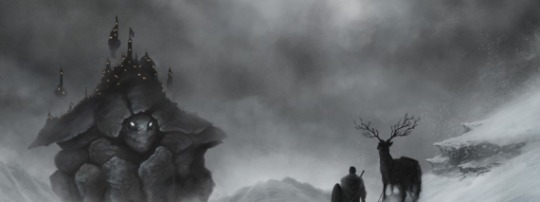
Unelligible songs that piss me off... uh, actually there’s only Cut to the Feeling by Carly Rae Jepsen. Why wasn’t it a huge hit. Come to think of it, why hasn’t any Carly Rae song been a huge hit since Good Times. This feels unfair.
Time for some honorable mentions, then.
Feels and also Slide (Calvin Harris and a lot of other people) - Got nothing to say about either of these songs, but they’re both pretty good.
Katchi (Ofenbach) - Nice little earworm.
No Roots (Alice Merton) - Super surprised this was a hit. Good.
OK (Robin Schulz ft James Blunt) - That’s a James Blunt song in the year of our lord 2017 and it sounds actually good??
What About Us (Pink) - Really caught my attention and made me wonder if I should listen to Pink again after a long streak of mediocre Pink songs.
Congratulations (Post Malone) - I find the song mostly boring but the guest verse ending with “uh, Malone... I gotta play on my phone...” is the stuff of legends and that got a chuckle out of me every time I heard it.
Glorious (Macklemore) - I’m glad this was a hit here but at the same time it’s not my favorite song from him. The music video is adorable, though.
Fly (Odyssey) - Nothing to say about that one.
XO Tour Life (Lil Uzi Vert) - The fact that I was regularly humming this is either a sign of quality or yet another sign I was depressed as shit.
Devil in Me (Purple Disco Machine) - What a great artist name.
Symphony (Clean Bandit) - Nothing to say here either, just good sound all around.
Attention (Charlie Puth) - 2017: The Year Charlie Puth Made A Great Song.
All Stars (Martin Solveig & Alma) - The last cut. It was on the list at some point. I really like it a lot, though.
And now, the list. The stuff I genuinely love starts at #6 and things that are still on my mp3 player to this day start at #4.
10 - Chained to the Rhythm (Katy Perry)
US: #73 / FR: #10

I just love the concept of a Katy Perry song about how Katy Perry songs are happy nonsense distracting you from actual issues. What can I say, I’m a sucker for meta stuff.
9 - Water Under The Bridge (Adele)
US: #88 / FR: Not on the list
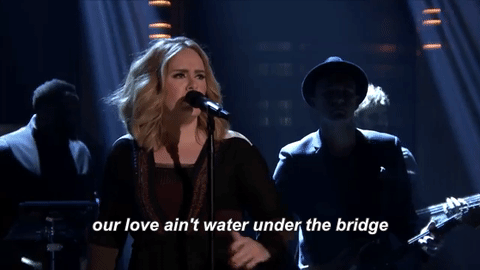
An Adele song projecting actual positive energy!? That automatically goes on the list.
8 - Praying (Kesha)
US: #67 / FR: Not on the list

You know I mostly dislike slow emotional songs regardless of how good they actually are. I will, however, make an exception for this one even though I very rarely listen to it considering how emotionally taxing it is. That’s definitely a fantastic song, though.
7 - Viens On S’aime (Slimane)
US: Not on the list / FR: #53
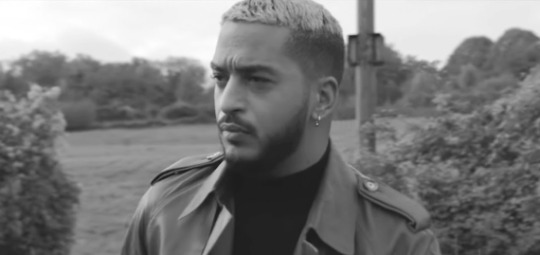
“Listen, we love each other, f█ck it, f█ck their words and their decorum, listen, we love each other, f█ck it, f█ck their ideas and what they’re saying”. Well said, dude, well said.
6 - There’s Nothing Holding Me Back (Shawn Mendes)
US: #23 / FR: #91

That’s a very good song for running and that is becoming increasingly rarer, so I’ll take what I can get.
5 - Paris (The Chainsmokers)
US: #42 / FR: Not on the list (that’s irony for you)
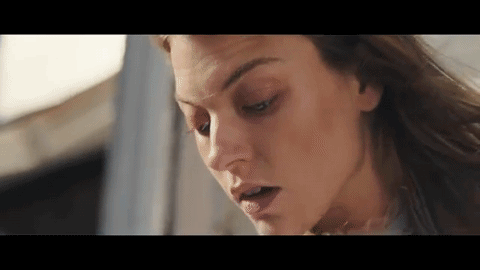
Unlike Closer this is an unrelatable song about rich young people that can afford to live in Paris just “to get away from [their] parents” but honestly that’s the only negative thing I have to say against it. It sounds fantastic.
4 - Castle On The Hill (Ed Sheeran)
US: #40 / FR: #50

We’ve now entered the realm of songs that are still on my mp3 player to this day. This is the only Ed Sheeran song I’ve ever liked, and I love it. It sounds like a lost U2 song. Maybe from a strange dimension where U2 became more fragile and emotional instead of more pretentious.
I have no idea why this guy keeps making such boring stuff when he’s got that kind of song in him. I have no clue.
3 - Something Just Like This (Coldplay & The Chainsmokers)
US: #5 / FR: #19
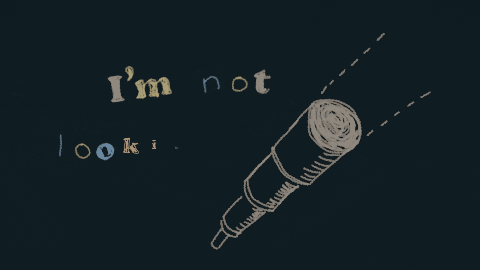
Hey so Coldplay is still on my lists, apparently. It’s a bit too slow, some lyrics about superheros don’t make much sense, and the drop isn’t super good, but my god, that guitar near the end makes everything worth it. Just amazing colors and textures all around.
It’s not even my favorite song on that EP! I think Miracles (Someone Special) is even better, but eh, this one is a close second.
2 - 24k Magic (Bruno Mars)
US: #16 / FR: Not on the list (#13 in 2016 but I put it on the 2017 list instead)
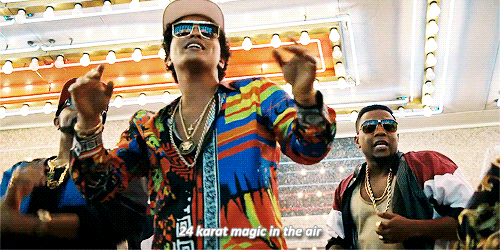
Am I the only one to like this more than Uptown Funk? It’s so much fun to sing along to it. And unlike Uptown Funk, it’s making me feel nostalgic for an era I actually (vaguely) knew, the super colorful and ridiculous early 90s. My s.o loves it too and when it comes up on the radio or on our playlists you can bet we’re both going PUT YOUR. PINKY. RINGS UP. TO THE. MOOOOOOOON like two idiots.
This is the song I could have put on the previous list but elected to put on this list instead since it was elligible for both years, by the way! Since 2017 was less good than 2016, I thought it would be more interesting to save such a great song for later.
It would have topped the list too, if it wasn’t for something I didn’t expect to be elligible before reading the French year-end list.
Strap yourselves in, because I had no real opportunity to talk about this band at length in the posts made for the years when it was the most relevant in my life, so this is going to be quite long.
1 - La Vie Est Belle (Indochine)
US: Not on the list / FR: #44
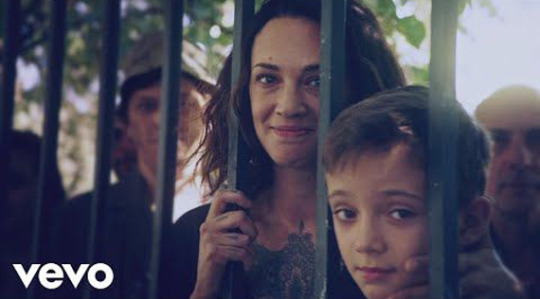
As you already know if you remember some of my previous lists, Indochine is a band I started to love right in the middle of the absolute worst years of my life. These guys had been around since the 80s as a super successful new wave band, then became very unpopular and went underground for about twelve years in the entire 90s, then one of them died, then every member except the singer basically rotated, and then they suddenly re-emerged in 2002-2003 with Paradize, a monster of an album, full of energy, sinister themes and weird provocative songs, and an entire generation of angsty teenagers (me included as you can guess) embraced it wholeheartedly.
And all of a sudden Indochine was the favorite French mainstream band of local young punk/goths! So many kids with the Indochine logo in highschool. Nowadays the band is mocked and well-loved in equal doses by just about everyone, but I suspect it’s just because we’ve all grown up.
Placebo, Linkin Park and Indochine were the bands that ruled my entire world in 2003/2004. My mother hated all three of them, because of course she did, but especially Indochine, because according to her it was partly their fault if I was gender non-conforming. See, she used to say, they had put all kinds of bad ideas in my head and now I was all messed up.
...Holy shit, that’s a lot of blame to put on a ridiculous new wave band who’s first hit song from 1983 is just a long nonsensical list of shitty old Bob Morane pulp novels.

But here’s the problem. Even if Indochine kept having hit song after hit song, those were never the best songs on their albums. Here I am, 31, making these top ten lists since last December, and becoming more and more frustrated to see none of my favorite modern Indochine songs are elligible. My favorite Paradize singles were Mao Boy, Popstitute and especially Marilyn (god, this song rocked my entire year alongside Placebo’s The Bitter End. 2003 was such a fantastic year for dark energetic hit songs)? Too bad, the biggest hits were J’ai demandé à la lune and Le Grand Secret. Alice & June had four fantastic singles? Too bad, none of them is elligible! Same thing for the entirety of Black City Parade. Oh, but that song I hate from La Republique des Météors is elligible, I guess!
So we’re in summer 2017, and my life is completely different now, and Indochine releases La Vie Est Belle (I’m linking the album version and not the music video because it has some violent themes in it). I’m in my car doing some errands and the local radio goes “hey new song from Indochine” and I’m like “oh shit, gotta hear this” and then two minutes later “oh wow, that is super good. Won’t be a hit though”.
And yet, it was a hit! It became huge, even! And at that point I was already loving that song even though I thought it was just a super good but tragic love song about a significant other dying too young.
And then, about a month later, the wordplay of the first line finally hit me with the force of a semitruck. It’s not a love song. It’s a song about the singer’s dead twin. Who died in 1999.
It’s such a devastating, beautiful song, and yet it’s full of energy. I. adore. it. It’s exactly the kind of song you need to continue to fight and to live and to help other people in this day and age. “Life is beautiful and cruel, it looks like us sometimes” indeed. And it’s one of the best on the album, too!
So yes, 15 years after I first fell in love with this band and after they helped me during super dark times, finally, I can put one of their songs at the top of one of these lists, hands down, no debate whatsoever.
That probably sounds ridiculous but it’s genuinely making me feel extremely emotional.
Next up: I thought music sucked that year because I was depressed but I relistened to it and no it wasn’t just me
#Johannes’ bad not good pretty terrible music lists#music#long post#eye contact tw#suicide mention tw#I can't believe I'm almost done with these lists#that was a wild ride guys
12 notes
·
View notes
Text
Hello. It’s been awhile.. and I’m finally writing again
Hereby lies my overflowing thoughts of my journey in my 3rd year of studying composition & arranging at Lasalle College of the Arts. Hereby i present to you my logbook. I hope it’s interesting to read..
SEMESTER 1
WEEK 2 || Monday, 7th September 2020
note: Lesson 1 started at Week 2 in 2020.
Topics:
Review of Harmonic Landscape
Advanced Modulation
HARMONIC VOCABULARY
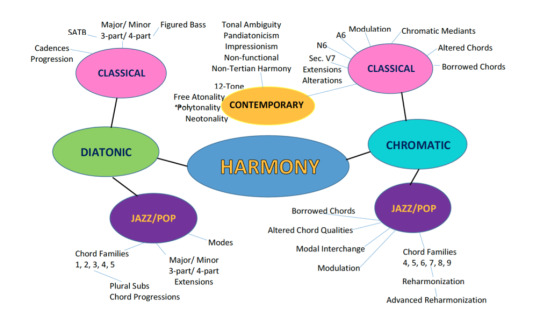
(Belinda Foo. Lasalle College of the Arts 2020)
ADVANCED MODULATION
refer to Max Reger’s text on Modulation
Some key concepts;
No Enharmonics
All modulations approached via cadence-like progressions
Observations;
The modulations are ‘logical’ and can be accountable via tonal relationships
All modulations are arrived at cadentially: IV – V – I, II – V – I, bII – Ic – V – I
It is easier to work out the modulations ‘backwards’ from the dominant of the new key
Relationships between Keys
Pivot chords
Borrowed chords
Neapolitan 6th chords (especially for remote modulations)
Dorian 6th chords (E.g. D major triad in A minor)
2nd super-dominant (E.g. D major triad in C Major)
REVIEW ADVANCED REHARM
Review Menu of Chord Choices
Using Outer Line Movement: Directional interaction between Melody and Bass line
Contrary Motion
Parallel Motion
Chromatic Movement
Tonal Movement
Tritone Movement
Pedal Point
Free Bassline
Contrary Motion

Parallelism
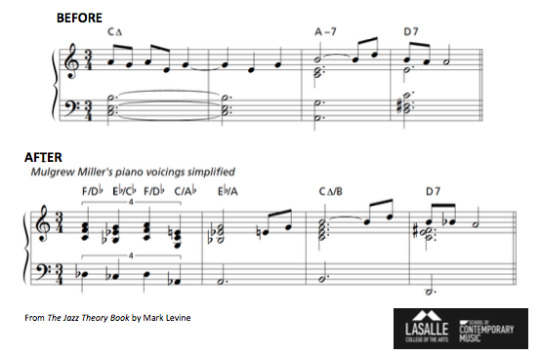
Chromatic Movement

Tonal Movement
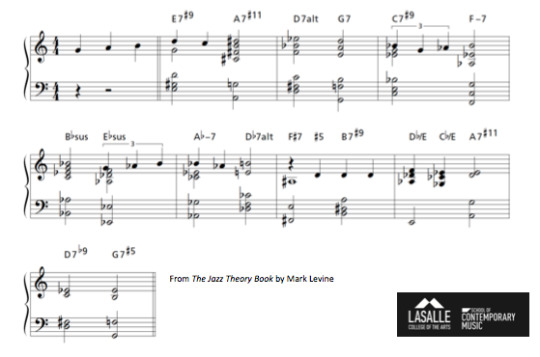
Tritone Movement


Pedal Point
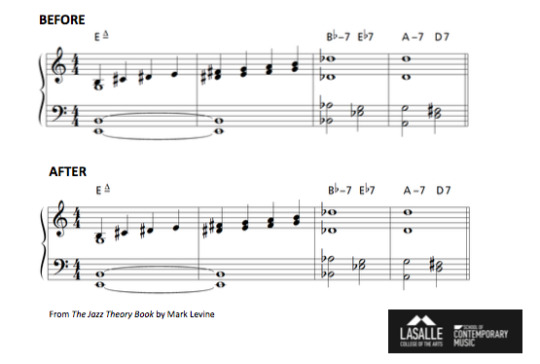
Free Bass line
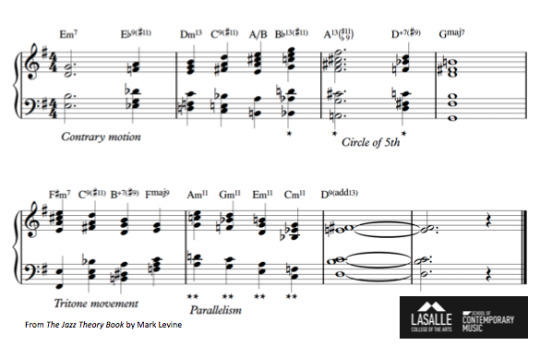
Use of Polychords
C Major triad over Bb7
F# Major triad over A7
Bb Major triad over D7

Use of Minor 11th Shapes:
Open 4th at the bottom
Triad (2nd inversion) at the top

—————————————————————————————
WEEK 3 || Monday, 14th September 2020
In week 2, Belinda discussed the same topics from Week 1 because we had not yet covered everything last week. My summary from this week is concluded in week 1 as it is also pretty much the same from last week. Belinda also further talked about Max Reger’s techniques.
Topics:
Review of Harmonic Landscape
Advanced Modulation
—————————————————————————————
WEEK 4 || Monday, 21st September 2020
In week 3, Belinda further talked about Max Reger’s modulation again. The summary for this one is also included in my week’s 1 summary. Other than that we discussed about Romantic and Late-Romantic music, Wagner’s Lohengrin, and writing for strings.
Topics:
Max Reger Modulation Review
Romantic & Late-Romantic Orchestration
Analysis of Wagner’s Lohengrin
Writing for Strings
ROMANTIC MUSIC PERIOD
basic information:
From about 1830 to 1900
Characteristics: expressive, expansive, virtuosic, inspired by art, literature
New forms beyond the Classical forms, such as: rhapsody, arabesque, song cycle, nocturne and programmatic music
Greater Chromaticism
Extended melodic lines, themes
Romantic Composers
Berlioz, Hector
Brahms, Johanne
Bruckner, Anton
Chopin, Frédéric
Dvorák, Anton
Grieg, Edvard
Mahler, Gustav
Tchaikovsky, Peter
Strauss, Richard
Wagner, Richard
Relevance of Romantic Music Today
Melodies and Harmonies still used in Film & Animation music
Leitmotif: a theme associated with a character, place or idea
Orchestration: Romantic Orchestra & Orchestral techniques
COMPOSING FOR STRINGS
Characteristics of the Strings Family;
Homogenous timbre throughout the family
Virtually tireless for both player and listener
Flexible, versatile in terms of register and ability
Writing for Strings Masterclass:
link: https://www.youtube.com/watch?v=yST6mS8W1f8&ab_channel=JeffPifher
personal note:
This was actually a homework from previous week from Belinda, and i watched the video beforehand. There were some key takeaways to make writing for strings more interesting like (which are actually unbelievably so simple) ;
- “know what to look for” — pay attention to your melody, style, phrasing
- playing with texture (e.g. one line playing staccato, another line playing legato/long lines)
- accents!!! — articulation is key!!!
The Strings Choir as:
Foreground
Middleground
Background
Homophonic Writing
Accompanying Choir
Contrapuntal Textures
Special Effects and other 20th Century devices
String Section Sizes

General String Writing Tips
Divisi: divides the section, used to add/ complete harmony. Div a 2, Div a 3, Div a 4 (not common). Not a good idea to divisi violas if they are less than 8 players (6 players minimum)
Double stops: most commonly used to add harmony part. Stick to slow moving passages. Check that the double stops are feasible on the instrument.
Pizzicato: Best kept to the lower 3 strings
Octave combinations: It is common practice to double very high violin lines (Violin 1) an octave lower (Violin 2) to lend the former support.
Bowing Effects
Belinda asked us to refer to this video, which I also watched before the class as it was part of our homework from last week.
link: https://www.youtube.com/watch?v=cEBN2UkJavk&ab_channel=VIOLINLOUNGE byViolinistZlata
ANALYSE WAGNER’S LOHENGRIN PRELUDE 1
note;
during this analysis, our main focus was the string writing, string choir: homophonic writing primary line against accompaniment
link: https://www.youtube.com/watch?v=gT1AfIUgO88&ab_channel=ClassicalMusicScores
—————————————————————————————
WEEK 5 || Monday, 28th September 2020
Topics:
Max Reger Modulation Review
Writing for Woodwind
Analysis of Wagner’s Rienzi
MAX REGER MODULATION REVIEW
This week, Belinda reviewed about the Max Reger modulation. The summary is pretty much the same with the previous weeks we had it.
WRITING FOR WINDS
Characteristics of the Wind Family
Less homogenous in sound (unlike the Strings)
Single reed and double reed timbres differ
Wind players need to take breath
Some Interesting Effects
Double-tongueing/ Triple tonguing
Harmonics - The pitch of the harmonic sounds exactly as it is notated
Fluttertongue - Flautists flutter their tongues to create a “frrr,frrr” sound
personal note;
because of the lessons and workshops I had from Felix’s class (Specialized Ensemble Workshop), these effects were no strangers to me and I am quite familiar with it. I have also used these effects in my composition (mainly in his class). But this lesson was a good refresher to me.
Common Functions
Harmonic background - Homophonic wind writing
Solo passages - Choice of timbre/colours
Contrasting colors - To repeat or echo; create relief
Double other instruments - add richness, warmth; brighten up
Contrapuntal Writing
The unique color of each wind instrument makes for ideal contrapuntal writing
Refer to Britten’s The Young Person’s Guide to the Orchestra, Fugue, mm 1-55
Refer to Stravinsky’s Rite of Spring, “L’Adoration de la terre” mm 40-60.
Special Effects and other 20th Century devices
Belinda showed us some pieces that has examples of special effects. The pieces we discussed were;
1. Penderecki, Dies Irae “Apocalypsis” mm 2-4
Winds first play the highest pitch they are able to produce. Then they trill on the specified notes until the end of the dark line with arrow.
2. Stachowski, Irisation for Orchestra, third movement, mm. 79-83
The composer asks the winds to remove their mouthpieces from their instruments and “play through them.
ANALYSES OF WAGNER’S RIENZI
note:
during this analysis, our main focus was the woodwind writing, homophonic writing, choice of color,relief, highlights, adding warmth, and color
—————————————————————————————
WEEK 6 || Monday, 5th October 2020
Topics:
Writing for Brass
Analysis of Wagner: The Flying Dutchman
WRITING FOR BRASS
Characteristics of the Brass Family
Most powerful sound resource in the orchestra
Not as homogenous in sound as the strings although horns and trombones can blend fairly well
Not’ tireless’ on players and listeners — the brass sound is an imposing one and players need to breathe
Common Functions
Homophonic Unit
Pay attention to voicing, spacing, voice-leading and doubling
Refer to overtone series
Strengten and clarify harmony
Reinforcing harmony played by another choir
As a pedal
Harmonic ‘glue’, background line
State a melody
Choice of timbre, dynamics
Combinations
Double other instrument(s)
To add colour
add weight, power
Build Climaxes
Hold back first, save the colour for climactic event Contrapuntal voice
Use instruments in their best register — clarity go line and balance
Pay attention to timbral differences and articulation
refer to Stravinsky’s J.S Bach Choral Variations, Var. IV, mm. 1-6
Special Effects in Brass
refer to “Contemporary French Horn Techniques - Guide for Composers”
link(s):
https://youtu.be/_FPDrQzRE3o
https://youtu.be/-IwXEyr4uV8
https://youtu.be/qQ1oe3YSqsY
ANALYSIS OF WAGNER’S “THE FLYING DUTCHMAN”
note:
In this analysis, our main focus was the brass writing, choice of color, and orchestral combinations.
another note (not important); everytime i hear the word Flying Dutchman, it reminds me of the movie Spongebob Squarepants :))))). The Flying Dutchman is the ghost that Spongebob and citizen of bikini bottoms most feared of
—————————————————————————————
WEEK 7 || Monday, 12th October 2020
Topics:
Motivic/Thematic Development
Orchestral Devices
Analysis of Holst’s Mats, Mercury, Venus
MOTIVIC DEVELOPMENT
Repetition
Sequence
Changing intervals
Fragmentation
Extension
Inversion
Changing the rhythm
Decorated repetition
Changing order of notes
Augmentation
Diminution
Contraction
Expansion
personal note:
Belinda showed us examples (played it on her keyboard) of motivic development by playing a short motif and expand it by using the devices above. It is such a simple idea yet so useful and i foresee myself using these techniques many times because of the very little amount of time i’ll be having to write for my recital. a.k.a squeezing juice out of my brain!!!
THINKING ORCHESTRALLY
Basic Concepts
Balance
Sonority
Unity, Variety
Tone/ Timbral colour
Clarity, Brilliance
Expressiveness
Orchestral Textures
Orchestral Unison
Melody and Accompaniment
Primary and Secondary Element(s)—Melody, secondary line(s), accompaniment
Part Writing
Isolated Chords
Complex Texture
ORCHESTRAL DEVICES
String Quartet & Wind Quintet
Within Family timbres
Solo feature
Combination of timbres
Tutti unison
String devices; bowing techniques (detaché, legato, marcato, staccato, spiccato, au talon, Punta d’arco), Pizzicato, tremolo, col-legno, sul ponticello, glissandi/portamenti, harmonics
Wind devices; Double-triple tonguing, flutter tonguing, harmonics, slap-tongue
Brass devices; mutes, stopped, double-triple tonguing, glissandi, bells up (horns)
Percussion; Types of Percussion— pitched, unpitched, Metal, Wood, Non-metal, Membranous, Keyboard
ANALYSES OF HOLST’S “MARS”, “MERCURY, and “VENUS”
note;
during this analysis, we focused on the choice of color, orchestral combinations, and motivic/thematic development
personal note; i love love love uncle Holst so much. I wish i wrote his pieces. Some of his pieces from The Planets series also has become my inspirations in writing my recital pieces!
—————————————————————————————
WEEK 8 || Monday, 19th October 2020
Topics:
Review Compositional Devices
Analysis of Holst’s Mercury, Venus, Jupiter, and Uranus
COMPOSITIONAL DEVICES
remember remember remember this!
Common Practice Tonal Centers — Major and Minor
Chord Extensions — 9ths, 11ths, and alterations
Added note chords
Chromaticism and Tonal Ambiguity
Meter-Mixed and Asymmetrics Meter
Modes and other Scale sources, including Synthetic scales
Pandiatonicism
Polyharmony—Polytonality and Polychords
Non-Tertian Harmony — Quartal and Quintal
Scandal Chords — clusters
Parallelism
12-tone Technique and Serialism
Limited Composition—based on intervals
Hexachord Writing
Unrelated Triads
Neotonality
Mirror Writing
Harmonic Direction; Progression, cadential services
Harmonic Synthesis
Indeterminate Procedures
NEOTONALITY
basic information;
Tonality that is not based on any particular diatonic system nor functional harmony (Common Practice Period)
Features non-traditional concepts such as tonal assertion or contrapuntal movement around a tonal centre (which may shift).
Combining the features of Common Practice Period tonality with 20th Century tonal ambiguity and atonal characteristics
Neo-tonal Composers
Paul Hindemith
William Schuman
Roy Harris
Samuela Barber
Vaughn Williams
Sergei Prokofiev
Igor Stravinsky (Neo-Classical pieces)
ANALYSIS OF HOLST’S MERCURY, VENUS, JUPITER & URANUS
i love holst’s piece because it sounds like a film score!
Mercury
The Winged Messenger
Energetic, momentum
Changing tonalities-darting from key to key
Rhythmic & Metric ambiguity
Venus
Bringer of Peace
Woodwinds — overlapping winds, tertian harmonies, sweet
Twinkling effect — 2 harps, glockenspiel
Lines —lower strings
Jupiter
Jollity
Full of beautiful themes, melodies
Use of Timpani
Syncopation
Uranus
Rotates on its side (axis is different from other planets
‘Lop-sided feel’
Strong motif: G-Eb-A-B
personal note:
my favorite is probably the Jupiter piece. It has also become an inspiration for my recital pieces. The sounding-like-film also very much suits my style!
—————————————————————————————
WEEK 9 || Monday, 26th October 2020
Topics:
Review Compositional Devices Pt.4
NEW: Media Music
REVIEW COMPOSITIONAL DEVICES
My summary would be pretty much the same from last week
MEDIA MUSIC
basic information:
Music that is written for film, TV, animation, games, commercials, web applications with the intention of enhancing the production or product.
Practicalities to Note
Specificity of usage
Duration, mixes
Open-ended (looped), Closed-fixed duration
Style, Concept
Target Audience
Functions of music in Media
Commenting
Illustrating Movement
Enhancing Momentum
Create Atmosphere
Portray Emotions
Social/Cultural/Geographical references
Time/Period references
Connects scenes and montages
Alternate the perception of time
Imply a sense of space
Create unreal situations
Create contradictions
Physiological Conditioning
Imply size relationships
—————————————————————————————
WEEK 10 || Monday, 9th November 2020
Topics:
Serial & Atonal Counterpoint
Counterpoint in Hindemith, Bartok, and Stravinsky
Chapter 27 &28 Harold Owen, Counterpoint
SERIAL & ATONAL COUNTERPOINT
during this discussion Belinda showed us examples from;
Schoenberg, No.4 from Five Piano Pieces OP. 23
Webern, Variations for Piano Op. 27, Movement II
Things to pay attention to were;
Texture
Cohesion
Use of Dissonance & Consonance
Temporal Elements,Rhythm, Pulse, Meter
Canonic Qualities
HINDEMITH, BARTOK, AND STRAVINSKY COUNTERPOINT
Belinda showed us examples from these pieces;
Hindemith, Fuga Quarta in A, Ludus Tonalis
Bartok, Theme and Variation from Mikrokosmos, Book IV
Stravinsky, Great Chorale from L’Histoire du Soldat
we also discussed about the things noted below;
Hindemith
Compare the melodic style of hindemith’s fugue with Schoenbrg’s piece
Describe the vertical sonorities, cadences, and treatment of the major triad
Describe the temporal aspects in Hindemith’s fugue and compare them with Schoenberg and Webern
Bartok
What is the tonal centre of this piece?
Describe the melody in this example
What are the intervallic relationships?
Explain the significance of ‘Theme & Inversion’
How are the parts related and yet maintain their independence?
Discuss the rhythmic treatment
Stravinsky
How does the ‘Great Chorale’ resemble a Bach Chorale?
What key is this chorale in? Describe the cadences.
There is liberal use of chromaticism, yet the voice-leading is diatonic. Explain this.
There are triads in the harmony. Discuss how they are used here in comparison to music of the Common Practice Period.
—————————————————————————————
WEEK 11 || Monday, 16th November 2020
Topics:
Review Series & Atonal Counterpoint
Passacaglia writing
Creating Harmonic & Textural Worlds
REVIEW SERIES & ATONAL COUNTERPOINT
Discussed the same thing from last week, and Belinda discussed the things she has not yet covered, making the topic more in-depth. My summary for this is the same from last week.
PASSACAGLIA WRITING
What is Passacaglia form?
Passagcalia is a musical form of continuous variation in triple time. It was a courtly dance that originated in Spain in the 17th Century.
The passagcalia usually begins with an ostinato in the bass, but is also found in other voices.
How to write a Passacaglia?
Begin with a ’tonal’ line that will work well as a repeated pattern
Variation is created as other lines are layered over/ under this repeated pattern
This initial theme can be sequenced, but it should not be modified too much
The initial theme should always be present in at least one of the voices
Famous Passacaglias include:
Bach- Passacaglia and Fugue in C minor for Organ, BWV 582
Ravel- Piano Trio in A minor, III. Passacaille
Copland- Passagcalia for Piano (1921-22)
Hindemith- Passagcalia, Noblissima Visione Suite
William Schuman- Symphony No. 3
Things discussed;
How is the initial theme repeated, varied?
How are layers added?
How is the theme sequenced?
How are dissonances and consonances manipulated?
Observe density and contour
Observe textural changes
—————————————————————————————
WEEK 12 || Monday, 23rd November 2020
Topics:
CONSULTATION FOR HALF RECITAL
General Types of Musical Material
CONSULTATION FOR HALF RECITAL
For my consultation, I showed Belinda my first draft of my first piece from my recital, titled “The Bushfire, The Flood, and The Virus”
GENERAL TYPES OF MUSICAL MATERIAL
Unaccompanied melody
Unified harmony
Composite harmony
Imitative counterpoint
Similar Counterpoint
Contrasted Counterpoint
Composite musical material
Unaccompanied Melody
Solo
Doubled Unison
Doubled at the Octave(s)
Tutti Unison
Unified Harmony
All parts move in the same rhythm
May be minor, incidental rhythmic differences
Uniform tone-quality
example;
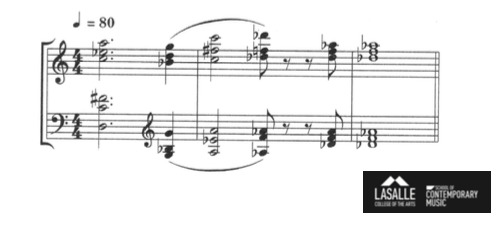
with some minor, incidental rhythmic differences;
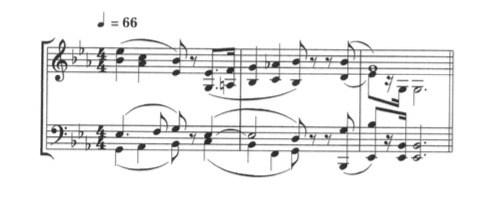
Composite Harmony
2 or more chordal components are layered, each harmonically completely alone
May be treated as harmonically unified or composite
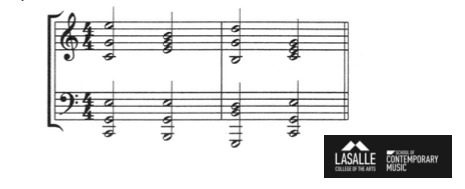
a large vertical distance between the 2 shapes divides it into 2 parts. The harmonic effect is divisive.

The contrary motion of 2 simultaneous chordal units: produces the effect 2 constituent harmonic units
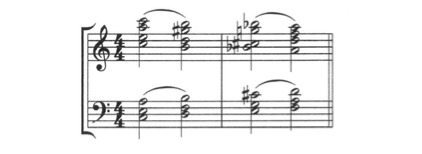
The presence of 2 or more chordal units, with independent rhythms

The effect of unified or divisive harmony depends on these factors:
Tone-quality: the use of a single tone-quality or similar tone-qualities will produce a unified effect
Direction: parallel movements tend to be more unifying than contrary motion
Common rhythms are unifying
Large distances between harmonic units have a divisive effect
Imitative Counterpoint
This involves canonic situations.
To bring out the relationship of imitative parts, one tone-quality should be used.
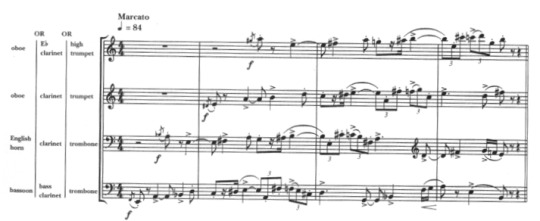
‘Similar’ Counterpoint
This is non-canonic counterpoint.
The parts are related by common rhythmic and intervallic ingredients
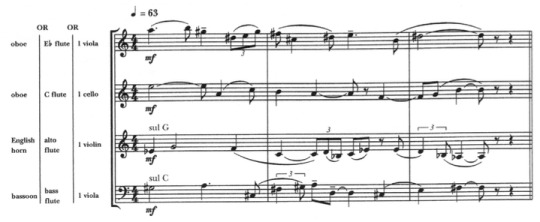
Contrasted Counterpoint
The lines are have noticeable differences in intervals and rhythms
The differences may be accentuated with the use of different timbres

Composite Music Material
A melody with its own rhythm, accompanied by unified harmony in another rhythm, plus composite harmonic interjections:

next example; Imitative counterpoint (piccolo & clarinet) superimposed on unified harmony (strings) in contrasted rhythm, plus a bass line (tuba) in a different rhythm.
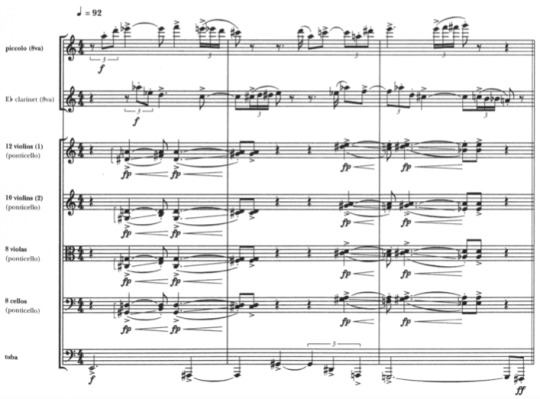
Next example: Composite harmony- violins & violas in 1st group, cellos & basses in 2nd group- enclosing a 2-part ‘similar’counterpoint (2 horns), whose rhythm is different from the harmony.
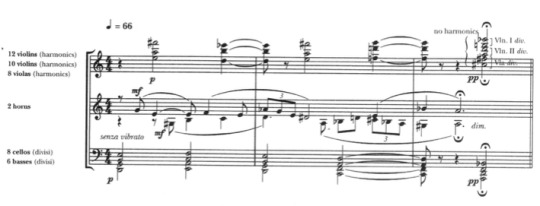
—————————————————————————————
HALF RECITAL
for my Half recital, i submitted 3 pieces out of 4. They were the;
The Bushfire, The Flood, and The Virus (2′20″)
Purple Pinkish Cotton Candy Sky (1′57″)
Full Moon (2′32″)
———————————————————————————
———————————————————————————
———————————————————————————
SEMESTER 2
WEEK 1 || Monday, 18th of January 2021
Topics:
Review semester 1
Scoring for Film, Animation, and Media
Review Semester 1
It was finally the first day of school again! at the beginning of the class, Belinda asked about what we had been doing during the holiday. I personally spent my holiday working on writing 3 shanghai jazz songs for a short film. In addition, I was arranging for lasalle’s Composer’s Concert 2021. Planning the date, concept, musicians (for my own band), and composers who are interested to showcase their pieces at the concert. —— BACK TO THE TOPIC —— Belinda mentioned that she was surprised to hear some of the works from half recital which me and my classmates did and we were happy to hear that! afterwards, the lesson started.
Scoring for Film, Animation, and Media
Finally....SCORING. One of my biggest interest in music is Film Scores. And to be honest with you, the reason i went to Lasalle and took Composition & Arranging as my stream was because i wanted to be a Film Composer. I’ve always dreamed of being one ever since i was young. So, this topic really interest me indeed. I had been looking forward for Belinda to teach this ever since the start of my day 1 studying at lasalle. “Finally... i thought.”
Here are a little summary from it;
Film Scoring — The People
The Producer: responsible for developing and nurturing the project from beginning to end. He hires the proper people, raises money, seems the film. His role is varied and straddles the administrative, financial, and creative.
The Director: responsible for envisioning and approving creative decisions. He wants the score to reflect and enhance the idea of what the film is about.
The Executive Producer: Usually the CEO of the production company. He is not in charge of the daily processes but will exercise final control over all the elements—business and creative.
The Editor: works with the director and cuts, edits his footage into a story flow. He is likely to have a good idea of how the music should fit the footage and can be an excellent liaison between composer and director
The Music Supervisor: handles the administrative part (and sometimes creative) of the music for the film/ TV program. He works with budgets, negotiated deals, hires contractors, arranges recording sessions, etc.
Film Scoring — The Screening
Go in with a notepad
Concentrate on the big picture—the overall emotional effect, the film’s effectiveness
First impressions matter—note them
Get a sense of the mood, feeling
Do not do any spotting yet
Film Scoring — Rough Cut
Establish a concept for the score
Demonstrate that concept the composer
Whilst helpful in providing the composer with a clear musical direction, they can also be a bane when the director is so used to the music that anything else will not satisfy him
Film Scoring — Style & Genre
In every style, genre of film, there is an appropriate response, an expectation, a vocabulary. These expectations are based on a precedent, a thorough study of classic films in a particular genre is essential to successful scoring. It’s not about imitation but about knowing the language and eliciting an appropriate response/reaction.
Film Scoring — Main Genres
Action
Adventure
Animation
Comedy
Crime & Gangster
Drama
Epic/Historical
Fantasy
Horror
Musicals/Dance
Science Fiction (Sci-Fi)
War
Westerns
Film Scoring — The Concept
The concept is the heart of the score. It can be discussed in terms of musical style and will form the basis of the thematic material of the film score. The composers needs to understand the central character and motivations.
There is also another dimension to scoring the character apart from scoring his/her personality, and that is, getting inside the character’s head. That dimension can chance from scene to scene, moment to moment.
On my personal note; i went to surf the internet and read more about this. After reading more about film music, i discovered that film theorists often categorize film music as diegetic or non-diegetic. Diegetic music, the music we perceive the characters can hear, is part of the story world. Meanwhile, Non-Diegetic, also called as commentary or nonliteral sound, is any sounds that does not originate from within the film’s world. Non-Diegetic music (such as a film’s title theme) narrates the film from “outside” the story world and is only audible to the audience. When Belinda mentioned about the music getting inside the character’s head, it can also be referred as diegetic music.
Back to the topic, to summarize, when talking about the concept of the film, it’s important for us the composer to know what the film is really about. Explore the characters and their themes. Often, films will have more than one dramatic theme; a personal theme and a larger overview sort of theme.
another thing to take note is that musical genres/styles are often part of a score and it is IMPORTANT to stay CONSISTENT to those styles throughout the film. Composite style (where several different stylistic elements are fused together) are also permissible but think of the appropriateness of the music to fit what is happening on the screen.
Film Scoring — The Tone
Tone refers to the attitude of the dramatic work. Whether is it dark or uplifting, etc. The composer needs to get a clear direction of tone in order to ‘assist in the storytelling’.
example: “Raiders of the Lost Ark” is a movie whose tone changes drastically from moment to moment: from humor to terror, from impending doom to a swashbuckling escape.
Checklist:
Overall dramatic theme
The central character
other themes
Time (period) / Place / Ethnic flavor
Instrumental Palette
Musical Style
Combination of styles, colors?
personal side note:
Perhaps what i understood about this is that the tone of the music is something that everything revolves around with, and in order to set the tone of the music, we need to understand the concept of the film well enough. Understanding the character, mood, and genre.
The tone can be set by things like our orchestration, instrumentation color palette (timbre), and also the techniques we use to compose like harmonic language and texture.
—————————————————————————————
WEEK 2 || Monday, 25th of January 2021
In week 2, Belinda resumed the topics from week 1. She also discussed more deeply about it. In this week, she also talked about the devices/musical techniques that we should considerate when scoring for a film.
Topics:
Scoring for Film, Animation, and Media (Part 2)
FILM SCORING — ETHNIC, PERIOD
When scoring for films with ethnic/period character, the composer needs to decide if he/she will score totally in that style, just flavored by those musical elements or not influenced by that time and place and all.
In some instances, musicological accuracy is necessary, but most situations call for a combination-approach: ethnic/historical accuracy and other harmonic/melodic language to score the drama and action.
Things to consider:
The film’s point of view
Scales, motifs, folk tunes, harmonies of that ethnicity/ time/ place
Rhythms of that ethnicity/ time / place
Instruments
There us a fine line between authenticity and stating the obvious. Avoid music clichés and other tires and overused references.
FILM SCORING — PLAYING THE DRAMA
Your audience has expectations: as a composer, you need to know what they are before you can use those expectations as tools for manipulation.
You can surprise your audience, but never betray them. Their expectations are tied closely to the function of the score and the style of the movie. The score must do what the audience expects it to do- excite them, lift them up, tug at their heart strings, make them curious, etc.
The composer knows the ending but the audience doesn’t, so it’s really important that the music never “spoils” it or gives too much away.
Whose point of view are you playing? The audience or the character?
If you are playing the audience’s POV, you’re scoring their emotional reaction. If you’re playing the character, then you’re scoring the emotional/ mental state or action that the character is in or is doing.
Main Title: The main title establishes the overall tone and setting for the movie and primes the audience’s expectations.
Dialogue: Underscoring dialogue is tricky as the composer needs to ensure that the dialogue can always be heard and understood. Where the lips can be seen, comprehensibility is easier as the audience can lip read. In instances where the lips cannot be seen, extra care needs to be exercised.
notes on Dialogue:
In general, smooth musical textures are less intrusive. Also, try to keep out of the speaking range.
Stay away from accents and distinct solo lines: allow the spoken line to be the ‘soloist’
Don’t overwrite. It’s an underscore.
MUSIC AND ITS ASSOCIATIONS
Many styles of music already have their visual and emotional associations: Gritty Jazz puts us in a big city, Gregorian chant brings us into a monastery. Use the power of musical associations to get the audience in the right place, in the right state.
for example: the film “Out of Africa” scored by John Barry has the genre of classic romance. The score is associated to the romance rather than about the period film set in Africa.
Musical Points of View
Getting inside the character
De-emphasizing the scene
Juxtaposition—playing against the scene
The minimalist approach (ex: “American Beauty” plastic bag scene by Thomas Newman
Silence
Highlighting, accenting the drama
MUSICAL CONSIDERATIONS
Now that you have a concept for the score, the next step is to translate that concept into musical terms.
The basic elements to consider are melody, harmony, rhythm, and instrumental color.
Unity and Variety
Strong scores strike a fine balance between repetition (recognition) and variety. Repetition in music can help to develop emotional power through the cumulative reactions of the audience to the repetition of a theme. With repetition, the association between the music and the characters/ situation becomes stronger.
The same theme can also be modified/ varied to suit a different setting.
Tempo/Pulse
This is the first task of the composer: to determine the pace of the scene/cue
Checklist:
Does the tempo feel emotionally compatible with the scene?
Does it provide forward motion?
Will it provide too much forward motion?
Is this a comfortable tempo for dialogue?
If the cue calls for tension, play a low repeated note with basic pulse and check if there is dramatic build-up
There are cues/scenes that require a change in pulse and tempo. The composer will need to plot a variable click in those instances.
Hitting/Catching the action
Unless the composer is scoring for cartoon/ animation, he/she will not be catching all the action. This is also known as Mickey-mousing.
The average score catches less and more subtly and often plays through the scene. Composers will score the emotional shifts in the scene, usually subtly, through entry of themes, change in colour, rhythm etc...
Composers need to analyze the scene by taking note of the shifts of emotional emphasis, shifts in action, shifts in camera angles, editorial cuts.
Beginning the Sketch:
Plot out the shifts on your sequence. Note the timings
Decide on the tempo and tempo changes. Plot the click and adjust meters accordingly.
Compose the thematic material for the cue.
Plot it into the sequence. (It may not appear at the beginning of the cue)
Check to see if the entry of the theme is compatible with the visual and shift it/ adjust it until it fits.
Write around the theme- into its entry and after it is stated.
Using the 4 basic elements of melody, harmony, rhythm and instrumental colour, finish writing the cue.
The motif is a powerful compositional tool that composers have used throughout the centuries. The motif allows the composer to write with unity and leaves him/her room for variety.
A strong motif is the key to a strong score.
Examples of strings motifs;
Beethoven’s 5th Symphony
John William’s Jaws
John Barry James Bond- Octopussy
Nino Rota Godfather- Love Theme
John Williams- Return of the Jedi- Darth Vader Theme
Bill Conti- Rocky Fanfare
HARMONIC CONSIDERATIONS
Harmonic language is the emotional palette that composers use to elicit a desired response from the audience.
Triadic shapes and traditional progressions elicit different emotions from atonal and dissonant sources. Composers need to pay attention to the tension or placidity of their harmonic choices and combinations.
Choices:
Diatonic Harmony and Chromatic Harmony
Modal Harmony
Pandiatonicism
Quartal/ Quintal harmony
Exotic/ Synthesized scales
Limited Composition, Hexachords
Polytonality
Atonality/ Serialism
Harmonic Devices:
Vertical Structures (Homophony)
Linear writing (contrapuntal writing)
Pedal points
Ostinato
Complex Texture
—————————————————————————————
WEEK 3 || Monday, 1st of February 2021
Topics:
Influence of Great Composers
17 Functions of Music in Film
INFLUENCE OF GREAT COMPOSERS
In week 3, Belinda showed us some of the most influential composers in the past that also affects film composers nowadays. Some of the composers and their pieces she discussed in the class were;
Stravinsky - “Rite of Spring”
Bartok - “Music for String instruments, Percussion and Celesta”
Orff - “Carmina Burana”
Brahms - ”Symphony No. 3, 3rd movement”
In the class we discussed and analysed about the musical devices that are happening in the pieces. like;
The melodies, lines, motives and identity, motivic development
The harmonies, harmonic devices; harmonic language as an emotional device
Rhythmic devices; rhythm as a thematic idea, uneven meter, polyrhythms
Orchestral devices; orchestration as a tool for characterization/setting, orchestration as an emotional device.
17 FUNCTIONS OF MUSIC IN FILM
1. Commenting
This is a function that shouldn’t be overdone. Music can put a judgement on certain movie scenes, it can state that a certain battle scene is heroic, a certain dialogue is sad etc.
In the early days of film music, the function of the music was most of the time to comment on the images. Nowadays we perceive this as an annoying redundancy most of the time but used cleverly it will help push the audience into the right direction.
2. Illustrating Movement
Another function that feels rather old fashioned and comedy. Accenting with the music every movement seen on screen is so-called mickey-mousing (coming from a scoring technique that was often used in Mickey Mouse cartoons). Hearing xylophone “plings” when someone raises his eyebrow etc. feels very cartoony however it can be great in slapstick moments and when done well even in dramatic situations.
3. Creating Plot Relationships
The use of so-called leitmotifs has been established by Richard Wagner in the opera and has often be used in film context since the early days of film music. Giving certain characters/situations/places thematic identities helps to connect certain plot points together.
When the villain gets a theme and later we hear that theme again when somebody talks about a “stranger” we get a very clear hint of who that stranger might be. It doesn’t need to be that obvious for leitmotifs to work, of course. However, be warned to not overdo that technique. Not every supporting role needs a motif/theme and it can quickly feel very old fashioned when using this method extensively.
4. Creating Atmosphere
This is one of the strongest function of music in the movies. It can set the tone of the movie. Just by the way the score comes in for the first time in the movie makes it possible to know the genre and the “level of drama” of the movie. Of course exactly this really strong function can be used to create plot twists.
5. Portray Emotions
Another very strong function. Music can serve the movie by getting into the emotions of the characters. A face with a neutral expression can be pushed into “feeling” many different things just by what kind of music is used. In the same way it works of course very well to evoke certain emotions with the audience.
6. Social/Cultural/Geographical references
Music can work very well to make clear the heritage of a character/group of characters or the geographic setting of the movie or a scene. Often so-called pseudo authenticity is used that uses music that feels like a certain location to western ears as opposed to actual music that can be heard at that location (which differs quite heavily sometimes).
If for example Irish sounding music can be heard during a certain scene etc. we can easily spot where it’s taking place without the need of visually establishing the location too much.
7. Time/Period references
Music can also work very well to establish a certain time or period. Music that sounds very baroque will put us back into the 18th century but references can also be more subtle. Flashbacks over a few decades for for example can be very well supported by the musical style which adapts to the time portrayed in the movie and therefore makes the flashbacks more understandable.
8. Connects scenes, montages
Music helps very well to glue scenes together. Rather harsh scene changes can be softened by adding music over the scene change. One of the extremes of these forms are montages which work beautiful with music. Even though we might have a lot of jumps in time/places or even periods, when the montage is covered under one score cue it will at the same time be glued together and understood as a whole.
9. Manipulate
One of the functions of music that is and has been used quite a lot, even though it is not one of the most noble functions of music. Doubtful contents of a movie can be pushed into the “right” direction by music as it has been seen with lots of propaganda movies from all periods of times. However it can also be used very cleverly. For example when a character that is being portrayed as “the good guy” but actually is the villain.
However in this case this fact will only be revealed at the end of the movie. Any moment before where the audience might get trapped into maybe thinking that he might be the evil guy, the music can jump in and manipulate in the way of working against these doubts.
10. Alternate the Perception of Time
The perception of time is a fantastic playground for music. Just by altering the tempo of music, it can heavily push or drag any scene. Imagine a chase sequence where the music pushed with lots of tempo, exciting orchestration etc. compared to the same sequence with a calm, slow music. The latter one would almost feel like it’s real but it would make the scene way less exciting. Same goes for any time perception. A scene where we see a person waiting which lasts only 30 seconds can be extended painfully in the perception by the music.
11. Imply a sense of space
Not only the perception of time but also the perception of space can be influenced by the music. Using a very intimate piano+violin duo on a space science fiction movie might seem just as wrong as using a full symphony orchestra in a two character movie that’s taking place in a small flat. Also by the use of register (very deep sub bass or very high violin notes as opposed to music that plays mainly in the middle registers) can leave an impression of “size”.
12. Creating unreal situations
Characterizing nightmares or situations of shock or being paralyzed can be done perfectly by the music. Anything that gives the feeling of not being real can be greatly enhanced by the music. Nightmares of characters can be made much more impressive with the right music.
13. Creating Contradictions
Music that sounds like something that is not expected in a certain scene will create a feeling of “something is not right”. It works great for example on dialogues that are actually neutral from the content of what is being said. However having a really dark and sinister music under this scene will leave the impression that something will be happening, something might be wrong here.
14. Parody
Music can influence very strongly whether we find a scene to be serious or laughable. It can use this ability to create fantastic parodies of characters or situations in the movie. One very simple example would be a character who pretends to be very evil and acts like this, however the music just gives him/her a quirky wannabe-evil march.
15. Physiological Conditioning
Music can also influence and stimulate our very basic emotions like fear and therefore evoke in a best case scenario every physiological consequence that comes with that emotion like racing heart, sweaty hands etc. Especially in the genre of horror and thriller, these effects are used extensively. A certain level of volume will make it impossible for the body and the conscious mind to detach from these emotions.
16. Implying Size Relationships
A little boy walking alone through a huge city is just a scene that might be very suitable for this use of film music. In this case the music can enlarge the visual differences between these things by giving the boy a little innocent flute motif on top of a very low, boiling music which might symbolize the huge city. In this way, things that can’t be seen like that on the screen can be set into relationship.
If this little innocent boy from above might actually be a really brave, heroic person who has done or is about to do big things the music might set him into another “size” dimension to the city even though the images don’t reveal that yet.
17. Psychologically Uniting The Audience
One of the most obvious case of such a function of music are national anthems whose function of course also is, to unite the “nation”. The same works in the music. Especially euphoric, heroic emotions can be used very effectively to get this collective emotion. Often, well known songs/music pieces can be used for that as they are easier accessible than music that the audience hears for the first time.
However, even a very heroic score cue on top of a scene where the heroes of the movie walk through a crowd applauding a cheering at them after they fought the last big battle and won can create exactly this collective feeling of having been part of all that also with the audience.
———————————————————————————
WEEK 4 || Monday, 8th of February 2021
In week 4, Belinda delve deeper into the topic she discussed briefly in week 2 about musical considerations.
Topics:
continuity from week 2—
Musical Considerations
Melodic & Harmonic Considerations
Rhythmic Considerations
Orchestral Considerations
Scoring Examples
When discussing about HARMONIC CONSIDERATIONS, Belinda showed us some examples of good scores, like;
John Williams: Star Wars- The War Reel 1 Part 3
E.T.- The Departure
Jerry Goldsmith: The Omen- The Demise of Mrs Baylock [Youtube- The Omen Pt 8, 1:05]
The Omen- Ave Satani
Michael Small: Star Chamber- Main Title
and when discussing about RHYTHMIC CONSIDERATIONS, she showed us a reference from
Omen- Altar of Sacrifice
Hans Zimmer- Man of Steel (Drums sessions) and Oil Rig, Tornado
The first reference is to showed that rhythm can be a powerful thematic idea on its own. Rhythmic ostinatos are often employed to provide drive and forward motion. Whereas the second reference showed that the percussion section can bring into the score its own color, texture, dynamics, and emotion.
things to note:
Composers should explore asymmetric meters for variety or when the cue calls for a less even rhythmic pattern.
Aleatoric rhythms (improvised) may also be explored as long as the emotional/ dramatic direction of the cue is clearly indicated to the musicians.
ORCHESRAL CONSIDERATIONS
Orchestral colour is a powerful emotional tool. After answering the initial questions: What kind of music does this need? What tempo is this?
The next most important question is: What kind of sound does this need?
Belinda discussed about the how the size of an ensembleand how it affects the sound and the mood. She also gives reference of different scores with contrasting orchestration palette. some of them were;
Vangelis- Chariots of Fire
Daft Punk- Tron Legacy (Mixed- electronic and
Orchestral)
Trent Reznor (Nine Inch Nails) & Atticus Ross- The Social Network
things to take note:
A change in orchestral colour will cause an emotional/ dramatic shift.
A theme can take on different meanings with different orchestration treatments.
Apart from typical idiomatic colours, there are also special effects and extended techniques that can be employed today to inject drama and emotion in new and fresh ways.
The best way to learn how to orchestrate is to study orchestral scores of the Masters, especially the scores of the Romantic and Late romantic composers.
Pay attention to their use of colour, balance, weight, span, sonority, transparency and other orchestral devices.
———————————————————————————————————
Week 5 || Monday, 15th of February 2021
First of all, i was excited for the lesson by seeing the topics list that Belinda showed before the class. Because Neoclassicism has always been apart of my writing style and i draw a great amount of inspirations from the Neoclassicism composers, especially William Schuman. Although Belinda has taught us in Year 2 about this and mentioned it quite a few times, but it was a very good refresher to learn about this again and listened to her explaining about it.
Topics:
Neoclassicism
Score Analyses:
- Stravinsky: Symphony in C
- Hindemith: Mathis der Maler
- Schuman - Symphony No.3
NEOCLASSICISM
basic Information:
A return to ‘Classicism’- to clarity, order, balance, economy, and emotional
restraint.
A reaction to the emotional excesses of Romanticism and dissonance of atonal 20th Century musical movement.
Emphasis on form, rhythm, contrapuntal texture, updated/ expanded harmony
Started between the 2 world wars- 1923 to1950
Composers & Works
Pulcinella — Stravinsky
Symphony in C — Stravinsky
Mathis der Maler — Hindemith
Appalachian Spring — Aaron Copland
Symphony No.5 — Prokofiev
Symphony No.3 — Roy Harris
Symphony No.3 — William Schuman
Menu of Compositional Devices
Common Practice Tonal Centres — Major and Minor
Chord Extensions — 9ths, 11ths, 13ths, and alterations
Added note chords
Chromaticism and Tonal Ambiguity
Meter-Mixed and Asymmetric Meter
Modes and other scale sources, including Synthetic scales
Polyharmony— polytonality and polychords
Non-tertian Harmony — Quartal and Quintal
Scandal Chords — clusters
Parallelism
12-tone Technique and Serialism
Limited Composition — based on intervals
Hexachord Writing
Unrelated Triads
Mirror Writing
Harmonic Direction — progression, cadential devices
Harmonic Synthesis
Indeterminate Procedures
Noise, Sound, and Electronic devices
Extended Techniques
Texture
Microtones
SCORE ANALYSIS
my thought:
I loved the examples that Belinda showed. But my favorite would be Roy Harris’s Symphony No.3. Belinda showed us this technique called “micropolyphony” or actually complex texture. There’s this section from the piece at timecode 7:00 (in youtube) where Harris used the micropolyphony and it sounded beautiful. Although every part plays different notes, but the section just sounded beautifully because their parts shared the same pitch classes. After learning about this technique, I straightly have an idea to use it in one of my recital pieces “The Rain and The Rainbow”. To feature it in the Rain part.
———————————————————————————————————
WEEK 6 || Monday, 22nd of February 2021
This week, Belinda taught us the importance of analysis and how you can benefit greatly from it. I totally agree with the idea of analysis. Whenever i writing something, usually i would always draw and idea from a music that i like. After listening to the music, usually i would transcribe the section that i like then i always learn something from it. In a way i also analyzed it. Even though only in a small chunk, but i benefit so much from it.
Topics:
Analyses: What are you looking for? What are you looking at?
Texture & Timbres
WHY ANALYSE
You’ve heard of the phrase/ method, “reading to write”, which refers to the practice of reading for the purpose of becoming a good writer.
There is an equivalent in music, and that is, analysing scores for the purpose of becoming a better composer.
We begin by developing the habit of listening to good music, and allowing the music to open our ears to good compositional and orchestral devices.
We learn/ imbibe a lot through ‘osmosis’, through a process of immersion. If we immerse ourselves in good music, some of that inspired style and musical eloquence may just seep into our subconscious.
With the score, we then apply analytical skills to better understand how the parts work together to make up the beautiful whole.
A good method for analysis is the ‘Funnel Method’- by starting with the big ideas, broad strokes first, then working through the piece with greater specificity and detail.
A good place to start is the concept of the composition, the purpose or intention for the piece.
Form and structure would be the next logical parameter for analysis: sectional form, phrasal structure and transitions.
Thematic analysis, primary and secondary materials, development and variation would be next.
Texture and Density would follow.
Orchestration, timbre, orchestral devices should be examined.
Rhythm, Meter, Articulation and other devices associated with movement, momentum should be examined.
At all times, dynamics and emotional contour should be observed and all the elements mentioned above taken into consideration.
Don’t forget to ‘pull back’ and take note of the balance of unity and contrast in the composition.
How does the composer achieve cohesion in this piece?
Is the piece comprehensible? If so, how does the composer achieve this comprehensibility?
Annotate, annotate, annotate.
Take note of first impressions and latter impressions.
Compare your analyses with others, share and compare notes.
Listen to various recordings/ conductors you can glean different things from different interpretations
Make a note or make sketches of ideas you can ‘borrow’
TEXTURE & TIMBRES
Texture is the combinations of pitch, timbre, and rhythm
Common categorization of texture: Homophony, Polyphony & Complex
Considerations:
Harmonic/scalar language
Density
Intervallic Relationships
Belinda showed us examples of different textures from different pieces. My favorite of the Micropolyphony examplewould still be in Roy Harris’ Symphony No.3 (timecode 7:00 on youtube).
—————————————————————————————WEEK 7 || Monday, 1st of March 2021
Topics:
Debrief — Composers Concert
Character, Mood, and Emotion
DEBRIEF — COMPOSERS CONCERT
Belinda talked about what went well and not from our Composers Concert 2021.
notes:
As of my piece “Mrs. Puss” that was performed, Belinda told me that the Violin in the piece was quite soft whereas it supposed to be louder since it played some lead lines. I agreed to that, however it wasn’t because of the playing, but was because of the sound that was coming out from the speaker that the audience heard. To me (as the musician who also played together in the band), the Violin sounded okay from my perspective. I was hoping that that they will adjust that in the mixing post-production.
Khushi and Matt also had the same issue with the balancing. But really it was more of the mixing.
Another issue that they were facing was muddiness.
As of the other pieces (string quartet), Belinda referred many of it to be not-so cohesive and comprehensible. and that is one of the key takeaway that we can learn from. The solution lies in the composer himself actually.
Belinda told us that when a piece is cohesive and comprehensible, you won’t notice it, but when it is not then you’ll notice that. I understood what she meant and that’s what i also felt like when hearing the pieces for the first time in the google drive that was shared to me.
A few miscommunication between me and my other peers. Can be improved.
Otherwise, it was a quite successful show. Now just waiting for the release date!!!
regarding the issues that we had (compositionally), Belinda gave us notes about a few things which we can learn and apply it when we’re writing for our pieces for our final recital;
FOCUS & DIRECTION
Intentionality
Focal line(s), focal sound?
Unity (the constant) vs Contrat (variation) beyond the structural, the vamp, the progression. Where are you taking the listener?
Emotional Contour — shape and climax(es)
Pace—maintaining and building momentum
ARTICULATION, DYNAMICS, AND EXECUTION
Ensemble playing & hits:
Accents — the long & short of it
Communication & Tightness
Contrast hits with flow, unison with open voicings
Tight with dynamics, play with changing dynamics
Contrat quick passage with space and breath
regarding communication and tightness, Belinda also critique about my band’s articulation. She told me that my double bassist in the band (Eugene) seemed to be the only who gave the correct articulation whereas the others are too focused in playing the right notes. I mean, playing the right notes is crucial, but afterwards you should learn how to enjoy the song. Honestly, i head bopping and trying to enjoy the piece too, but i guess its true that i was still too afraid to play wrong notes and my gestures was too small. And i guess hm my head bopping was some sort of....hmm..how should i say it.. only gimmick? and perhaps that showed too.
VERTICALS & SONORITY
Pay attention to register- close intervals at lower registers will sound muddy
If the verticals are ‘hot’, it will sound muddier!
Use polytonality with intention & caution. Control dissonances, voice appropriately.
Combine familiar shapes (e.g. triads & quartals) to construct polyharmonies
FORM
The most complex of compositions can be comprehended if FORM is apparent
Pay attention to constructing clear sections (that flow/ transition cohesively)
Pay attention to building & developing motives/ themes: maintaining unity, yet creating diversity/ contrast
important questions:
What am i saying?
How am i saying it?
Finally, Belinda linked it to the lesson——————
CHARACTER, MOOD, AND EMOTION
Music and extra-musical associations
Clarity of expression
Tools:
Melodic line(s)
Harmony/ Verticals
Texture
Orchestral color & devices
All about sound:
The overtones series-consonances and dissonances
Melodic and motivic ideas: steps, skips, and leaps
Intervallic tendencies
Melodic Shape and Contour
Phrasing, Cadences, and Breath
Primary, Subsidiary
Harmonic Language—
Tonality (poly, neo)
Atonality, Key/Mode Colours
Chord/Vertical Colours
Rhythm—
Pulse, Tempo, Natural rhythms
Momentum
Duple/Triple and Asymmetric Meter
Subdivisions, Triplets
Orchestration—
Orchestral Colors
Orchestral Devices
Orchestral Elements and Texture
Form and Structure—
Organization
Development
Sense of Unity
Recognition, Logic, Cohesion, Comprehensibility
FINAL RECITAL
finally Belinda briefly talked about our Final Recital and some checklists;
String Quartet
Wind Quartet: Flute, Oboe, Clarinet, Bassoon
Optional: laptop playback
Possible Combinations:
Full ensemble + Laptop playback
String Quartet
Featured Wind(s) with Strings Quartet
Featured String with Wind ensemble
—————————————————————————————WEEK 8 || Monday, 8th of March 2021
NO LESSON.
—————————————————————————————
WEEK 9 || Monday, 15th of March 2021
Topics:
Key Centers/tonal Centres
Shifting Tonalities
Neotonality
KEY CENTRES
There are many degrees of key center gravity or keylessness
Apart from chordal progression, melodic direction, repetition of notes and instrumentation can suggest/emphasize tonality
MODULATION
The concept of Modulation is based on the relatedness of any chord to any of the 12 tonal centers.
‘Traditional modulations’ are based on pivotal chords.
‘Less traditional modulations’ may be abrupt parallel shifts or based on looser pivots, such as pivot notes and then softened by voice-leading.
POLYTONALITY
Be careful that the combined effect does not produce a haphazard sound. The music must be conceived in polytonal context and not sound accidental.
The composer needs to work this in a ‘total organization’ framework, paying attention to tonal planes.
The Harmonic total must have a sense of direction, flow, tension design and textural consistency.
Use spacing, register, texture and omission to create clarity and avoid muddiness.
examples of displaced tonality;
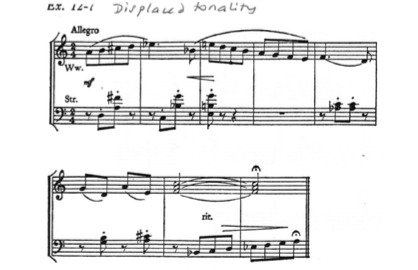
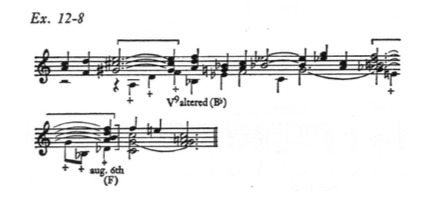
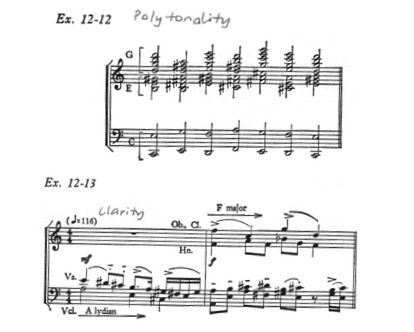
SERIAL HARMONY
The choice of notes in Serial Harmony are either dependent on the row (Total Organization) or include endless possibilities if the method of serial composition is less strict.
Intervallic relationships: consonances and dissonances are important factors in deciding how verticals are formed.
Melodic direction, voice-leading and texture also determine the overall effect of sonorities.
Motivic/ thematic features support cohesion and comprehensibility.
Rhythmic features and articulation are prominent characteristics.
examples of serial harmony;
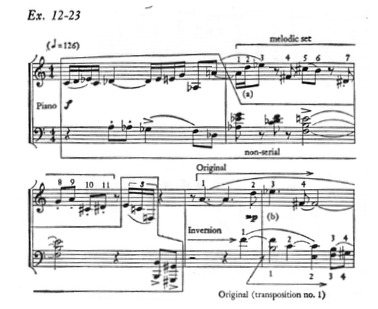
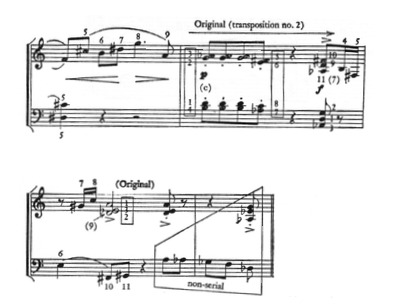

NEOTONALITY
Tonality that is not based on any particular diatonic system nor functional harmony (Common Practice Period)
Features non-traditional concepts such as tonal assertion or contrapuntal movement around a tonal centre (which may shift).
Combining the features of Common Practice Period tonality with 20th Century tonal ambiguity and atonal characteristics
Neotonal Composers
Stravinsky
Bartok
Kodaly
Janacek (maleva likes him)
Vaughn Williams
Prokovief
Shostakovich
Hindemith (maleva likes him too)
Samuel Barber
Villa-Lobos
Ginastera
William Schuman (MALEVA’S FAVORITE)
Roy Harris
William Walton
personal note:
on my personal note, i listen to these composers during my free time. and i found my pieces that really interest me. Some even has become my own personal “temp track” for my recital pieces! for example; Janacek’s “The Cunning Little Vixen: II. Allegro” was my inspiration when writing my piece “Purple-Pinkish Cotton Candy Sky” and “Full Moon”. Other than Janacek, I also took great inspiration from pieces from William Schuman, and others! Don't believe me?? Look at my SPOTIFY PLAYLIST!!! i legitly made playlists for each of the pieces that i want to write. I collect pieces that inspires me the most and built my creativity based on that.
maleva’s playlists for “Purple Pinkish Cotton Candy Sky”;
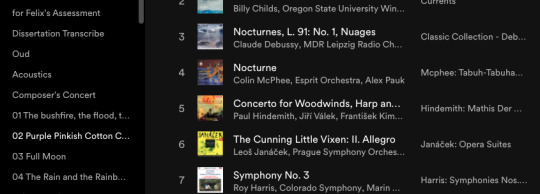
maleva’s playlists for “Full Moon”
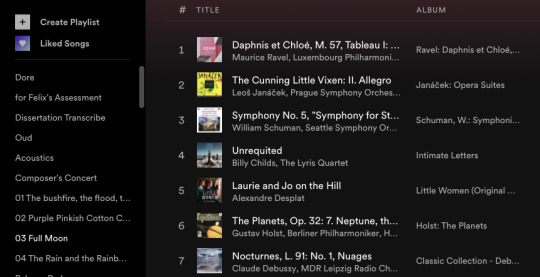
BACK TO THE LESSON;
at the end of the class, Belinda finalised the instruments that we will be having for our recital and remind us again regarding some checklists.
—————————————————————————————
WEEK 10 || Monday, 22nd of March 2021
This week’s class was so interesting, as we dissected the piece of our own BELINDA titled JOB
Topics:
Deconstructing JOB — A Symphonic Dance
Thinking timbrally
JOB — A SYMPHONIC DANCE
form
narrative driven
Dance form
“Through-composed”
Thematic thread
sections in order;
Parade of the Celestials
Gigue of the Adversary
The Challenge
Sabean Attack
Chaldean Attack
The Wind-Collapse-The Sores-Job’s Wife’s Curse
Sitting in Silence
Duet (Dialogue 1)
Dialogue2
Dialogue 3
The Whirlwind
My Eyes Sees Thee
Repent and Retract
Coda-Allegretto
THINKING TIMBRALLY
Wind Quintet & String Quartet configurations
Woodwind
Individual characteristics-flutey, reedy, hollow
Combines timbres
Dove-tailing
Spacing
Register and Dynamics
Harmonic balance
Unison and Doublings
Strings
Individual characteristics
Spacing
Harmonic balance
Register and Dynamics
Unison and Doublings
Combinations
Timbral combinations
Oboe & Cello
Bassoon & Cello
Flute and French Horn
Solo Wind with Strings
Solo Strings with Wind Ensemble
Contrapuntal, mul-timbral applications
Textures: harmonic textures, contrapuntal streams
Percussion & Miscellaneous
Definite and Indefinite pitch writing
Accents, shimmer, highlights, weight
As a features instrument
Orchestration Principles
Balance: feature, main, secondary...
Dynamic and emotional contour
Clarity
Span, register
Weight, Float
Interest
Momentum
Readability
—————————————————————————————
WEEK 11 || Monday, 29th of March 2021
Topics:
Review Form
Analyze Stravinsky’s Babel
Analyze Schwanter’s Aftertones of Infinity
FORM
Binary Form: A B
Ternary Form: A1 B A2
Sonata Form;
Exposition: 1st Subject/ Transition/ 2nd Subject/ Codetta
Development
Recapitulation: 1st Subject/ Transition/ 2nd Subject/ Coda
Simple Rondo Form: A1 B A2 C A3
Rondo-Sonata Form
Exposition: 1st Subject/ Transition/ 2nd Subject/ 1st Subject
Development
Recapitulation: 1st Subject/ Transition/ 2nd Subject/ 1st Subject/ Coda
Theme and Variation: featuring a main theme followed by altered iterations
Passacaglia: A series of variations over a basso ostinato
STRAVINSKY — BABEL
texture and density
Ostinato
Verticals
Chorale treatment
Narrative-Form
Momentum and Motion
SCHWANTER — AFTERTONES OF INFINITY
** i think this piece is amazing. Belinda also mentioned that this piece won a Nobel prize! there were a few things to take note of like;
Shimmering musical timbres
Layers of Sound
Protoset: C#-A-F-Gb-C-B-Ab-Eb-D
Predominant intervals
can be watched from here;
https://www.youtube.com/watch?v=Sns6KLvrb_o
—————————————————————————————
WEEK 12 || Monday, 5th of April 2021
Topics:
Review Compositional Devices
Analyze Toru Takemitsu’s A Flock Descends into a Pentogonal Garden
COMPOSITIONAL DEVICES
Common Practice Tonal Centers- Major and Minor
Chord Extensions- 9ths, 11ths, 13ths and alterations
Added note chords
Chromaticism and Tonal Ambiguity
Meter- Mixed and Asymmetric Meter
Modes and other Scale sources, including Synthetic scales
Polyharmony- polytonality and polychords
Non-tertian Harmony- Quartal and Quintal
Secundal Chords- clusters
Parallelism
12-tone Technique and Serialism
Limited Composition- based on intervals
Hexachord Writing
Unrelated Triads
Mirror Writing
Harmonic Direction- progression, cadential devices
Harmonic Synthesis
Indeterminate Procedures
Noise, Sound & Electronic devices
Extended Techniques
Texture
Microtones
TORU TAKEMITSU
Belinda mentioned how amazing that Takemitsu — although his music is very modern, but he would always never lose his Japanese touches in his music. Belinda also mentioned us about the importance of having a signature sound in our music. And it’s good if we can feature our own identity like where we come from for example.
Takemitsu’s music:
Straddled “parallel music cultures.”
Bi-musicality in modern Japanese culture: mixture of Western music with traditional Japanese music
In this piece, he uses the pentatonic scale (called the yo scale in Japanese.)
TORU TAKEMITSU — A FLOCK DESCENDS INTO A PENTOGONAL GARDEN
Clustered verticals
Silvery glisses
Lyrical melodies
Metallic, bell-like textures
Pentatonic base: C#- Eb- F#- Ab- Bb
Belinda also showed us some examples of some Contemporary String Quartets pieces;
String Quartet No. 2, "musica instrumentalis": III. Double Triple Gigue Fugue- by Aaron Jay Kernis, performed by Jasper String Quartet
link: https://www.youtube.com/watch?v=Y1dxsWGrtzQ
String Quartet No. 1, Op. 8: IV. Fugue- by Alan Hovhaness, performed by Shanghai Quartet
link: https://www.youtube.com/watch?v=VTQmztjK_2g
Love letters for String Quartet by Carter Pann, performed by Ying Quartet
link: https://www.youtube.com/watch?v=ER0faKEz0Ss
my personal note;
The “Love Letters” by Carter Pann was my personal favorite and i even listened back to it after the class ended.
—————————————————————————————
WEEK 13 to WEEK 16
throughout these weeks we had no more lessons but more consultation for our final recital.
0 notes
Text
On My Mind Today
I’ve been thinking back to a couple incidents in my past that, if they didn’t happen one right after the other, happened within a week of one another, and are tellingly relevant in light of everything happening. This all happened when I was working as a part-time paratransit bus driver for the City of Midland’s Dial-a-Ride while I was living at home and taking classes at Delta College.
Incident, the First
We had some annual safety training that had me on my way to work on a Saturday afternoon that I normally wouldn’t have been working on. I was headed out toward work on Saginaw Road (a major, 5-lane road), and noticed that there was a police officer behind me at some point. I knew I wasn’t speeding or anything, so I didn’t think anything of it. I was going to stop at an ATM to get some cash on my way in, so I moved over to the left lane to be prepared to make the left into the ATM in a little while, and the police officer followed suit. Weird, I thought, but again, I knew I wasn’t doing anything wrong. Then he flipped his lights and siren on, and I pull over, assuming that he’s off to some call someplace else (because, again, I know I’m not doing anything wrong).
He’s not though.
He’s pulling me over.
We go through the license and registration song and dance, and he notices that the car is registered to my dad, who was the fleet supervisor for the City and therefore literally knew every cop in town. Once we establish that relationship, he tells me that he ran my (vanity) plate, and it came back registered to a 2001 Dodge Stratus from Livonia, while I was driving a 1986 Dodge Diplomat (ironically a former police car).
Meanwhile, anxious person that I am, I’m freaking out thinking that I’m about to go to jail for driving with a stolen plate. I know I’m completely in the right, and that this must just be some kind of clerical error, but also that it’s probably enough to arrest me for. When he comes back to return my documents, the officer assures me that it’s probably just an issue with the Secretary of State’s records, and sends me on my way. A few weeks later my dad was pulled over while driving the car because they ran the plate, but this time it came back completely unregistered. After even less hassle than I had (and certainly even less anxiety), he too was sent on his way.
Incident, the Second
There’s a lot less to the story of this one, but so much more that comes from it.
One of the many trainings we were going through that week was led by an officer from the Midland PD. I imagine it was likely about traffic safety or something, but I honestly don’t recall at this point. The thing that sticks with me now is that he told us he became a police officer so that he could “drive fast and shoot things” and that “any cop who tells you different is lying”.
Reflecting on Privilege
The only reason the first incident played out for me the way it did, is because I’m white.
I don’t necessarily mean that the end result would have been different for someone who isn’t white, but that the way I felt in the moment, and the tone of the interactions wouldn’t have been the same.
I’m sure that a young black man in my same position would have been immediately on alert as soon as the officer pulled behind him. He’d have been even more worried when the officer followed his lane change, and he’d have known that he was being pulled over as soon as those light came on. This is all assuming he made it that far without being stopped already. I know that because I’ve heard countless stories of black people living it, of black parents teaching their kids from as early as they can begin to understand it how to protect themselves when interacting with police. Because they know the chances are all too good that they’ll be harassed for no reason, and that harassment can easily escalate to their lives being in danger.
Once he was stopped, he almost certainly wouldn’t have had the advantage of being the son of a well-regarded, mid-level civil servant to help ease the tension, not in Midland. There just aren’t many black people here, and for the most part those I knew were from families with white collar Dow or Dow-adjacent parents, families who had already done better for themselves than being municipal workers. My dad had that job in no small part because of generations of privilege that went into the opportunities he had throughout his life, opportunities that would have been much less likely if he wasn’t white.
Even if the outcome was the same, the fear wouldn’t have been.
I was afraid. I thought I was about to go to jail. But never once did I fear that that would mean my life or my physical safety would be at risk. I certainly was never afraid that I’d never leave that traffic stop alive, yet I know that in that situation a young black man would be totally rational to feel that way.
Even now, I don’t drive to work thinking that I’m going to get pulled over when I’m not doing anything wrong because I’ve already recounted the 2 times I’ve ever heard of that happening to a white person. But I know that black people have the justifiable fear that they could be stopped for any reason or no reason whenever they leave their house.
And that’s the privilege I have for my whiteness. The privilege to go about my business free from fear. The privilege to have opportunities that others won’t because generations of systemic racism have made it so. I was raised denying that privilege, but it’s so blindingly obvious, and I don’t know how to open the eyes of people who can’t see it.
But I’m going to try and learn how to. And I’m going to do what I can with that privilege to help make sure my children don’t have the privilege that I do, and their children less still. I want my children to succeed, but not at the expense of other children missing the opportunities they need to succeed. I know that centuries-old systems aren’t easily or instantly undone, but if we do what we can, we can make sure we’re always moving things in the right direction; and if we all do what we can, we can get to the end a lot faster.
Reflecting on Policing
As much as the first incident in all its detail helps to clarify the privilege I have, the second incident lays bare the roots of the problem being protested across the world now. In the ideal, the police are supposed to protect and serve their communities, so you would think that the people who sought that job — that dangerous, life-threatening job — would have those selfless ideals in mind when they joined. Instead, we have it on good authority that they actually join to “drive fast and shoot things”.
Even if you grant that some police officers do have selfless service as their goal, the system and culture of policing is clearly such that an officer felt comfortable saying that to a few dozen municipal workers, speaking for all police officers. That clearly shows that, whatever one officer might think, the police as a whole to not have service as their calling, but rather impunity.
But the thing that’s really sticking with me today, the thing that tells me that the police, as a system, are rotten to their core is “shoot things”.
Things
The police don’t carry guns to protect themselves and the public from inanimate objects, they carry guns (ostensibly) to protect themselves and the public from other people. People who wish to do harm, to be sure, people who are posing a threat, but still people. This level of dehumanization is what leads to the brutality we’re seeing played out across the country, and the casualness with which that officer laid it out, is all the more troubling.
And that was 15-20 years ago. Before we had militarized the police with the surpluses of wars we should never have fought, before the President of the United States openly called for abuse of citizens in police custody, and regularly dehumanized those he finds undesirable.
The system of policing in this country must be torn up, root and stem, and remade as something that really does reflect the ideals it claims to hold: to serve and protect. I don’t know how that happens, but the evidence that it must only gets stronger by the day, even by the hour.
Reflecting on Myself
I’m ashamed to say that I thought that officer’s comment about why he became one was pretty funny at the time, and nothing — not my youth, not my ignorance, and certainly not my privileged upbringing and place in society — excuses that. I’ve grown a lot, and am a much better person than I was then, but I’m still not as good as I should be or could be.
I can admit — again, ashamedly — that I’m still more uncomfortable and suspicious if I’m in a place with a lot of black people where I’m in the minority.
I don’t want to be, I know logically I have no reason to be, and I try and fight those feelings as much as possible.
I know I’m just anxious around strangers generally, and the less I can readily find in common with people, the more anxious I’ll be, and that’s a big part of it.
I’ve also been brought up in a system that’s undeniably racist, and from which I’ve derived immense privilege, and that’s another big part of it.
But none of that excuses it, because there is no excuse for it, it’s just wrong.
But I’m trying to be better. Better for myself, better for my family, better for the world.
I know I’m getting better because I recognize that I have a problem, and when I look around that seems to be more than a lot of people can muster.
I know I’m getting better because “what can I do?” has gone from a resigned rhetorical, to something I’m actively looking for answers to.
I know I’m getting better, but I still have a long way to go.
0 notes
Text
22nd May - Evaluation
Original objectives
1) Create a 10 track album that conveys the story of Paradise Lost.
This goal appears to be met fairly successfully perhaps to a greater degree than was initially anticipated.
It was initially decided that leitmotivs would not be used as the combination of leitmotiv and characterised instrumentation may result in too much repetition throughout the album. However, a variety of production/compositional methods, including leitmotivs, instrumentation, textures and harmonies were used to represent the variety of components of the story, including, characters, events, environments and forces. Repetitiveness was reduced by using different methods for different components such as leitmotivs for The Son of God and judgement day, and instrumentation for Adam and Eve.
The use of instrumentation was good although the fact there was a lack of consistency in the source for each instrument. For example, almost all the cello parts were played by one cellist, however, there was less consistency in the sourcing of the flute parts. For example, in track 2, the flute is played with a flute sampler instrument, in tracks 3, 8 and 10 it was recorded by the flautist and in track 7 an old folk flute sample was chopped up. Although this provides variation, a lack of consistency with the themes takes away from the cohesiveness of the project.
2) Incorporate at least 5 pre-existing compositions into the album, the subject matter of which relates to the subject matter of the track it is incorporated into
As the project progressed, this objective seemed less relevant for reasons discussed in the 'Dies Irae' journal entry. There were some instances, such as with the Dies Irae, where referencing a religiously and culturally significant theme seemed very appropriate. However, the more trivial references which were originally going to be included, such as to Saint Seans aviary (1886) theme for the presence of birds in track six, were left out as they seemed unnecessary. Despite these omissions, this goal was still exceeded using the following compositions:
Track 5: Included 8 religiously significant compositions by renaissance composers as discussed in the '14th February' entry.
Track 6: Included one of the more trivial references which was the opening of Debussy's 'The Sea' (1905), heard in the chords at 3:00. Although this was a trivial reference, it was kept in the album purely because it sounded good.
Track 9: The whole piece is based around the Dies Irae theme as discussed in the '8th April' entry.
3) Develop knowledge of music theory and the compositional techniques used in European piano and orchestral music
Reading Persichetti's book Twentieth Century harmony (1978) led to a greater understanding of intervals, modes and overtones as well as inspiring many experiments in harmony, the products of which found their way into the album.
My dissertation, the topic of which was Debussy's harmony, also lead to many discoveries and experimentations that enhanced the music theory used on this album.
Towards the end of the album, the focus shifted more to developing an understanding of folk and country music by analysing the works of Joni Mitchell and Julie Fowlis. These influences are most clearly manifested towards the end of track 9 and throughout track 10.
4) In each track, utilise at least one unconventional production/compositional technique that distinguishes the track in the album and possibly in the broader electronic music scene it falls into.
This was mostly successful. Here are the main novel features of each track:
Heavy use of found sound for percussion
Water was synthesised, the melody is entirely pentatonic.
The contrapuntal movement of two melodies in a variety of interesting ways.
Bird song physical modeling, ⅞ time signature, use of whole-tone scale (1:55) use of three modes (Phrygian 0:23-1:55, Dorian 2:08-221, Aeolian 2:21-end)
Combination of many relevant choral samples
Combining ambience and percussion to create an ancient otherworldly sound (most clear at 3:07)
Using only a short flute phrase and chopping it up, using various delays to change the rhythm of a melody to represent Eve's changing emotional state in her monologue(1:54)
Percussion largely formed from apple crunching recordings (all the percussion in the intro)
Using a short seven-note motiv as the basis for a nine-minute track
There are not any particularly unconventional techniques in this track except for perhaps the lack of progression. Aside from the development that occurs in the first sixteen bars, the track lacks development which is fitting given the extensive grandiosity and thematic development of the preceding track.
Application of Feedback
Following the production showcase sessions, there were two main pieces of feedback which were applied to the compositions.
The first was in track 4 in which it was suggested that the sub-bass melody at the end should not follow the lead melody exactly, which was previously the case. The bass's melody was modified so that it followed the chords instead. This made it simpler which allowed for a greater focus on the appearance of the flute.
The second occurred in track two, in which it was suggested that the dark side of Eve's narcissism should be brought out more. This was done at 2:00-207 by using the ethereal breathy texture used to represent evil at many points throughout the album. This may not appear particularly evil upon one's first listen of the project, however, if the listener is able to associate these sounds with evil from a few full playthroughs then they will notice that it was this 'metaphorically drowning in her own reflection' that led to her fall in track seven, which also contains the ethereal breathing sounds (0:11-1:11, 1:17, 1:31).
Criticisms of the album
There were several thematically similar events that occurred in the story which were represented very differently in the tracks. For example, Eve is lured into eating the forbidden fruit in track four and in track seven she actually eats it, yet there are no musical similarities between these sections. Similarly track three and track eight are based around Adam and Eve's love/lust and their engagement in conjugal acts, however there are not any musical parallels between these two tracks. Although attempts were made to create parallels between thematically similar tracks, these generally resulted in the tracks sounding unfavourably similar and often distanced them from the aesthetic of the rest of the track.
Another criticism of the project in its current state is the lack of consistency in the quality. There are many passages which are intricately detailed and mixed to a high standard and there are other passages which are less well developed. This is perhaps an inevitable consequence of creating such an ambitious project in a limited timeframe.
Finally, it's possible that the aesthetic variations within the project are too diverse, particularly the contrast between the very modern sound of track five and the low-fidelity ambience of the following track.
Strengths of the album
This album showcases a variety of styles while generally maintaining a fairly distinct and cohesive aesthetic. In terms of the relevance to the story, a great variety of narrative elements were incorporated in a great variety of ways. Similarly, The depth of the representation of the story gives the album significant replay value. The incorporation of orchestral elements was effective and distinguishes the project from many more synthetic electronic music projects.
Evaluation of collaborations
Initially it was intended that there would be lots of room for interpretation for the musicians to provide their own variations. However, as experience with collaborators progressed and more parts were sent out to be played, more precise articulations and expression markings were added. This was a result of learning that, without sufficient musical direction, one can not expect someone with a very different musical background to interpret a piece of music as requiring the same types of expressions as the oneself. There were a few instances following the first distribution of parts to the musicians in which parts had to be re-recorded as they were not as expected. For example, initially the flautist played a section staccato rather than legato which, did not appear to be in keeping with the musical aesthetic and narrative subject of the track (both of which was disclosed to them). However, the flautist obviously felt that this was appropriate. For this reason, the addition of many articulation and expression markings is beneficial not only for the composer but it also saves the musician the stress of wondering if what they're doing will be rejected.
Releasing the album
The label has decided that the release will likely commence at the start of August, with the tracks being released bi-weekly as was the case with 'The Dark Deep' EP. However this time, rather than one track being released every two weeks, tracks will be released in pairs in the order they appear on the album. The biweekly approach was effective for the previous EP and releasing the tracks in pairs is appropriate as they all work thematically in pairs.
The phenomenal album art has been completed to a very high standard, and was the result of great deliberation by myself and the artist. Ultimately it was based on multiple depictions of Adam and Eve, and mystical gardens, particularly those by Cranach the Eldar, Hieronymus Bosch and Edward Hicks. However a pintrest board containing a wide range of images was also created for the album and singles artworks https://www.pinterest.co.uk/tamsinabbott1/paradise-lost/ . Only three of the singles artworks have been completed so far but the rest will follow before the tracks are released. The tracklist descriptors remain unformatted in the attached PDF as they will only appear on platforms where formatting is unavailable (lyrics on itunes and spotify and descriptions on soundcloud). Finally, The tracks will be mastered by the head of the label: Mat Zo.
Reference List:
Debussy, C. (1905) The Sea. Paris: Durand.
Saint-Saëns, C. (1886) The Carnival of the Animals. Paris: Durand.
Persichetti, V. (1978). Twentieth Century Harmony: Creative Aspects and Practice. London: Faber
0 notes
Text
Top Albums of 2019
Top Albums of 2019.

25. William Tyler – Goes West
For those of you reading along, I want to thank you for sticking with this blog for basically an entire decade at this point. Jeez, where does the time* go? To that end, I’m gonna put out a decade list sometime next week, so to keep my sanity somewhat in check, this years tops list is going to be a little more abbreviated than usual. A few less records, a few less words, but still the same self indulgence you’ve come to know and expect. To that end, William Tyler. Tied for my favorite cover art with IGOR. This is beautiful finger-picked cosmic acoustic guitar music with some nice flourishes added by Brad Cook and the usual suspects. Perfect for fall days. I accidentally heckled him at a concert about the Andy Griffith show, but I was only trying to say he shouldn’t be ashamed about liking that program. The shame still haunts me, much like this music.
*A fictional social construct

24. Floating Points – Crush
Now I’m not going to sit here and pretend to know much about electronic music. I don’t know the deep history, I don’t know the technical lingo, but like pornography, I know it when I hear it. Much has been made about the impact opening for the XX and being limited to minimal gear while doing so had on Sam Shephard, and I’ll admit the differences from Elaenia is palpable. Where that album felt minimal, Crush is maximal, bursting with colors and ideas, not unlike the beautiful painting that adorns its cover. I never quite knew what the phrase Intelligent Dance Music was supposed to mean, but to me, that’s precisely what this is. You could dance to “LesAlpx” if you wanted, or you could just throw it on headphones and drift away to its unceasing pulse. Find you a man who can do both.
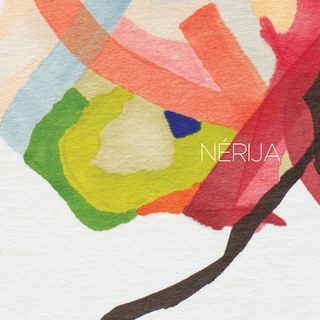
23. Nerija – Blume
Let me be the first to tell you that jazz is back! Centering largely in London, there is thrilling music being made by the likes of Sons of Kemet, The Comet is Coming, and this year, by Nerija. Breathing new life into a long moribund form (at least until Kendrick Lamar started featuring jazz musicians on his albums), Blume literally does just that, unfurling jazz from a long dormancy. While I’m not normally a fan of the guitar in jazz, here it keeps the whole thing moving forward, as the horns swirl around in a supportive role and the percussion cooks. “Riverfest” is the best exemplar, as the guitar chimes with joy while the cymbal-crashes enliven the vibe.
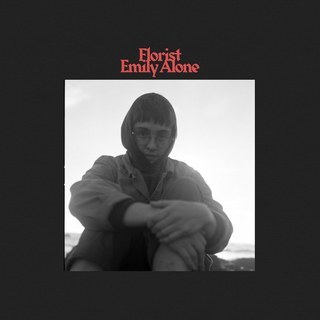
22. Florist – Emily Alone
A tale as old time (song as old as rhyme): member of ambient-electronic band puts out solo acoustic album, about the sadness of moving to LA and finding oneself. No one is reinventing the wheel here, but I can’t help but feel little touches of Florist’s electronic full-band output in Emily Sprague’s solo record—the way the words repeat, subtly, but building meaning with each little phrasal repetition. Plus, the ocean is a recurring image, and dear lord do I miss the sea. If you want to listen a sad girl sing sad songs accompanied by acoustic guitar, you aren’t going to do better than Emily Alone this year.

21. Kevin Morby – Oh My God
Possibly the best Kevin Morby record? No one else would say that, but I will. If so, why is it so far down the list? Well, when you consistently put out amazing records year-after-year it becomes difficult for any individual album to make an imprint on the “culture.” I think “Seven Devils” is possibly his finest tune.

20. Sacred Paws – Run Around the Sun
My friend David turned me on to this band right before I was about to embark on a road trip up north in the middle of the summer, and let me tell you, that was the perfect time to first experience Run Around the Sun. Noodly guitars burst out of every seam on this record, as bubblegum lyrics tie the whole shebang together. If you ever wondered what the Shangri-las would sound like if Johnny Marr played lead guitar, I give you Sacred Paws.

19. Jamila Woods – Legacy! Legacy!
On Legacy! Legacy! Woods takes the R&B of the excellent Heavn and applies a jazzier sheen, to excellent results. One need look no further than the track titles (“Frida,” “Miles,” “Basquiat,” “Baldwin,” “Sun Ra” etc.) to see that Woods is consciously engaging with the titans of history, and here, while she doesn’t exactly reach the heights of those innovators, she certainly begins to carve out a legacy of her own as one of the best voices in a currently thriving R&B scene.
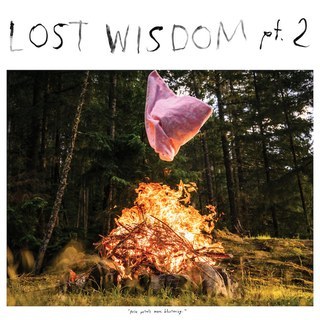
18. Mt. Eerie & Julie Doiron – Lost Wisdom, Pt. 2
On Lost Wisdom, Pt. 2 Phil Elverum (of The Microphones) and Julie Doiron (of Eric’s Trip) recapture the magic they bottled on the first Lost Wisdom back in 2008. It is hard to imagine sparer music than this, but the duo make so much of a pair of voices and few plucked guitar or banjo lines. As with all of his music of late (for obvious reasons), loss hangs all over Elverum’s output, but here, the loss is more mood and less of a literal presence (with the exception of the blistering “Widows”). Few songs I can think of capture a single, specifically odd phenomenon quite like “When I Walk Out of the Museum.”
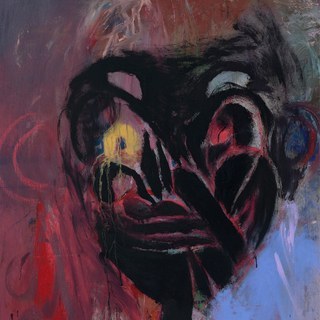
17. DIIV – Deceiver
As capital-G guitar music recedes further into irrelevance, it’s good to still have a band like DIIV kicking around, who make shoegaze like it’s still 1991. And it’s a good thing they are still making their beautiful walls of feedback, as heroine has repeatedly knocked this band off the rails of what appeared to be a very promising career. This is ominous, portentous music, that swirls with white noise and black despair. Shoegaze is premised on making beauty out of the squall of overdriven electric guitars, and DIIV make beauty of the squall of 21st century opiate addiction.

16. Earl Sweatshirt – Feet of Clay
Earl continues the excellent experimentation of Some Rap Songs in the (slightly) more structured Feet of Clay. Whereas Some Rap Songs felt like fragments, the tracks on Feet of Clay (almost) feel like “songs” proper. Earl continues to quickly sweep the ground out from underneath you, whether it’s in the form of oddly woozy backing tracks that can’t really be called “beats” or the sub 2-minute run times, but he seems to pack slightly more structure into those abbreviated entrants, even if there are a lot less of them than there were on Some Rap Songs. Right now no one is pushing the boundaries of hip-hop like Earl, and each new release, even if the total run time is under 15 minutes, is a thrilling event.
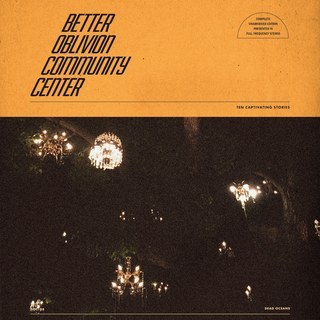
15. Better Oblivion Community Center – S/T
Yes, last year I had Boygenius as my number one record, but if I’m being frank, and I am, this is the better collaborative album put out by Phoebe Bridgers. At first blush a record between the up-and-coming Bridgers and the largely has-been Conor Oberst seems like a desperate grab at continued relevance by the latter, but having seen them live, I must admit the pairing makes perfect sense. The energy between the two is infectious, and while they share a common fascination with emo, they really draw the best out of each other. Bridgers plays the Emmylou Harris role from I’m Wide Awake It’s Morning to perfection, and Oberst plays the Kenny Rodgers in “Islands in the Stream.” For a period I could not turn on Radio K without hearing a song from this album, which is strange because, as a college radio station, every hour is usually completely different.
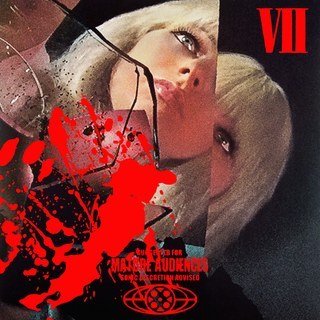
14. Chromatics – Closer to Grey
In a certain way, Chromatics are victims of their own tendency towards self-mythologizing. Their last two official albums were absolutely perfect slices of Italo-Disco, equal parts late night ennui and seething dancefloor longing. There was way more guitar on those albums than most anyone would appreciate on first glance, and yet Ruth Radelet’s smoky vocals were unquestionably the star. In the interim Johnny Jewel (the mastermind behind the band and basically everything on Italians Do it Better) famously destroyed all the copies of the long teased Dear Tommy after a near death experience, provided essential music to Twin Peaks: The Return (which included multiple Chromatics performances at the dear Road House), and then suddenly dropped Closer to Grey out of the sky, with neither warning nor fanfare. This record is everything you would want a Chromatics record to be, but perhaps that is part of the reason it didn’t really make a major impression. It felt a little Chromatics-by-the-numbers, right down to the cover of “The Sound of Silence” to open it up. I absolutely love this album, and if it weren’t for the incredible quality of albums put out this year, it would certainly be a top-10 or top-5 in any other year (hell, in the terrible-for-music 2018 it would have been number one by a mile). Perhaps the biggest frustration is just how fucking good “Light as a Feather” is. It hints at a version of Chromatics influenced by Portishead, and now that’s all I want more of.

13. Thom Yorke – ANIMA
Doubt it if you will, you sneering youngsters, but Thom Yorke and his more well-known band are currently making some of the best music of their careers. Just as A Moon Shaped Pool was a much needed return to form after the completely forgettable King of Limbs, with ANIMA Yorke gets back to what made The Eraser so compelling all the way back in 2006. While a fondness for Aphex Twin is no longer at all exceptional in rock music in 2019, it was in 2006, and with ANIMA, Yorke gets back to the creepy, clicky, paranoid distrust of modern consumer culture that is solidly his wheelhouse. Bonus points for using Netflix and a pairing with PTA to make America care about a long form music video again in 2019.

12. Black Marble – Bigger than Life
I would call black Marble my favorite new band of the year, but the thing is, they aren’t new, just new to me. Bigger than Life is their third record, and first for Sacred Bones (whose distinctive album art is what first caught my eye). Because their music is comprised solely of arpeggiated synths, melodic bass, and clinking drum machines, overlaid with melancholicly narrow vocals, it is easy to accuse Black Marble of being a little same-y. However, if you, like me, worship at the temple of New Order, than this is the band for you. I have lived with their three extant albums the last couple months (the second, It’s Immaterial, being my favorite), and in reality, this is really the only music I want to listen to.
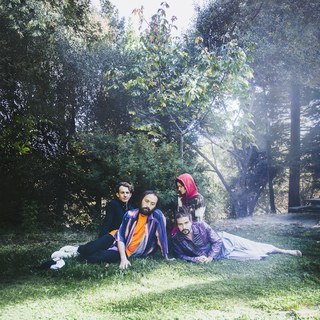
11. Big Thief – U.F.O.F. / Two Hands
If you’re reading this than you likely already know how much I love Big Thief, and you might be a little surprised that one, if not both, of the records they put out this year is not sitting atop this list based on how much I’ve professed my love for this band over the course of 2019. So here’s the thing, the highs on both of these albums--“U.F.O.F.” “Not”--are better than anything else anyone has done this year, but to my ear both records suffer from a flew blah-ish passages that prevent either album, on its own, from achieving top status. However, if you borrow a few tracks here (Cattails, Contact) and a few tracks there (Shoulders, Two Hands) and made one album out of the highlights of both sessions, you would unquestionably have the album of the year. That Big Thief gave us two records brimming with amazing folk rock ideas is a blessing.

10. Sharon Van Etten – Remind Me Tomorrow
Hey, do you remember Sharon Van Etten put out an amazing record in 2019? I bet you don’t. The culture moves so fast these days that albums from January might as well have been released five years ago, and it seems to me like this record slipped off a few peoples’ radars as the year progressed, which is a shame, considering how damn good it is (her best imho). There are few runs on an album I’ve enjoyed more this year than “Jupiter 4’s” electro-throb into “Seventeen’s” Springsteen chug into “Malibu’s” comedown. Bonus points for being my dear friend Hadley’s downstairs neighbor for all those years. Ah Brooklyn, how I miss thee.
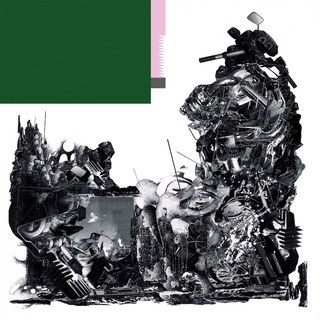
9. Black Midi – Schlagenheim
Yes, that most reliable of music-critic tropes: the hot young band from London. Black Midi made waves with a legendary youtube video of their live show, and having seen it in person, let me tell you, even that now infamous video doesn’t do them justice. Much like its gobldy-gook made up title, Schlagenheim is an amalgamation of strands of music that don’t really fit together but somehow they pull off with aplomb. At times they play with the hardcore fury of Minor Threat, while at others the proggy interconnectivity of Rush at their most arena-rockish, all with a weird dash of David Byrne wiry energy holding it all together. If they come to your town, go see them, just don’t stand in the front unless you want to be swept into the maelstrom.

8. Helado Negro – This is How You Smile
Did you love Little Joy (the Strokes sideproject) but wish it was occasionally electronic and periodically in Spanish? If so, I give you Helado Negro. This is the prettiest record of the year; it never goes above a certain emotional register / decibel range, but it inhabits the spectrum in which it lives like a ghost in its occasional electronic flourishes. This is a record for someone with a long drive with something to think about. “Seen my Aura” is simultaneously funky and restrained, acoustic and electronic, and emblematic of the joys of This is How You Smile.

7. Sturgill Simpson – Sound & Fury
Each of Sturgill Simpson’s last three records have been fundamentally different from one another, and each has been excellent, which is almost impossible to accomplish. Metamodern Sounds in Country Music introduced many, like myself, to a new voice in an often overlooked medium, A Sailor’s Guide to Earth dusted off the horns from Elvis’s stax-era and romped around, and now with Sound & Fury Sturgill looks to the outlaw tradition (and ZZ freakin Top) he’s so-often been associated with, but rarely resembled, to crank out an incredible record that is far more “rock” than it is “country.” Throw on a heaping of 80’s-era Springsteen synths and you have the recipe for a record that makes me very, very happy. The two halves of “Make Art not Friends” have little business coexisting within a single track (the first half sounds like Tangerine Dream, the second half Arcade Fire) and yet it is precisely in this tenuous cohabitation that Sturgill has produced his best record to date.

6. Vampire Weekend – Father of the Bride
Vampire Weekend started out their career being accused of stealing from Graceland and ended up becoming Paul Simon. Funny how that works out sometimes. Modern Vampires of the City has become, next to Sound of Silver, the definitive record about life in New York during my era (2005-2016). On the follow up, the band, newly shorn of Rostam Batmanglij (whose solo record is also phenomenal, even though he’s maybe one of the worst performers I’ve ever seen), decamped to California, and Father of the Bride revels in both the California sun and a well earned sense of accomplishment. “Hold You Now” is my favorite song of the year, it is simply stunning.
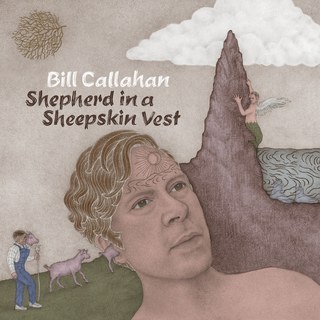
5. Bill Callahan – Shepherd in a Sheepskin Vest
There is a bit of theme developing here at the top of the list: established artists putting out arguably their best work deep into storied careers, and no one on this list is deeper into a more storied oeuvre than Bill Callahan. Between Smog and under his own name, Callahan has been releasing consistently great albums since 1992, and to me, Shepherd in a Sheepskin Vest is his finest work to date. Having found domestic bliss, so the press materials state, Callahan is content to sit back and let that world-weary baritone spin out all the comforts of a well-worn chair near a fire in a hearth. This is the type of record that gives you hope that happiness isn’t the exclusive provenance of the young.

4. Purple Mountains – Purple Mountains
If I were to really sit and write out all of my thoughts about David Berman this blurb would probably be 10 pages long, at least, so rather than spill a bunch of digital ink lamenting the loss of a true inspiration, I’ll just try and stick to the album itself, which is almost impossible now in the wake of his suicide shortly after its release. Even on first blush this was a difficult hang, clearly the product of someone who lost their wife to a series of poor decisions / mental difficulties, and who hadn’t come to terms with it. Understandably so. Berman remains endlessly quotable, right up to the very end, and “we’re just drinking margaritas at the mall” remains emblematic of his ability to compress the tedium of middle american misery into a single haunting, yet, hilarious, image. While “Nights that Won’t Happen” lives on as his suicide note directly to the fans (“The dead know what they’re doing when they leave this world behind” ; “all the suffering gets done by the ones we leave behind”), and it is hauntingly beautiful, it still makes me cry every time I hear it. As does most of this record. So the song I’ll carry on with me, and can still actually listen to, is “Snow is Falling in Manhattan.” Just a beautiful song from a beautiful man.
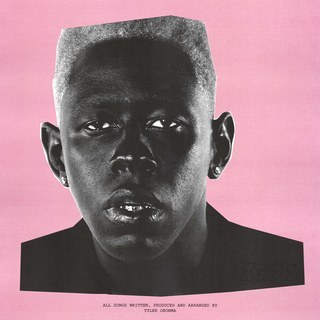
3. Tyler, the Creator – IGOR
I really don’t have the words (well, clearly I have some) to express just how impressed I am by the arc of Tyler’s career. The one-time shock-rap flash in the critical pan quickly turned into forgettable homophobe who perfectly fit a description of Eminem’s fan base I once heard: kids who call their mom a bitch to their face. The first startling change came with Flower Boy, which came right on the heels of his step out of the closet. Flower Boy is a really great record, but it still largely sounded like Tyler, just a more mature version who stopped saying cringe worthy shit. IGOR is something entirely different. I honestly don’t even know what to call it. It’s not a rap record, and there are honestly entire tracks on it where I’m not sure what it is he does on them, but my god, this thing is incredible. It’s basically a Parliament album for the end of the world, and if the earth is going to burn down around us, we might as well dance our way out, which is precisely the party Tyler has orchestrated here. I cannot wait to see what he does next.

2. Angel Olsen – All Mirrors
All Mirrors isn’t just clearly Angel Olsen’s best album by a clear margin, it is the best pop album made by anyone in sometime. Just like black clothes make anyone a little slimmer, orchestration can make any pop song sound symphonic, but most pop acts don’t have the power of Angel Olson’s voice to match the bombast of the string section and percussion. It feels like the term Beatlesesque has started to fade from the critical lexicon, but this music is truly akin to the orchestral richness of “I am the Walrus” or “A Day in the Life.” People celebrate Lana del Ray for her torch songs (and I really liked Norman Fucking Rockwell, even if it didn’t quite make this list in a stacked year) but no one carries a torch like Angel Olsen. I was initially reticent to catch her live show this tour, it was on a weeknight, it was cold, I had to go downtown, I’d seen her a couple times already, yadda yadda yadda, but I knew deep down I really wanted to see if she could recreate the power of these songs on stage (the inverse of how that equation usually goes). Reader: she did.
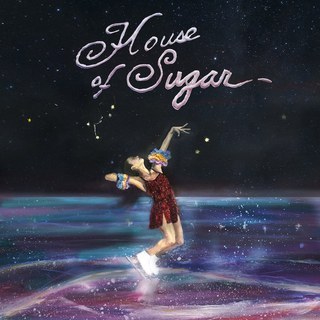
1. (Sandy) Alex G – House of Sugar
House of Sugar may not be quite as experimental as IGOR, or as pop-perfect as All Mirrors, but it takes those two impulses and melds them together into what is my favorite album of the year, even if strictly speaking it may not be the “best” as measured against the other entrants in this top 3. “Hope” was actually a “hit” song on the local college radio station, and understandably so; it sounds like Elliott Smith and tells a comprehensible story about a friend who died from an overdose. But “Hope” is jut one facet of House of Sugar, which is a veritable hall of musical mirrors. “Walk Away” is hypnotic in its repetitions, “In My Arms” is a legit straightforward acoustic love song, “Sugar” sounds like The Knife (no joke), “Sugarhouse” could have been on The River, and while I already said “Hold You Now” is my favorite song of the year, “Gretel” has something to say about that. I saw a show right when this album came out, and as the band left the stage for the final time the soundguy cued up “Gretel” not, I’m guessing, because the band requested it, but because it rules and he just wanted to share it with everyone as they receded into night.
0 notes
Photo


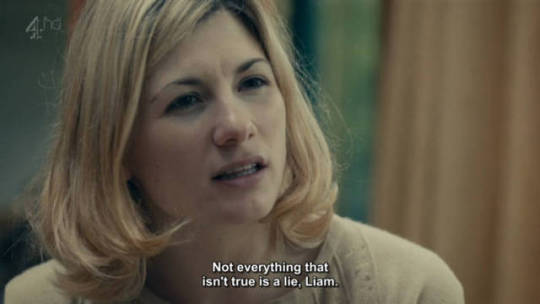





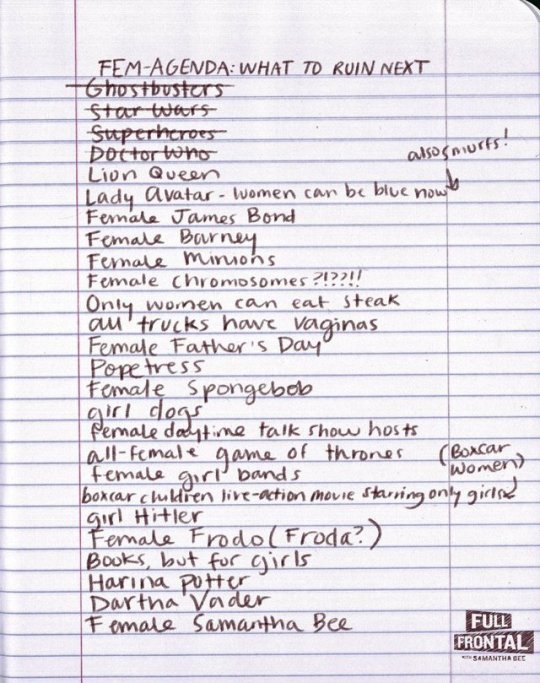

Contains SPOILERS for Doctor Who and Season 2 of Broadchurch.
Imy Comic by Irma Ericksson.
http://www.imycomic.com/the-cartoonist/
Images/Gifs from Doctor Who (2005-), Black Mirror (2011-), Attack the Block (2011), and Broadchurch (2013-2017). The humorous Fem-Agenda List from comedian and late night show Full Frontal host Samantha Bee. Tweets from Johnathan Pyror and Mackenzie Lee.
I’ve being going through some life-changing stuff. I moved and got a place with roomies. Not done transporting possessions yet. Working somewhere else. Dealt with car issues. A lot has occurred. :)
Hence why this has taken considerably longer to type, edit, and post than I originally envisioned over a month ago. XD
On Sunday July 16th 2017, the long-running BBC sci-fi series Doctor Who starring a time and universe traveling body shifting Gallifreyan Time Lord made the announcement that a woman would play the longtime exclusive to men portrayal character next. Alongside companions, the Doctor is the true definition (not the derogatory kind) of a Social Justice Warrior. The Doctor assists civilizations, helps people, tries to alter certain events in time, and clashes against all types of enemies. The most famous among them being the Daleks, of course.
There’s been twelve Doctors (Well, thirteen if John Hurt’s War Doctor is counted...Doesn’t seem to be though. Since Jodie isn’t labeled as the 14th Doctor. ) played by men since the series inception back in 1963. The original run lasted until 1989, the revival of the show began in 2005. Doctor Who was created by C.E. Webber, Donald Wilson, and Sydney Newman. Producer Verity Lambert, story editor David Whitaker, and writer Anthony Coburn also contributed to the development of the series that would eventually become Doctor Who. In 1986, Newman wrote to BBC Chairman Michael Grade, "At a later stage, Doctor Who should be metamorphosed into a woman. This requires some considerable thought — mainly because I want to avoid a flashy, Hollywood Wonder Woman because this kind of heroine with no flaws is a bore. Given more time than I have now, I can create such a character."
So, over three decades (839 episodes, one TV movie, four charity specials, multiple specials, and two animated serials) later, Newman’s words are realized under Broadchurch creator and new Doctor Who showrunner Chris Chibnall (with the departure of Steven Moffat). At the end of 2017, the current Doctor incarnation actor Peter Capaldi portrays will be replaced by Jodie Whittaker following the Regeneration process. This decision is is merely another form of change: a significant theme pertaining to the Doctor’s character as a whole.
On top of that, in the 1999 Red Nose Day telethon episode Doctor Who: The Curse of the Fatal Death was the first time the doctor was a woman (Joanna Lumley). In the audio drama Doctor Who Unbound Exile which is free from the restraints of continuity released in 2003 actor Arabella Weir played the Doctor. During the 9th Doctor’s run, it was revealed that the Doctor was bisexual even though the character rejected Jackie Tyler’s advances in “The Parting of Ways”. The Doctor flirted with Jack Harkness, proposing to dance with in the episode “Doctor Dances” whilst promising to give him what Rose Tyler had with Mickey Smith should Jack purchase him a drink. Captain Jack Harkness and River Song are characters both from the 51st century where pansexuality is the norm. Companion Clara Oswin Oswald has been in a relationship with a man but mentions kissing women too. When the 11th Doctor touches his hair following the completion of the 10th’s Regeneration process, the character says, “I’m a girl. No, no. I’m not a girl. And still not ginger.” This suggests that a the Doctor could be a woman. In the 2011 episode “The Doctor’s Wife” Neil Gaiman wrote from over six years ago, the Time Lord Corsair is mentioned and it is divulged that Corsair had a Regeneration that switched him into a her. In the 2013 mini-episode “The Night of the Doctor”, the Sisterhood of Karn (first appearance was in The Brain of Morbius that aired in 1976) asks the Doctor what Regeneration is desired (“Fat or thin, young or old, man or woman?” “Fast or strong, wise or angry, what do you need now?”): ultimately Paul McGann’s 8th Doctor wishes to be a “warrior” and is transformed into the War Doctor (portrayed by the late and incredibly great John Hurt). Since the show’s 2005 revival, an infamous Time Lord villain known as The Master went from being solely men into a woman named Missy (Michelle Gomez) after an off-screen Regeneration took place.
Change is important for the purposes of bringing a fresh angle to an established accepted formula whilst having potential narrative merit, symbolizing growth, modern day relevance, and validation to something existing. How change is navigated, utilized, or coped with is equally as important. Each Regeneration leads to viewers, writers, showrunners, and cast members having to accept that a previous version of the Time Lord is gone. “No more.” Their look, personality, memories, relationships, mannerisms, and whatever else gets scrambled into something entirely different post-Regeneration.
Likewise, the companions of the Doctor go through switcheroos often as well. Some leave us furious. Sad. Perhaps even glad.
My point is that we’re resist to change. Struggle with it. Less of a fan as a result. Which is understandable. However, when a certain demographic has been catered to for decades, altering this comes with a price. To be candid, I find the reactionary backlash a tad odd and chuckle-inducing. As if the time-traveling alien Doctor was ever defined by masculinity before. If that’s your chief defining attribute of the Doctor then I legitimately feel sorry for you. The Doctor represents more than a man or a woman and that’s why this beloved character has obtained a prestigious status among fictional creations.
This is the inherent beauty of science fiction. Close to infinite possibilities at one’s creative fingertips are there. That’s why Daisy Ridley’s Rey being a protagonist and an in training Jedi (General Leia Organa never got this despite her mighty connection to the Force) within the new Star Wars flicks is a big deal. Nichelle Nichols’ Lieutenant Uhura from Gene Roddenberry’s Star Trek was historical by being the first African-American not to play a servant on American television. Did you know that Civil rights leader Martin Luther King Jr. asked her to remain on Star Trek when she thought about leaving in the late 60s? “For the first time on television, we [people of African descent] will be seen as we should be seen every day, as intelligent, quality, beautiful people who can sing and dance, yes, but who can go into space, who can be lawyers and teachers, who can be professors — who are in this day, yet you don’t see it on television until now." Nichols would further influence Dr. Mae Jemison, the first black woman to fly aboard the Space Shuttle, directly cited Star Trek in her decision making. Additionally, Nichols’ Uhura would serves as a role model to Star Trek: The Next Generation Guinan actor Whoopi Goldberg ("I just saw a black woman on television; and she ain't no maid!") too. Should I list all of the ways in which Charlize Theron’s Furiosa of Mad Max: Fury Road and Gal Gadot’s Wonder Woman have contributed to the more inclusive than most genre?
The casting choice of actor Peter Capaldi as the 12th Doctor bothered me from the get-go. Since Peter Capaldi had already been on the series via the 10th Doctor (David Tennant) episode “The Fires of Pompeii” as Caecilius. Not too long after that Peter would be in the Doctor Who spin-off series Torchwood: Children of Earth as John Frobisher too. Capaldi took over the role of the Doctor from Smith in 2013. Why the Doctor’s facial appearance is similar to Caecilus was eventually addressed in the 2015 episode “The Girl Who Died”. For whatever reason I’ve been unable to decipher, I’ve just never clicked with Capaldi’s Doctor. On the other hand, I am still grieving a tremendous loss...Which is actor Pearl Mackie’s SDCC announcement she’s leaving the companion position this December. Meaning I do have some level of viewership enjoyment with Capaldi due to Bill’s accompaniment with him.
I’m sincerely going to miss her.
In short, what has been hinted at in the past will become reality this December. No one’s being blindsided, I’d argue. Not about being PC either. These seeds were clearly being planted prior to.
Yes, this a holiday present I’m fondly looking forward to. Especially after seeing Jodie Whittaker’s nuanced performance as Beth Latimer in Chris Chibnall’s Broadchurch. Or Jodie’s role in the Black Mirror (a dark genius sci-fi series courtesy of Charlie Brooker) episode “The Entire History of You.” Psst, the entirety of Black Mirror is on Netflix...There’s even an episode that warned about a candidate like Donald Trump rising to power. I’d be remiss not to type about Whittaker being in the cult science fiction hit film Attack the Block (2011) as well. All of that she’s done deserves to be seen. That’s what I’ve been re-doing in anticipation actually!
With both Peter Capaldi’s and Steven Moffat’s tenures with Doctor Who coming to a personally welcomed close, my ranking of excitement is considerably lofty I must admit. We’ve needed an overhaul for awhile now. The long awaited for revolution of making the protagonist Time Lord a woman next brings a fresh dynamic to Doctor Who. I reckon she won’t be able to coast or take some things for granted like previous incarnations did. The involvement of Chris Chibnall and the inclusion of Jodie Whittaker has me ridiculously psyched for Doctor Who’s future. I believe both of them will positively contribute to the series with their injection of needed new. I even feel compelled to finally watch Doctor Who again in a strangely devoted fashion (something I haven’t done in years) versus sporadic glances at the telly throughout Capaldi’s run.
#doctor who#13th doctor#jodie whittaker#chris chibnall#broadchurch#charlie brooker#black mirror#attack the block 2011#beth latimer#peter capaldi#christopher eccleston#matt smith#bill potts#pearl mackie#steven moffat#joanna lumley#nichelle nichols#charlize theron#gal gadot#commander uhura#furiosa#wonder woman#whoopi goldberg#gene roddenberry#star trek#daisy ridley#rey star wars#guinan#star trek: the next generation#dr. mae jemison
6 notes
·
View notes
Quote
[. . .] "Hamilton" has been praised as a groundbreaking work of art. It certainly has its moments, but ultimately doesn't go far enough in embracing what hip-hop represents. In a musical that portrays hip-hop as the language of a new country, a new way of thinking — the future, in other words — "Hamilton" consigns its female leads to the past.
The show currently playing at the PrivateBank Theatre is a relatively brisk, densely detailed musical that toggles between historical bullet points and outspoken metaphor. Most of the white males who ran the country in the late 1700s are portrayed by people of color, a not-so-subtle reminder that America was always a multicultural land — a haven and a hell.
In this context, the hip-hop vernacular has wicked immediacy, putting a fresh spin on what could be a potentially creaky history lesson. This is less a textbook dramatization than an ode to immigrant pluck, impudence and ambition (and the sometimes fatal risks required of revolutionaries who won't keep their mouths shut). The relevance of that message in today's fractious world of "extreme vetting" and Islamophobia makes "Hamilton" an unusually potent piece of theater.
[. . .]
"Hamilton" works best when it is as irreverent and raw as hip-hop itself. Miranda keeps the score relatively sparse, and many of the songs feel blessedly bare-bones when compared with traditional Broadway's lush orchestrations. Some of the songs are reduced to little more than bass lines and electronic handclaps. There's even some turntable scratching and human beat-boxing.
It's a kind of anti-style that suits the "bastard orphan" Hamilton (as played in Chicago by Miguel Cervantes), who brings cockiness tempered by a fatalistic dread that he is running out of time. Mortality haunted the lyrics of the Notorious B.I.G., who, like Hamilton, was felled by a gunshot and whose work profoundly influenced the young Miranda.
The young Hamilton declares for all the world to hear that he's not "throwing away my shot," while quoting Mobb Deep rapper Prodigy: "I'm only 19, but my mind is old." Aaron Burr (the more constrained Wayne Brady) tries to undercut this crowing rooster of a revolutionary by advising Hamilton to "talk less, smile more."
Burr is like the major-label executive who showed Ice-T the door in the early '90s because his music was too abrasive, too real. But Hamilton is undeterred as he demands that corrupt petty-minded government officials pick up their game or get out of his way: "I'll be Socrates throwing verbal rocks at these mediocrities." Cervantes, by way of Miranda, is one of hell of an MC at moments like these.
When Burr finally speaks his mind, it suggests what the usually self-contained colonist might have been. He's always on the outside looking in, and on "The Room Where It Happens," he's finally had enough. The escalating gospel-like call-and-response vocals plant the seed for Burr's final act of misguided vengeance.
Even more entrancing are the verbal duels between Hamilton and Thomas Jefferson (played with dandyish glee by Chris De'Sean Lee). Over a banging kick drum and turntable scratching, Hamilton zings the slave-owning, big-talking Virginian upon his return from Paris: "A civics lesson from a slaver, hey, neighbor, your debts are paid cuz you don't pay for labor." Jefferson mocks him right back by paraphrasing Grandmaster Flash's rap classic "The Message." They go at it again a few minutes later in "Cabinet Battle #2" while onlookers hoot, holler and laugh like they're standing on a street corner in the Bronx circa 1979, not in government chambers circa 1789.
[. . .]
Given the wealth of alpha males on stage, it's too bad that the female leads are made to sound like afterthoughts, consigned to more traditional Broadway roles and bland blends of R&B and show-tune balladry. As Hamilton negotiates a tricky triangle of three lovers or would-be-lovers — his wife, his wife's sister and a mistress — the show and the music lose momentum: a schmaltzy duet between Hamilton and wife Eliza (played by Ari Afsar), the betrayed Eliza's "Burn," the broken couple's lament "It's Quiet Uptown."
It all gets a much-needed verbal reset from Jefferson: "Can we get back to politics?" In this case, it's a necessary antidote to the play's snooziest stretch in Act 2, a throwback to Broadway romantic melodramas of old. The leading women in Hamilton are long-suffering actors who melt into the background while the strutting male leads get all the best lines and songs.
Where's the "Hamilton" equivalent of rap-era heroes Missy Elliott or Nicki Minaj? Eliza could've easily been cast as a neo-soul earth mother along the lines of Erykah Badu rather than just another Broadway ballad singer with a pleasant voice.
Even though Eliza gets the play's last word and final song, she testifies about how she spent the last half-century of her life keeping her husband's legacy alive.
"Hamilton" is notable in that its diverse cast tacitly gives voice to outsiders who never got a chance to earn their shot in colonial days. Too bad it doesn't do the same for women, who are left very much in the margins of this male-dominated musical.
A music critic goes to 'Hamilton' (Chicago Tribune)
it’s a super legitimate criticism that the space for women in Hamilton is limited, but buddy, if you think that what the women do do is unimportant, then that’s on you
also, here’s your Nicki Minaj (as seen in the show via the song that doesn’t merit a mention in this review)
#hamilton#review#chicago tribune#another review pet peeve: saying that a thing failed when it was actually successful at what it aimed to be but just isn't what you like#i.e. the show is a deliberate fusion of hip-hop & traditional broadway#saying that the fusion doesn't always work is one thing#saying that it fails cuz one element of that fusion... exists is another#which is okay if you don't like it#but criticisizing a broadway musical for being like a broadway musical sounds a little dumb#it's okay not to like things#that doesn't make them bad
98 notes
·
View notes
Note
Do all thirty of those identity things have fun
do you have a creed?you bet your ass i’ll have fun
if someone wanted to really understand you, what would they read, watch, and listen to? - uhhhhh fuckiinnnnn.... off the top of my head, im sure im missing a lot of important stuff here: listen to hawaii part 2, dinosaurchestra through to spirit phone of the lemon demon discography, and a bunch of miscellanious game music / siIvagunner. and just like have a base understanding of what vaporwave is about. probably you could get a pretty good sense for what im like by going through several hundred pages of this blog honestly. also if youve ever [media appropriate verb]ed anything where theres a theme of alternate timelines and resets and all that. lots of stuff has that kind of stuff going on recently. rick and morty, pokemon, hs, ut, you name it. also also, the story of the hollows from dark souls and the themes it brings up speaks to me on some level, so theres that.
have you ever found a writer who thinks just like you? if so, who? - no i dont think so. i dont really do a lot of reading anymore, even though i used to be captain books when i was younger.
list your fandoms and one character from each that you identify with. - god this is a good question but the way its worded just doesnt jive with me. its so 2013 tumblr you know? that being said the more i think about this the less of an answer i have. sorry thats boring and not giving an answer defeats the whole point of the ask.
do you like your name? is there another name you think would fit you better? - i guess. i mean its alright, im not really sure what i would rename myself to if it was up to me to choose. i like that you guys all call me “mayor” here though. obviously that doesnt work outside of the internet but like you know.
do you think of yourself as a human being or a human doing? do you identify yourself by the things you do? - instead of adressing the stupid jumble of words masquerading as a deep question, im gonna take this opportunity to express my worry that my answers to these asks might just be a bunch of inane, barely legible rambling. if nothing else im sorry that my formatting is shit. in response to that second question though, yeah sure i guess. dont we all?
are you religious/spiritual? - pffffft no no no.
do you care about your ethnicity? - not particularly, although i realize that the fact that that’s my answer is a luxury in and of itself
what musical artists have you most felt connected to over your lifetime? - like i get that technically its not a wrong usage, but “lifetime” feels like its implying that im way older than i am and also that im dying. anyways. neil cicierega, recently at least. although im well aware that connecting to someones music is different than knowing them as a person, its a lot more interpretive than just actually getting to know someone.
are you an artist? - debatably.
do you have a creed? - nope.
describe your ideal day. - its foggy and raining outside, me and my lover are curled up in bed with food and computers. maybe we go out and take a walk, mostly we just spend the whole day together. mayb we’re having conversations that arent as deep as we think they are. maybe we’re playing games. doesnt really matter. we’re together.
dog person or cat person? - cats. arent you guys happy when my answer to something isnt three run-on sentences worth of esoteric thought?
inside or outdoors? - indoors. i just realized that you can say “side” or “doors” for both of those words and it means the same thing either way. thats kind of interesting isnt it?
are you a musician? - nope. i like the idea of being one, but i dont think i have whatever it is it takes to be one. a bunch of my coworkers assumed i was though, so thats something. must have been my hair.
five most influential books over your lifetime. - uhhhhh
if you’d grown up in a different environment, do you think you’d have turned out the same? - theres probably a preppier version of me out there in an alt timeline? idk. i wish someone got me to learn how to code earlier, thats relevant to my interests and actually useful going into the 21st century. as it stands im just starting out now, shit at it, and beating myself up over the fact that im not that good at it despite the fact that sitting on my computer all day is just what i do. its a small event if i bother going anywhere.
would you say your tumblr is a fair representation of the “real you”? - ehh? idk. nobody is exactly the same in all contexts, the situation you’re in influences how you’ll act, that doesnt mean one of them is more of the “real you” than any of the others, theyre all facets of one person. god that was pretentious and psuedo-intellectual. the point im getting at is “yeah sure.”
what’s your patronus? - i took a test online and it gave me a hare. so there you go. i wouldve assumed some kind of bird but w/e.
which Harry Potter house would you be in? or are you a muggle? - i took a test for this too and it said slytherin. now im having a small crisis over whether or not im an edgy boy.
would you rather be in Middle Earth, Narnia, Hogwarts, or somewhere else? - the pokemon world is pretty idyllic all things considered, lets go with that.
do you love easily? - nope. i crush easily though. though for what its worth, i can always tell its not real love, so i never wind up acting on it. mostly im just constantly lowkey sad that i cant find anyone to have a long term relationship with. how the fuck do you become close to someone.
list the top five things you spend the most time doing, in order. - christ dude idk i dont have stats for this shit
how often would you want to see your family every year? - .3 times a year sounds good to me. i’d settle for .5
have you ever felt like you had a “mind-meld” with someone? - no. what does that even mean.
could you live as a hermit? - “could” i? i think you mean “do”. and yes.
how would you describe your gender/sexuality? - captain privellege. the downside though is i dont know even one straight woman, so ive got nobody to fall in love with. real inconvinience this is. not much anybody could do about it.
do you feel like your outside appearance is a fair representation of the “real you”? - i’ll spare you guys another ramble a la question 17. my point would be “yeah sure i guess”
on a scale from 1 to 10, how hard is it for someone to get under your skin? - depends on the person, if im not already predisposed to liking you its probably like a 4. none of you people reading this will probably have to worry about it though, id assume if youre the kind of person who would send an ask or message me youre also probably the kind of person i like, so dont feel scared of bothering me. i’ll be pretty clear if you are. [which you won’t be]
three songs that you connect with right now. - i alays have so much less to say about music than i think i will. borns - electric love, mystery skulls - get it together, hotline miami ost - daisuke
pick one of your favorite quotes.- guys i want you all to know how much i hate that quotes are one of those things that immediately drain out of your mind as soon as youre asked to recall one. theyre like jokes. im gonna default to my usual boring answer of morty’s “nobody exists on purpose, nobody belongs anywhere, everybody’s gonna die” speech to summer. i wish i could come up with something better for that though, im not feeling that nihilistic right now.
lemme use a couple more fuckin commas here, just sprinkle some in there,
,,,,, ,, ,,, ,,,,, , , , , , , ,,,, ,, , , , , , , ,, , ,,,,,,, ,, ,,, ,,,,,,, ,,, , , ,, ,
1 note
·
View note
Text
The Whitlams review: God drinks at the Metro
The portrait of a sex pest that is Pretty As You, for instance, was cast by Freedman as "a #metoo anthem way ahead of its time", and his intense, sneering delivery justified the claim.
He maintained that tone for 400 Miles From Darwin,which at the time asked how Australians in 20 years would feel about their apathy toward the East Timorese and their bloody struggle for independence. The fact that most recently we've played hardball with them for gas fields was written all over Freedman's face.
Depressingly, Blow Up The Pokies - about the downfall of founding bassist Andy Lewis - and takedown of Sydney vapidity You Gotta Love This City were as relevant as ever too. At least their enduring melodies and soaring treatment from this four-piece made them less bitter pills to swallow.
Given the untimely deaths of two of the three original Whitlams, and the revolving door of musicians that played on their biggest records of the late '90s, the band today is considered as "Tim and the other guys" by most.
This night proved that is unfair, and not just because this line-up with Jak Housden on guitar, Warwick Hornby on bass and Terepai Richmond on drums has been constant since 2001.
Their jazz-level chops were enough to make one forget the missing strings and horn sections, grooving brightly on Thank You (For Loving Me At My Worst) and I Make Hamburgers, rocking hard on Royal In The Afternoon and rousing closer I Will Not Go Quietly, pushing-and-pulling on the mosh-worthy You Sound Like Louis Burdett and Year Of The Rat (boasting a showstopping solo from Richmond ), and striking minor-key solemnity on God Drinks At The Sando -Freedman noting wryly that he hadn't been "allowed into a bar on King Street after 10pm" for some time.
The band also added gorgeous harmonies throughout, none prettier than on touring lament, There's No-One.
They were too loud on No Aphrodisiac, drowning out whatever 21st-century lyrical additions Freedman was declaiming in its coda.
However the words from twenty-odd years ago were fine by this crowd, which sung though Buy Now Pay Later (Charlie No.2) in its entirety, Freedman alone at the keyboard calling over the top for another fallen friend.
Earlier, solo sets from the frontpeople of two other big '90s bands - Bob Evans (aka Kevin Mitchell from Jebediah) and Ella Hooper (Killing Heidi) - transcended nostalgia with highlight songs from this decade.
In Evans' case it was Wonderful You, a love song that obvious hero Bob Dylan would be proud to claim, and for Hooper The Red Shoes, which showed a gift for building drama and a big voice with falsetto intact.
Michael Bailey writes on entrepreneurship and the arts. He is also responsible for the Financial Review's Rich Lists. He is based in Sydney."
Most Viewed in Entertainment
Loading
https://www.smh.com.au/entertainment/music/the-whitlams-review-god-drinks-at-the-metro-20190615-p51y2i.html?ref=rss&utm_medium=rss&utm_source=rss_feed
0 notes
Text
Character Creation Tag
I was tagged by the fantastic @aeschknight -- I’d been reading yours going “ooh I want to do this too” :D
I’m going to do this for Cal, the main character of my current WIP aka “TT” (which I just tallied and the first draft of, and it has over 106 thousand words in it at this point, which is horrifying as well as immensely gratifying, but this is a light hearted YA fantasy dammit)
1. What was the first element of your character that you remember considering?
I wanted her to be boring. This was, oh, at least a decade ago-- I was in that phase where I was rejecting “““the dreaded mary-sue”““, and also thinking about how using a wish-fulfillment character made your MC inherently inaccessible in some ways. I laugh looking back, because, honestly... she’s ridiculous now and she refuses to apologize.
2. Did you design them with any other characters from their universe in mind?
I... don’t think so? It’s been so long, I don’t remember which members of the “cast” came first. I think it’s possible her mentor pre-dated her.
3. How did you choose their name?
The real reason is a deep dark secret that I am embarrassed about. “Cal”, as odd a nickname as it is, was the ‘germ’ of the character; I picked “Hannah” to defy fantasy tropes and do something mundane. Her middle name “Shea” was just to justify a personal linguistic in-joke, and “Calumn”-- her last name-- was to justify the nickname “Cal”.
4. In developing their backstory, what elements of their world played the most influential part?
This one’s a little bit chicken-or-the-egg-y. In developing her identity, the core element of her story, the fantasy element of her world played a huge part-- she runs away from home to join the magical Men In Black, after all, because magical aliens are real. As the worldbuilding grew more complex, though, the ways her discoveries bring up truths about her personal past brought in some character backstory I never deliberately set out to incorporate (and which I still maintain are not entirely my fault and really ought to be made less incredible in post.)
5/6/7. Is there any significance behind their hair color/eye color/height?
Her height is average, which I suppose is significant in that I really did set out to make her a normal person. She has brown eyes (if I remember right, eye color isn’t something I really focus on-- I never notice it for the people around me, so it’s hard to remember it might be relevant for those I create), but her hair... well, technically her hair’s brown too. But not when it’s dyed, however badly, bright red. (she has regrets)
8. What do you relate to within their character/story?
Feeling uncertain about what you’re supposed to be in life, feeling like you’re not really good/interesting enough for the people you consider friends, and saying way way more than you mean to.
9. Are they based off of you in any way?
Only in the ‘aggressively boring’ way.
10. Did you know what your character’s sexuality would be at the time of their creation?
I don’t think so. It wasn’t part of the germinus of the character, but as the story grew around her, and I started to recognize the potential romantic sub-plots, I knew her being straight wasn’t really an option.
11. What have you found to be the most difficult art form in creating your character?
I’m not sure what you mean by art form, so I’ll give you a twofer. The hardest writerly art is balancing impulsive “it would be funny in this scene if X were true/happened” with long-term consistency and realistic background. The hardest art in general is music. I enjoy listening to music but rarely have a strong emotional connection to it, so if you asked me to pick a song that represents Cal-- I’d be stuck. (This does indeed imply that I’m more capable of drawing her than of describing her via music. That does not mean I’m good at drawing her.)
12. How far past canon events that take place in their world have you extended their story?
..............there’s a sequel, and a parallel universe sequel, and a time traveler from about six centuries in the past, as well as a sealed goddess from the dawn of time, so like... a ways, guys.
13. If you had to narrow it down to two things that you must keep in mind while working this OC, what would they be?
She’s been around so long (or I’m so unstudied a writer) that I really just write her on instinct. But I suppose-- make sure other people call her out for being stuck in her head so much (and occasionally an asshole), and make sure she doesn’t ruin all my dramatic tension.
14. What is something about your OC that makes you laugh?
Honestly the dedicated, conscious, and consistent avoidance of anything that smells like emotional confrontation.
15. What is something about your OC that makes you cry?
I think how hard she tries to do the right thing, and how acutely she feels that she doesn’t live up to what she needs to be for certain people.
16. Is there some elements you regret adding to your OC or their story?
YES. She has this utterly ridiculous backstory that makes it impossible to think of her as ‘a normal girl’ anymore, AND a really overprotective parent figure that means I have to logically consider WHAT HAPPENS to a story about coming-of-age and self-determination when you have Actual Responsible Adults trying to stop her from getting her fool ass killed.
17. What is the most recent thing that you’ve discovered about your OC?
Her grandma scares me.
18. Favorite OC fact?
Oof, I can’t think of one that I’d call my “favorite” because having to pick a favorite anything makes me unhappy. So, three: her childhood “favorite stuffed animal” was a giant stuffed lizard. Not a dragon, a lizard. She is incapable of NOT trying to be a big sister to any younger girls she comes across. She still maintains that stalking her werewolf classmate in junior high was scientific curiosity and not an extremely poorly-implemented crush.
Tagging: I don’t actually know a lot of writerly folks on Tumblr. So I request that if you feel like doing this tag, tag me back so that I can read about your character and meet you, too :)
0 notes
Text
Arts and Culture Reporting Final Exam
By: Eliza Peppel
Question #1:
Carl Andre’s Lack of Artistic Individuality
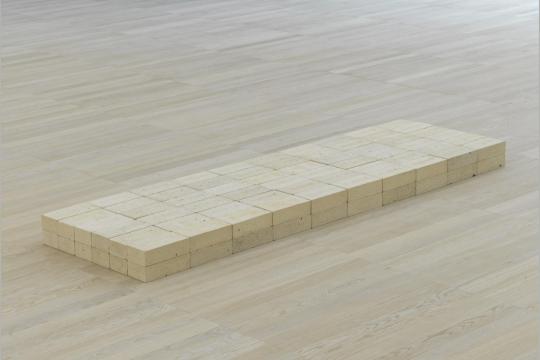
American sculptor Carl Andre (b. 1935) is well known for his minimalist, geometric pieces. To me, these peieces are not only visually unimpressive, but lack any sort of meaning, depth, or originality. They tend to do close to nothing for the eye, and while Andre claims he tries “desperately in a world of replicas to produce things that are not replicas of anything” (quote from 1972), his pieces are reminiscent of sidewalks, flooring, or simple cubic shapes. Even he seems to, at times, be aware of when he falls short, saying, during the construction of his piece The Last Ladder, “I realized the wood was better before I cut it, than after. I did not improve it in any way” (1959).
Carl Andre is also known for being married to, and accused of the murder of, fellow artist Ana Mendieta. Mendieta was a Cuban multimedia artist whose work explored violence, sex, and death, often shocking viewers. The two were married for less than a year when Mendieta fell from their shared apartment window during an argument and was killed. Supposedly the two argued often about their success as artists and their work.
To me, Andre’s career is an excellent example of the ease with which male artists too often achieve success and vast recognition. He is an embodiment of privilege. For centuries, female artists have lived in the background of the art world, having to work twice as hard or pick up on amazing luck to be recognized as deserving of the same respect as their male counterparts. In my eyes, Andre is famous because he is a wealthy man who makes art, not because his art is impactful, or because he is intelligent. Whether or not Andre murdered Mendieta, the two married artists still tell an engaging story. Mendieta’s work drips with boundary-pushing meaning, exposing her grief, exploring death and sexuality, which took a toll on her reputation and success. Andre doesn’t seem to take any sort of risks in his work. He seems instead to live on a pedestal, basking in the grand recognition and his alleged superiority to others.
Question #2:
The Catharsis and Romance of David Bowie:
How one man raised a world full of teenagers.
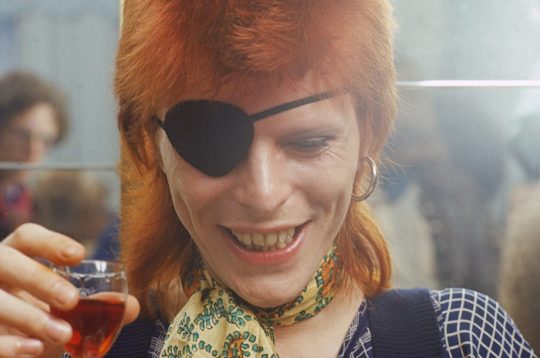
When I was 14 my dad took me to the David Bowie exhibit at the Victoria and Albert Museum in London on a rainy day. I knew close to nothing of Bowie, besides the memory of the Hunky Dory album cover, and the grainy image of him pulling his blonde hair back (I thought it was a woman). The exhibit focused on his costumes and clothing, including jewelry, platform shoes, wigs. I was utterly absorbed. At 14, I had a stubborn habit of hiding away, not believing most parts of myself to be potentially valuable, and not thinking of living as anything someone like me could make anything out of besides the ordinary. David Bowie made me see life as a performance, a party. While suppressing myself had become second nature, David Bowie danced his feelings, adored being the center of attention. Openly bisexual and visibly androgynous, Bowie gave sexuality a new meaning. He embraced the blur, erased the lines: Got your mother in a whirl, she’s not sure if you’re a boy or a girl.
I didn’t hate my parents, but I often resented the typical expectations they stood for. I was determined not to live like I was expected to. Throughout my teens, Bowie’s music seemed to be a soundtrack to a personal revolution, one where I enjoyed myself, saw my own value. A perspective emerged in which things didn’t need to be taken so seriously. In “Space Oddity”, Bowie pokes fun at the space race, at men in suits on computers fulfilling desperate childhood astronaut dreams with a sort of disgusting solemnity. Bowie reminded us we’re children, animals even, with an inevitable wildness we cannot continue to deny.
When he died, I grieved as I would for a friend or a mentor, as much of the world seemed to. His death seemed to move the world that he helped raise, all teenagers he saved from their own respective decades. I felt like I had been left alone to fend for myself. Bowie seemed to become the “Starman” that he sang about: There's a starman waiting in the sky, He'd like to come and meet us, but he thinks he'd blow our minds. He had always been saying, as the starman does, Let all the children boogie.
As I got older and left home, entering college, his music started to become more saddening. Listening to “Five Years” while making my way through a glum crowd in the dead of New York City’s winter, I wasn’t thinking about revolution, or joy, or sexuality, I was thinking about death, about all the missed connections, wasted love, the unrequited, the end of the world, of childhood. The song wasn’t about making the most of anything anymore, it was about everything that had passed by when I wasn’t looking.
David Bowie’s unapologetically provocative existence expanded the concept music in an immeasurable way. His work is less about his voice or talent, and more about his presentation of an entire self, which he sewed to his music. To listen to a song is to listen to his desires, philosophies, and energy. He turned the world on its head.
Fun (but serious) #1: Singalong
A song I love from the class playlist is “ABC’s of New York” by Princess Nokia. I’d never heard of Princess Nokia before, and I love the song because while it’s a laid back lo-fi jam, it’s also an incredibly dense commentary on New York City culture, a detailed snapshot. The song consists of a pretty extreme list of typical New York City images (including Tompkins Sq Park, skater boys, and bodegas), played along a smooth beat and intermingled with relevant sound effects (such as a recording of the subway doors warning statement).
Princess Nokia is a New York native so it seems only natural she’d pen such a skillful love letter to her hometown. It’s a reminder of my appreciation of the city’s quirks, both pretty and ugly. New York is a polarizing place full of extremes and energy, and it’s easy to get fed up or tired out. “ABC’s of New York” is a song that brings out the city’s personality, and brings back the charm.
Fun (but serious) #2: Reflection
The only thing that’s changed is how much I appreciate Jonathan Richman. On the worksheet I mentioned him in my answer to question 5, and how my parents passed his music down to me and how much of a comfort it is. However, I’ve really come to love him more in the past months. I saw him live again and it moved me in a new way. I can’t stress the amount of carelessness he seems to carry, and how light and contagious it is. At 67 he plays live incredibly often and in concert, he improvises lyrics, sings in multiple languages, recites poetry, and dances wildly to instrumentals. His energy is unmatchable. He has a way of making any stresses seem nonexistent. To me he’s reminiscent of a prophet, handing out wisdom through song, and perpetually finding the humor and tenderness in everything. I have so much love for him and his work.

0 notes
Text
How Stress Affects Your Sex Drive
I gave a talk at a conference recently — the kind of talk I give all the time, about how couples can sustain strong sexual connections over multiple decades. People came up to me afterward and told me how helpful it was, how normalizing, how practical. Then, later that evening, I sat around a table with a group of women who had attended the event. We were drinking chardonnay and talking about sex — of course — when the woman across the table from me suddenly leaned forward and said, “But let’s be real, Emily. Sometimes it’s just not there. You don’t want it. And nothing on Earth can make you want it.”
“True,” I said.
“It doesn’t matter how much you love your partner,” she said. “Sometimes it’s just not there.”
“Yup,” I agreed. “Sometimes.”
“So . . .” she hesitated, her eyes filling with tears. “Where does it go?”
“And how do you get it back?” asked someone else, so quietly I couldn’t tell who it was. Around the table, heads were nodding.
Loss of desire isn’t just loss of sex. When desire diminishes, people wonder if there’s something wrong with them, and they feel as if they’re losing themselves. Or that there’s something wrong with their partner, and they’re losing their partner. Or they worry about the relationship and losing the love that bound them to this person in the beginning. Loss of desire begins to feel like loss of connection.
Yet a bajillion things can interfere with sexual desire, and only rarely is it because there’s anything “wrong.” Almost always, it’s neither you nor your partner, nor is it the relationship. To find the problem, you have to zoom out and look for a factor in the larger context that’s standing between you and your own sexual well-being.
And the single most common factor?
Stress.
Which is the bad news. Because everyone has stress.
But here’s the good news: Everyone can do something about it. And when you do, your sexual desire can come roaring back to life.
I want to tell you what I told those women that night and what I tell everyone — regardless of gender — who asks me, so that you too can recognize when stress has hijacked your interest in sex, and know how to get the desire back.
The Mind Matters
The first thing to understand is how sex actually works in the brain.
The brain has a sexual accelerator, or “gas pedal” — technically called the sexual excitation system — designed to notice all the sexually relevant stimuli in the environment. Anytime you see, hear, smell, touch, taste, or (crucially) imagine something that your brain codes as associated with sex, it sends a “turn on” signal.
It’s happening right now. The fact that you’re reading about sex is, just a little, sexually relevant. The smell of your partner’s skin, fresh from the shower. The sensation of that person’s lips on your shoulder. The memory of that time that person did that lovely thing to you. These are all sexually relevant stimuli.
Your brain also has a sexual “brake” — the sexual inhibition system. It’s not inhibition as in shy; it’s inhibition as in slowing down. The brake, too, is scanning the environment for everything you see, hear, smell, touch, taste, or imagine that it codes as a good reason not to be turned on. The kids are awake in the next room. You’re frustrated about work. You’re annoyed with your partner. You’re unhappy with your own body.
The standard advice for people struggling with sexual arousal, desire, or orgasm is to increase stimulation to the accelerator: add role-play, toys, erotica (which are great if you enjoy them). But when people are struggling, it’s rarely because there’s not enough stimulation to the accelerator. The problem is almost always that there’s too much stimulation to the brake.
All kinds of things can hit the brake: Relationship issues, trauma history, and body-image stuff are all key offenders. But the most common culprit — and the foundational condition the others activate — is stress. Stress from your job or family. Stress about your relationship. Stress about your own body. Stress from worrying about sex!
So, imagine you’re trying to drive a car . . . with the hand brake on. You might eventually get where you want to go, but you’ll take a lot longer, burn a lot more fuel, and maybe even damage the engine along the way.
Plus, in the accelerator–brake design of your sexuality, the frustration and judgment of Why is this taking so long?! Isn’t it supposed to be easier than this? adds even more pressure to the brake, so you slow down even more.
The first tip is this: Know that it’s completely normal for your sexual response to require more time and effort when you’re stressed, because stress is hitting your brake. You’re not broken; this is the sexual-response mechanism in your brain working appropriately in an inappropriate world.
Ironically, the more patient you are with yourself, the more readily your brake will release. The rest is about effectively offloading your stress.
“Sure, Emily,” you say. “I’ll manage my stress better. Piece of cake.”
Actually, it kind of is — once you know how stress works.
Understanding Stress
You’re probably familiar with the fight-or-flight stress response that involves adrenaline and cortisol and all the rest of it. What most people leave out, though, is that the stress response isn’t just a response; it’s a cycle. Like this:
Suppose you’re living in the African savanna, the environment where humans evolved many thousands of years ago. You’re there, minding your own business, when you spot a lion charging you. Instantly your body is flooded with stress hormones that prepare it for what happens next — which is, you run.
At this point, there are only two possible outcomes, right?
1) You could be eaten by the lion, in which case your sex life is no longer a problem.
2) Or you survive! Maybe you run back to the village, shouting for help, and everyone comes out and slaughters the lion, saving you. You and your loved ones enjoy a feast of roast lion. The next morning, hand in hand with people you love, you bury the parts of the carcass you won’t be using, giving thanks to the lion for its sacrifice.
That is the complete cycle: Alert! Action! Safety! Celebrate!
Fortunately, these days we are almost never chased by lions.
Unfortunately, however, our bodies respond to modern stressors more or less the same way they would if we were being chased by a lion. Horrible business meeting? Chased by a lion. Fight with your partner? Chased by a lion. Onslaught of toxic self-critical thoughts about your body when you try on a pair of jeans? Chased by a lion.
Since activation of the stress-response cycle is about survival, it makes perfect sense that all of these experiences hit the sexual brake. After all, suppose you’re in the process of running away from the lion, and your certain special someone says, “Hey, sweetie, would you like to have some sexytime tonight?”
Your response is probably something like, “Are you kidding me? How about you help me with this lion?!” Or, in 21st-century terms: “How about you help me with these kids/bills/dishes/social injustices/existential crises?!”
We are all in the middle of a lot of activated, incomplete stress-response cycles, and they’re keeping our brakes on. That’s the problem.
The solution is to get out of survival mode, complete the cycle, and release the sexual brake.
Complete the Stress Response
One approach that absolutely does not work to complete the cycle is telling yourself to calm down once the stressor is gone. Dealing with the stress is a separate process from dealing with the stressor; until you’ve dealt with the stress itself, your brain will keep the brake on. Your body needs you to do something.
Once upon a time, what we did to deal with the stressor also dealt with the stress — by design. We ran from the lion. This both saved us from being eaten and purged the stress hormones we released in response to the crisis.
These days, there is a fundamental disconnect between the behaviors that complete the stress-response cycle and those that effectively deal with the stressor. Let’s say, for example, that you’re stressed out by a toxic work colleague. Maybe you have a calm and productive meeting with your supervisor about strategies to work effectively with (and around) this difficult individual. That’s how you deal with the problem that is behind the stress.
But just because you’ve dealt with the problem doesn’t mean you’ve dealt with the stress itself.
You tell yourself you should feel good now that you’ve talked with your manager, to let it go, to stop thinking about it, and to stop feeling frustrated and annoyed.
But your body is still in being-chased-by-a-lion mode, and there’s nothing you can say that will convince it the lion is gone.
When you’re being chased by a lion, what do you do?
You run.
The same is true when you’re stressed out about work, family, life, or sex. Go for a run. Or a walk. Or head to Zumba, or practice yoga, or do whatever activity feels right for your body.
Movement is the most efficient way to complete the cycle, because it quickly cleans out the stress hormones. It tells your body you have escaped the threat and your body is once again a safe place to be.
Physical activity is just one of many ways to complete the cycle. Another is creative self-expression. I come from a family of musicians, so my people “sing it out.” My sister recently made up a little ditty called “Sometimes I Hate My Boss, But Then I Sing a Song About It.” It’s just those words, sung to a bouncy little tune, until she can laugh about it.
Maybe you knit or embroider. Maybe you cook. Maybe you draw; heck, maybe you color! Whatever mode of expression works to bring your body and mind into a place of calm and safety is the right one.
Dance is especially amazing for stress. If I were going to start a movement, it would be to teach everyone to partner dance. It involves physical activity, creative self-expression, and our third cycle-completion strategy — social connection.
The Power of Connection
Research shows that a little social connection can go a long way. Your pleasant interactions with the barista, the bank teller, or the bus driver all shift your body chemistry to a calmer state, as you’re reassured that you’re surrounded by people who aren’t enemies.
Even better, though, are the moments of laughter and play you experience with friends, family, kids, and partners. Warm, playful social interaction (whether rough-and-tumble or storytelling play) is a way to get back to the “village” and celebrate your survival. Your body knows it is safe now, because you are surrounded by your tribe.
Most powerful of all are the affectionate, intimate social connections with your partner. Marital therapist John Gottman, PhD, recommends the six-second kiss as one way to get and stay connected with your significant other. That’s one six-seconds-long kiss, not six one-second-long kisses.
Six seconds may not sound like much, but would you kiss someone you just met for that long? Would you kiss someone you were angry with for that long? A slow, deliberate kiss (rather than the hasty peck) requires that you notice that this person is there for you, that you like them, trust them, and enjoy feeling connected to them.
Another version of stress management through affection is the 30-second hug: an exercise many couples therapists use called “hugging till relaxed.” For this stress-response-cycle-completing hug, each person stands over their own center of balance and puts their arms around the other person, and they hold each other — yes, for 30 seconds, or even longer. Whatever it takes for your body to be convinced that you are home again, safe from the lion, in a place where you can celebrate.
The Magic Circle
This brings us to my favorite, and perhaps most revolutionary, strategy for completing the stress-response cycle: sex.
I don’t mean crazy, acrobatic sex or even the high romance of a movie scene. I mean you choose a time and place when everything else in your life gets set aside — work, kids, bills, everything — and you put your body in the bed. You let your skin touch your partner’s skin. You pay attention to the sensations.
Sometimes what will happen is one of your stressors will rise up like a demon between you and your partner. This creates a perfect opportunity to ask for support in dealing with it. You can also just notice and ask the demon to go watch a movie or something, because right now you’re busy enjoying your partner’s body and being touched.
More often what happens is your body wakes up and remembers, I really like this person! I really enjoy these sensations! And pleasure, so long restrained by your brake, is free to romp across the bed.
Here’s more good news: You don’t have to wait for “the mood.” Waiting for the mood is waiting for your life to be calm enough for you not to be stressed. Because many of us sustain a state of stress for years at a time, waiting for the mood usually means waiting indefinitely. And the more you wait, the more frustration, isolation, and worry builds up between you and your partner. Am I broken? Is my partner broken? Is our relationship doomed?
The mood comes when there’s enough stimulation on the accelerator and enough turning off the brake; that’s it. And a great way to help release the brake is to snuggle with and love your certain special someone.
This originally appeared as “Sex and Stress” in the July/August 2018 print issue of Experience Life.
Get the full story at https://experiencelife.com/article/how-stress-affects-your-sex-drive/
0 notes
Text
(l-r) Tony Shalhoub and Katrina Lenk in The Band’s Visit
Jitney
Sweeney Todd
Michelle Wilson and Johanna Day
For all the Broadway box office records set in 2017, the year in New York theater felt tentative, in transition, as if both theater artists and audiences were trying to figure out how to deal with the changed, and charged, political landscape. Some shows offered the escapist route, like Hello, Dolly with Bette Midler or SpongeBob SquarePants; these crowd pleasers generally didn’t please me enough to include in my top ten. Other shows went in the opposite direction, offering some form of social or political engagement. With one exception (see below), the less satisfying of these dealt directly with politics or political activism in the narrow sense (The Parisian Woman or Michael Moore’s The Terms of My Surrender) or previewed a political apocalypse (1984.) Many of my favorites of 2017 paint a realistic picture of people fighting against a sense of hopelessness; but in telling their stories, the shows paradoxically provide us with a sense of hope – and sometimes a blueprint for action. Theater at its best can function as both a place of refuge and a resource.
The choices below are personal favorites; the ranking is somewhat arbitrary.
1. The Band’s Visit
The plot of this delicate adaptation of an indie Israeli film by Eran Kolirin hardly seems the stuff of Broadway musicals: An Egyptian police band gets lost on its way to performing at an Arab cultural center in Israel, and winds up spending a single night in an isolated desert town; one of the best songs is “Welcome to Nowhere.” But this show, which transferred this year from Off-Broadway, hits the spot thanks to David Yazbek’s exquisite Middle Eastern score and delicious lyrics, a spot-on cast led by the incomparable Tony Shalhoub and Katrina Lenk, and a book by Itamar Moses that’s both doleful and droll. We fall in love with the characters, almost all of whom harbor an underlying sadness.
2. Jitney
“Jitney” was the last play to make it to Broadway from August Wilson’s celebrated 10-play American Century cycle, 11 years after his death. In Wilson’s 1979 play, which takes place in 1977 in a gypsy cab station in the Hill District of Pittsburgh, we get to know the drivers, their passengers, and their family members. Some feel trapped; some, defeated. But each has a story to tell, and a full life of faults and wisdom and talents that Wilson presents with humor and empathy. The production directed by Ruben Santiago-Hudson, presented ensemble acting at its best.
3. Sweeney Todd
The Tooting Arts Club’s production of Stephen Sondheim and Hugh Wheeler’s glorious murderous musical began in 2014 in Harrington’s, one of London’s oldest working pie shops, and made the trans-Atlantic voyage intact, setting up in an impressively detailed replica of Harrington’s constructed at Barrow Street theater. I hesitate to include this Sweeney Todd in my top ten of 2017, because I loved the original cast, but made the mistake of seeing it a second time, with its current replacement cast, and didn’t love it anywhere near as much. Still, you can’t take away my memory of the first eight-member cast, especially Jeremy Secomb as Sweeney Todd, Sibohan McArthy as Mrs. Lovett and Matt Doyle as Anthony Hope, as they performed atop the tables inches from the audience, or sat alongside us on the benches
4. Burning Doors
“Burning Doors” was Belarus Free Theatre’s latest arresting play about state-sponsored injustice, and the art of resisting it. A troupe banned in their home country, but continuing to perform there underground, Belarus Free Theatre mixes activism and artistry in a way that frankly puts to shame most American theater’s efforts at doing the same. As with their previous work, “Burning Doors” told real stories, naming names – this time including the story of the activism and repression of the Russian activist performance artists Pussy Riot, re-enacted by a prominent member of Pussy Riot, Maria Alyokhina — presented with inventive and athletic theatricality.
5. Indecent
A behind-the-scenes look at an all-Jewish, lesbian-themed drama at the dawn of the 20th century that led to a criminal prosecution, Indecent is both a fascinating history lesson written by Pulitzer-winning Paul Vogel, and a cleverly staged entertainment directed by Rebecca Taichman.
This was in my top 10 last year as well, when it debuted Off-Broadway. It transferred to Broadway in April of this year – marking Vogel’s Broadway debut – but lasted only four months. I suspect this haunting play will live on.
6. Sweat
Like Grapes of Wrath, Lynn Nottage’s “Sweat” offers a devastating look at social and economic breakdown, told not with rants or statistics, but through a riveting tale about good people in a bad situation. The characters in “Sweat” hang out in a bar in Reading, Pennsylvania, which 2010 U.S. Census data identified as the poorest city in America.
Everything clicked for me in the Public Theater production of this play in 2016, and I listed it in the top 10 of 2016. As with Indecent, its transfer to Broadway in the Spring apparently didn’t click with the theater-buying public; it closed after some three months, even though it had won the 2017 Pulitzer Prize for Drama.
It’s worth noting that Nottage, who spent much time doing research in Reading, continues her presence in that city, developing a site-specific installation in the abandoned Reading Railroad Station, entitled “Out/Let,” to engage the diverse and divided communities of the city in dialogue,
7. Latin History for Morons
The ushers are wearing “Ghetto Scholar” sweatshirts in Studio 54, where for his sixth solo show John Leguizamo stands in front of a blackboard and lectures on the history, politics, culture and demographics of the 70 million Latinos in the United States. But Leguizamo is too much of an anarchic comic spirit, master mimic and candid memoirist to be merely erudite. “Latin History for Morons” exists on three planes – fascinating nuggets of actual history mixed with political commentary, eclectic comic shtick, and a funny, tender story of the performer’s efforts to connect with his family. “Latin History for Morons” suggests a potentially new and exciting direction in Leguizamo’s theatrical work.
8. A Doll’s House, Part 2
Laurie Metcal, Jayne Houdyshell, Condola Rashad, Chris Cooper in A Doll’s House, Part 2
A quartet of fine performances help elevated this play by Lucas Hnath to something more than just a sequel to Ibsen’s drama: Laurie Metcalf was the fifteenth actress since 1889 to portray Nora Helmer on Broadway, who slams the door on her husband and three children. But she was the first Nora to knock on that door 15 years later. The play is clever, and surprisingly amusing, but it is also thought-provoking: The characters’ conversations amount to a spirited and intriguing debate about the institution of marriage. Would it be a stretch to argue that, opening six months before the birth of the #metoo movement, the depiction of the unequal, unfair relationship between the sexes wound up being prescient?
9. K-Pop
Katie Lee Hill, Deborah Kim, Sun Hye Park, Julia Abueva, Cathy Ang, Susannah Kim
K-Pop was wildly (and loudly) entertaining, offering the audience a pretend-tour of a Korean pop music factory, which included mini-concerts at the beginning and the end, and energetic performances throughout, by credible and incredibly talented Korean pop stars, though wholly created (a la The Monkees) just for this show. If the dramatic scenes in K-Pop could have been better, I pick the show for my top 10 to represent the increasing number and variety of immersive theater, which has from a trend into a genre, which continues to innovate.
10.Antigone in Ferguson and Oedipus El Rey
I save these two for last, but in some ways, they are the most exciting of the theater I saw in 2017. Both productions adapted Greek tragedies written by Sophocles 2,500 years old in ways that make them more timely and relevant than almost anything else on any stage anywhere.
Oedipus El Rey was Luis Alfaro’s modern adaptation of Oedipus Rex, set in the Chicano barrio of South Central Los Angeles. It was an intense, visceral production, brutal and direct, but also graphically sensuous and oddly tender. It made a startling connection between how the Ancient Greeks viewed their fate and many Latinos view their future.
null
“Antigone in Ferguson” was performed by stars of the HBO TV series “The Wire,” backed by a gospel chorus made up of residents and activists from Ferguson, Missouri, some of whom knew Michael Brown, the teenager killed by a police officer in 2014. The production was an adaptation written and produced by Bryan Doerries, the artistic director of Theater of War Productions, a theater company he launched eight years ago to use plays to help speciic audiences grapple with trauma. Originally presented in Ferguson, “Antigone in Ferguson” was presented for one night only in basketball court in the shadow of the Howard public housing projects in Brownsville, Brooklyn, to an audience touched by violence. The conversation afterward was vibrant, intelligent and moving. It gave me a new understanding of the tragedy – and of theater.
Top 10 New York Theater in 2017 To Be Grateful For For all the Broadway box office records set in 2017, the year in New York theater felt tentative, in transition, as if both theater artists and audiences were trying to figure out how to deal with the changed, and charged, political landscape.
0 notes